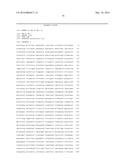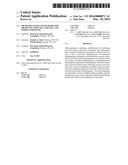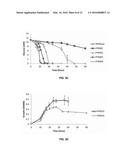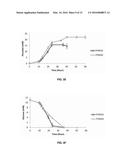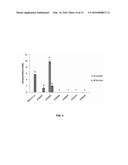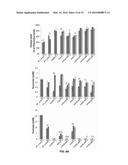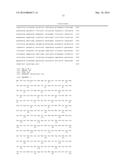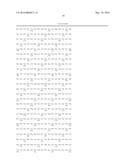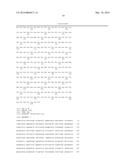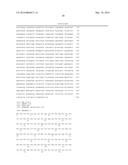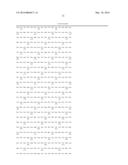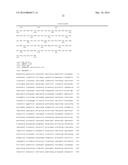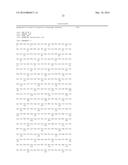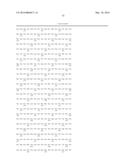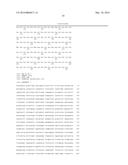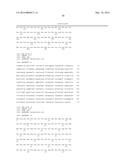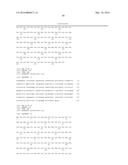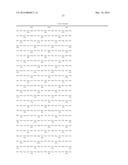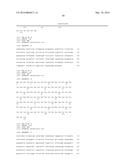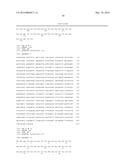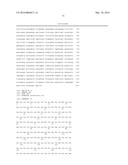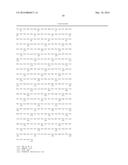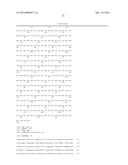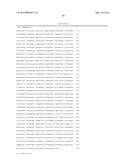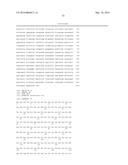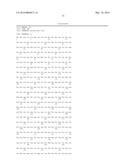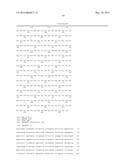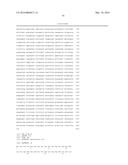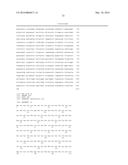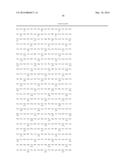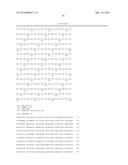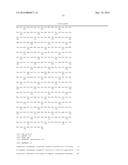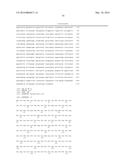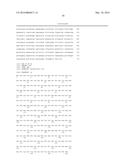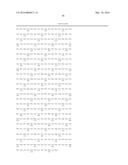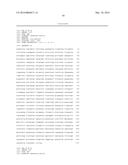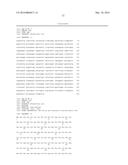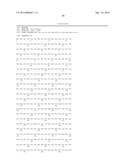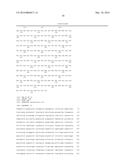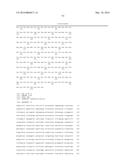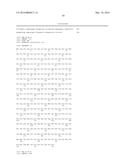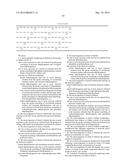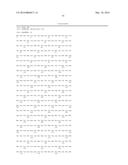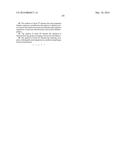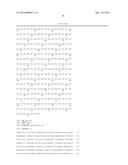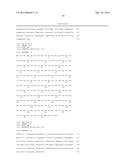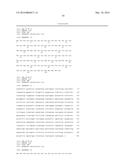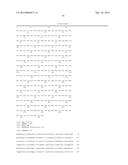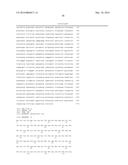Patent application title: MICROORGANISMS AND METHODS FOR PRODUCING PYRUVATE, ETHANOL, AND OTHER COMPOUNDS
Inventors:
Jennifer L. Reed (Madison, WI, US)
Xiaolin Zhang (Newark, DE, US)
Assignees:
Wisconsin Alumni Research Foundation
IPC8 Class: AC12P740FI
USPC Class:
435136
Class name: Micro-organism, tissue cell culture or enzyme using process to synthesize a desired chemical compound or composition preparing oxygen-containing organic compound containing a carboxyl group
Publication date: 2016-03-10
Patent application number: 20160068871
Abstract:
Microorganisms comprising modifications for producing pyruvate, ethanol,
and other compounds. The microorganisms comprise modifications that
reduce or ablate activity of one or more of pyruvate dehydrogenase,
2-oxoglutarate dehydrogenase, phosphate acetyltransferase, acetate
kinase, pyruvate oxidase, lactate dehydrogenase, cytochrome terminal
oxidase, succinate dehydrogenase, 6-phosphogluconate dehydrogenase,
glutamate dehydrogenase, pyruvate formate lyase, pyruvate formate lyase
activating enzyme, and isocitrate lyase. The microorganisms optionally
comprise modifications that enhance expression or activity of pyruvate
decarboxylase and alcohol dehydrogenase. The microorganisms are
optionally evolved in defined media to enhance specific production of one
or more compounds. Methods of producing compounds with the microorganisms
are provided.Claims:
1. A microorganism comprising modifications that reduce or ablate
activity of: one or more enzymes in a first set selected from the group
consisting of pyruvate dehydrogenase and 2-oxoglutarate dehydrogenase;
one or more enzymes in a second set selected from the group consisting of
phosphate acetyltransferase, acetate kinase, and pyruvate oxidase; and
enzymes in a third set comprising: lactate dehydrogenase and one or more
enzymes selected from the group consisting of cytochrome terminal oxidase
and succinate dehydrogenase; lactate dehydrogenase and one or more
enzymes selected from the group consisting of 6-phosphogluconate
dehydrogenase and glutamate dehydrogenase; one or more enzymes selected
from the group consisting of cytochrome terminal oxidase and succinate
dehydrogenase and one or more enzymes selected from the group consisting
of 6-phosphogluconate dehydrogenase and glutamate dehydrogenase; or
lactate dehydrogenase, one or more enzymes selected from the group
consisting of cytochrome terminal oxidase and succinate dehydrogenase,
and one or more enzymes selected from the group consisting of
6-phosphogluconate dehydrogenase and glutamate dehydrogenase.
2. The microorganism of claim 1 wherein the one or more enzymes in the first set are selected from pyruvate dehydrogenase.
3. The microorganism of claim 1 wherein the one or more enzymes in the second set are selected from the group consisting of phosphate acetyltransferase and pyruvate oxidase.
4. The microorganism of claim 1 wherein: the one or more enzymes in the first set are selected from pyruvate dehydrogenase; and the one or more enzymes in the second set are selected from the group consisting of phosphate acetyltransferase and pyruvate oxidase.
5. The microorganism of claim 1 wherein the enzymes in the third set comprise: lactate dehydrogenase and cytochrome terminal oxidase; lactate dehydrogenase and one or more enzymes selected from the group consisting of 6-phosphogluconate dehydrogenase and glutamate dehydrogenase; or succinate dehydrogenase and 6-phosphogluconate dehydrogenase.
6. The microorganism of claim 1 wherein: the one or more enzymes in the first set are selected from pyruvate dehydrogenase; the one or more enzymes in the second set are selected from phosphate acetyltransferase; and the enzymes in the third set comprise: lactate dehydrogenase and one or more enzymes selected from the group consisting of cytochrome terminal oxidase and succinate dehydrogenase; lactate dehydrogenase and one or more enzymes selected from the group consisting of 6-phosphogluconate dehydrogenase and glutamate dehydrogenase.
7. The microorganism of claim 6 wherein the enzymes in the third set comprise: lactate dehydrogenase and cytochrome terminal oxidase; or lactate dehydrogenase and one or more enzymes selected from the group consisting of 6-phosphogluconate dehydrogenase and glutamate dehydrogenase.
8. The microorganism of claim 1 wherein: the one or more enzymes in the first set are selected from pyruvate dehydrogenase; the one or more enzymes in the second set are selected from pyruvate oxidase; and the enzymes in the third set comprise one or more enzymes selected from the group consisting of cytochrome terminal oxidase and succinate dehydrogenase and one or more enzymes selected from the group consisting of 6-phosphogluconate dehydrogenase and glutamate dehydrogenase.
11. The microorganism of claim 1 further comprising a modification that reduces or ablates activity of an enzyme selected from the group consisting of pyruvate formate lyase and pyruvate formate lyase activating enzyme.
12. The microorganism of claim 1 further comprising a modification that enhances expression of pyruvate decarboxylase and alcohol dehydrogenase.
13. The microorganism of claim 1 wherein the microorganism is a bacterium or a yeast.
14. The microorganism of claim 1 wherein the microorganism is a bacterium.
15. An evolved microorganism produced by sequentially culturing a microorganism as recited in claim 1 in media comprising decreasing concentrations of acetate.
16. The microorganism of claim 15 wherein the concentrations of acetate in the media range from about 0.1 mg/L acetate to about 3 g/L acetate.
17. A method of producing a chemical comprising culturing a microorganism as recited in claim 1.
18. The method of claim 17 wherein the microorganism further comprises a modification that reduces or ablates activity of pyruvate formate lyase and a modification that enhances expression of pyruvate decarboxylase and alcohol dehydrogenase.
19. The method of claim 17 wherein the chemical is selected from the group consisting of pyruvate and ethanol.
20. The method of claim 17 wherein the culturing comprises culturing the microorganism in a medium comprising a biomass hydrolysate.
Description:
BACKGROUND
[0002] Over the past decade a number of chemical companies have begun to develop infrastructures for the production of compounds using bio-based processes. Considerable progress has been reported toward new processes for producing commodity chemicals such as ethanol, lactic acid, 1,3-propanediol, and adipic acid. In addition, advances have been made in the genetic engineering of microbes for higher value specialty compounds such as acetate, polyketides, and carotenoids.
[0003] Pyruvate is a starting material for synthesizing a variety of biofuels and chemicals. Industrially, pyruvate is produced via dehydration and decarboxylation of calcium tartrate, a byproduct of the wine industry. This process involves toxic solvents and is energy intensive with an estimated production cost of $8,650 per ton of pyruvate. Microbial pyruvate production is based primarily upon two microorganisms, a multi-vitamin auxotroph of the yeast T. glabrata and a lipoic auxotroph of E. coli containing an F1ATPase mutation. The estimated cost of pyruvate production via microbial fermentation with such strains is estimated to be $1,255 per ton of pyruvate, an 85% savings. Increasing the yield of pyruvate would increase the savings even further.
[0004] Ethanol is mainly of interest as a petrol additive, or substitute, because ethanol-blended fuel produces a cleaner, more complete combustion that reduces greenhouse gas and toxic emissions. The production of ethanol in the US has increased tremendously in recent years, and demand is projected to increase even further. As a consequence of the surge in demand for biofuels, ethanol-producing microorganisms are of considerable interest due to their potential for the production of bioethanol. To keep in step with the growing demand for biofuels, the engineering of new strains of fermentative microorganisms that can efficiently produce ethanol will be required.
[0005] There is a need for microorganisms that efficiently produce pyruvate, ethanol, or other commodity chemicals.
SUMMARY OF THE INVENTION
[0006] The present invention addresses the aforementioned needs by providing microorganisms with increased production of pyruvate, ethanol, or other commodity chemicals. Methods of producing commodity chemicals with the microorganisms described herein are also provided.
[0007] One aspect of the invention is a microorganism comprising modifications that reduce or ablate activity of one or more enzymes in a first set, one or more enzymes in a second set, and enzymes in a third set. The enzymes in the first set are selected from the group consisting of pyruvate dehydrogenase and 2-oxoglutarate dehydrogenase. The enzymes in the second set are selected from the group consisting of phosphate acetyltransferase, acetate kinase, and pyruvate oxidase. The enzymes in the third set comprise lactate dehydrogenase and one or more enzymes selected from the group consisting of cytochrome terminal oxidase and succinate dehydrogenase; lactate dehydrogenase and one or more enzymes selected from the group consisting of 6-phosphogluconate dehydrogenase and glutamate dehydrogenase; one or more enzymes selected from the group consisting of cytochrome terminal oxidase and succinate dehydrogenase and one or more enzymes selected from the group consisting of 6-phosphogluconate dehydrogenase and glutamate dehydrogenase; or lactate dehydrogenase, one or more enzymes selected from the group consisting of cytochrome terminal oxidase and succinate dehydrogenase, and one or more enzymes selected from the group consisting of 6-phosphogluconate dehydrogenase and glutamate dehydrogenase.
[0008] In some versions, the one or more enzymes in the first set are selected from pyruvate dehydrogenase.
[0009] In some versions, the one or more enzymes in the second set are selected from the group consisting of phosphate acetyltransferase and pyruvate oxidase.
[0010] In some versions, the enzymes in the third set comprise lactate dehydrogenase and cytochrome terminal oxidase, lactate dehydrogenase and one or more enzymes selected from the group consisting of 6-phosphogluconate dehydrogenase and glutamate dehydrogenase, or succinate dehydrogenase and 6-phosphogluconate dehydrogenase.
[0011] In some versions, the one or more enzymes in the first set are selected from pyruvate dehydrogenase, the one or more enzymes in the second set are selected from phosphate acetyltransferase, and the enzymes in the third set comprise lactate dehydrogenase and one or more enzymes selected from the group consisting of cytochrome terminal oxidase and succinate dehydrogenase, or lactate dehydrogenase and one or more enzymes selected from the group consisting of 6-phosphogluconate dehydrogenase and glutamate dehydrogenase.
[0012] In some versions, the one or more enzymes in the first set are selected from pyruvate dehydrogenase, the one or more enzymes in the second set are selected from phosphate acetyltransferase, and the enzymes in the third set comprise lactate dehydrogenase and cytochrome terminal oxidase, or lactate dehydrogenase and one or more enzymes selected from the group consisting of 6-phosphogluconate dehydrogenase and glutamate dehydrogenase.
[0013] In some versions, the one or more enzymes in the first set are selected from pyruvate dehydrogenase, the one or more enzymes in the second set are selected from pyruvate oxidase, and the enzymes in the third set comprise one or more enzymes selected from the group consisting of cytochrome terminal oxidase and succinate dehydrogenase and one or more enzymes selected from the group consisting of 6-phosphogluconate dehydrogenase and glutamate dehydrogenase.
[0014] In some versions, the microorganism further comprises a modification that reduces or ablates activity of an enzyme selected from the group consisting of pyruvate formate lyase and pyruvate formate lyase activating enzyme.
[0015] In some versions, the microorganism further comprises a modification that enhances expression of pyruvate decarboxylase and alcohol dehydrogenase.
[0016] In some versions, the microorganism is a bacterium or a yeast.
[0017] In some versions, an evolved microorganism is produced by sequentially culturing any microorganism described above or elsewhere herein in media comprising decreasing concentrations of a compound such as acetate, ethanol, or another compound. The media each preferably comprise approximately a same amount of total consumable carbon. In some versions, the microorganism is cultured in media comprising decreasing concentrations of acetate. The concentrations of acetate in the media may range from about 0.1 mg/L acetate to about 3 g/L acetate.
[0018] Another aspect of the invention is a method of producing a chemical. The method comprises culturing any microorganism described above or elsewhere herein. The chemical may be selected from the group consisting of pyruvate and ethanol. The culturing may comprise culturing the microorganism in a medium comprising a biomass hydrolysate.
[0019] The objects and advantages of the invention will appear more fully from the following detailed description of the preferred embodiment of the invention made in conjunction with the accompanying drawings.
BRIEF DESCRIPTION OF THE DRAWINGS
[0020] FIG. 1 is a schema showing the central metabolic pathway of wild-type E. coli. Genes associated with each reaction in the central metabolic network are shown and flux values are labeled. The metabolic flux distribution for the wild-type strain under aerobic conditions was predicted by flux balance analysis. Glucose uptake rate was set at 10 mmol/gDW/hour. The dashed line represents the ethanol synthesis pathway (PET operon) from Zymomonas mobilis.
[0021] FIGS. 2A-2D are schemas showing the central metabolic pathway of mutant E. coli strains designed for pyruvate production. Genes associated with each reaction in the central metabolic network are shown and flux values are labeled. The reactions marked by bars correspond to the deletion targets calculated computationally. The labeled metabolic flux distribution for each strain was predicted by flux balance analysis. Glucose uptake rate was set at 10 mmol/gDW/hour. Oxygen uptake was unlimited for the strains shown in FIGS. 2B-2D, but limited to 3 mmol/gDW/hour for the strain shown in FIG. 2A. FIG. 2A: Strain designed as ΔaceE, ΔcyoA, ΔcydB, Δpta, ΔeutI, ΔidhA, and Δdld. FIG. 2B: Strain designed as ΔlpdA, Δgnd, ΔsdhA, ΔpoxB, ΔpflB, ΔpflD, ΔtdcE, and ΔpurU. FIG. 2C: Strain designed as ΔaceE, ΔgdhA, ΔpoxB, ΔldhA, Δdld, ΔatpE, ΔpflB, ΔpflD, and ΔtdcE. FIG. 2D: Strain designed as designed as ΔaceE, Δgnd, ΔpoxB, ΔldhA, Δdld, ΔatpE, ΔpflB, ΔpflD, and ΔtdcE.
[0022] FIGS. 3A-3F show growth (FIGS. 3A and 3D), pyruvate production (FIGS. 3B and 3E), and glucose consumption (FIGS. 3C and 3F) of wild-type (BW25113) and mutant E. coli strains. Cells were grown in M9 minimal medium containing glucose and acetate. (See Table 2 for media details).
[0023] FIG. 4 shows (a) lactate and (b) acetate secretion for parent (BW25113) and mutant E. coli strains under aerobic conditions in shake flasks. The shown concentrations are the maximum acid concentrations observed over 60 hours during growth in M9 minimal medium supplemented with glucose and acetate. (See Table 2 for media details). Acetate accumulated in BW25113, PYR001 and PYR002 cultures and lactate accumulated in PYR002 cultures. * indicates concentrations of acetate and lactate that were below the detection level of the HPLC.
[0024] FIG. 5 shows growth, glucose consumption, and pyruvate production by PYR004 in bioreactors. Panels (A) and (B) show batch fermentation in minimal salts medium containing 30 g/L glucose with 1.5 g/L acetate (panel A) or 3 g/L acetate (panel B). Panel (C) shows fed-batch fermentation operated in minimal salts medium initially containing 30 g/L glucose and 1.5 g/L acetate. In the fed-batch operation, an additional 7.5 mL of 200 g/L acetate was added at 8.5 hours, indicated by the black arrow, for a total acetate concentration of 3.0 g/L. Experiments were performed in duplicate. Diamond: OD 600. Triangle: glucose concentration. Square: pyruvate concentration.
[0025] FIG. 6 shows growth, glucose consumption and pyruvate production by PYR020 in bioreactors. Panels (A) and (B) show batch fermentation in minimal salts medium containing 30 g/L glucose with 0.9 g/L acetate (Panel A) or 1.5 g/L acetate (Panel B). Panel (C) shows fed-batch fermentation operated in minimal salts medium initially containing 30 g/L glucose and 0.6 g/L acetate. In the fed-batch operation, an additional 1.5 mL of 200 g/L acetate was added at 17 hours, indicated by the black arrow. Experiments were performed in duplicate. Diamond: OD 600. Triangle: glucose concentration. Square: pyruvate concentration.
[0026] FIG. 7 shows batch production of pyruvate in ammonia fiber expansion (AFEX)-pretreated switchgrass hydrolysate (ASGH) by strain PYR020. Cells were grown in ASGH containing 48 g/L glucose, 27 g/L xylose, and 2.6 g/L acetate. Diamond: OD 600. Square: pyruvate concentration.
[0027] FIGS. 8A-8B show product secretion from various strains under anaerobic conditions. Secretion of ethanol, succinate, and formate is shown in FIG. 8A. Secretion of acetate and lactate is shown in FIG. 8B. All experiments were performed anaerobically in hungate tubes in M9 minimal media. Columns marked "a" correspond to fermentations containing 1.98 g/L glucose and 0.02 g/L acetate. Multiple samples were taken over 48 hours, which reduced the culture volume by about 50%. Columns marked (b) correspond to fermentations in M9 medium with 1.98 g/L glucose and 0.02 g/L acetate for 24 hours, but only three samples were taken at 16, 20 and 24 hours. Columns marked (c) correspond to fermentations in M9 minimal medium with more acetate (0.1 g/L) and 1.9 g/L glucose for 24 hours, with only three samples. Error bars represent standard errors among three replicates. Percent of theoretical yield was calculated as the ethanol concentration divided by the theoretical maximum production of ethanol (2 mmol of ethanol per mmol of glucose plus 0.67 mmol of ethanol per mmol of acetate). t-tests were used to determine significant differences in product concentrations between different fermentations (a, b, and c columns) where * and ** indicates the p-value is between 0.01 and 0.05, or less than 0.01, respectively.
DETAILED DESCRIPTION OF THE INVENTION
[0028] One aspect of the invention is directed to microorganisms comprising modifications that reduce or ablate the activity of gene products of one or more genes. Such a modification that that reduces or ablates the activity of gene products of one or more genes is referred to herein as a "functional deletion" of the gene product. "Gene product" refers to a protein or polypeptide encoded and produced by a particular gene. "Gene" refers to a nucleic acid sequence capable of producing a gene product and may include such genetic elements as a coding sequence together with any other genetic elements required for transcription and/or translation of the coding sequence. Such genetic elements may include a promoter, an enhancer, and/or a ribosome binding site (RBS), among others.
[0029] One of ordinary skill in the art will appreciate that there are many well-known ways to functionally delete a gene product. For example, functional deletion can be accomplished by introducing one or more genetic modifications. As used herein, "genetic modifications" refer to any differences in the nucleic acid composition of a cell, whether in the cell's native chromosome or in endogenous or exogenous non-chromosomal plasmids harbored within the cell. Examples of genetic modifications that may result in a functionally deleted gene product include but are not limited to mutations such as substitutions, partial or complete deletions, insertions, or other variations to a coding sequence or a sequence controlling the transcription or translation of a coding sequence; placing a coding sequence under the control of a less active promoter; blocking transcription of the gene with a trans-acting DNA binding protein such as a TAL effector or CRISPR guided Cas9; and expressing ribozymes or antisense sequences that target the mRNA of the gene of interest, etc. In some versions, a gene or coding sequence can be replaced with a selection marker or screenable marker. Various methods for introducing the genetic modifications described above are well known in the art and include homologous recombination, among other mechanisms. See, e.g., Green et al., Molecular Cloning: A laboratory manual, 4th ed., Cold Spring Harbor Laboratory Press (2012) and Sambrook et al., Molecular Cloning: A Laboratory Manual, 3rd ed., Cold Spring Harbor Laboratory Press (2001). Various other genetic modifications that functionally delete a gene product are described in the examples below. Functional deletion can also be accomplished by inhibiting the activity of the gene product, for example, by chemically inhibiting a gene product with a small molecule inhibitor, by expressing a protein that interferes with the activity of the gene product, or by other means.
[0030] In certain versions of the invention, the functionally deleted gene product may have less than about 95%, less than about 90%, less than about 85%, less than about 80%, less than about 75%, less than about 70%, less than about 65%, less than about 60%, less than about 55%, less than about 50%, less than about 45%, less than about 40%, less than about 35%, less than about 30%, less than about 25%, less than about 20%, less than about 15%, less than about 10%, less than about 5%, less than about 1%, or about 0% of the activity of the non-functionally deleted gene product.
[0031] In certain versions of the invention, a cell with a functionally deleted gene product may have less than about 95%, less than about 90%, less than about 85%, less than about 80%, less than about 75%, less than about 70%, less than about 65%, less than about 60%, less than about 55%, less than about 50%, less than about 45%, less than about 40%, less than about 35%, less than about 30%, less than about 25%, less than about 20%, less than about 15%, less than about 10%, less than about 5%, less than about 1%, or about 0% of the activity of the gene product compared to a cell with the non-functionally deleted gene product.
[0032] In certain versions of the invention, the functionally deleted gene product may be expressed at an amount less than about 95%, less than about 90%, less than about 85%, less than about 80%, less than about 75%, less than about 70%, less than about 65%, less than about 60%, less than about 55%, less than about 50%, less than about 45%, less than about 40%, less than about 35%, less than about 30%, less than about 25%, less than about 20%, less than about 15%, less than about 10%, less than about 5%, less than about 1%, or about 0% of the amount of the non-functionally deleted gene product.
[0033] In certain versions of the invention, the functionally deleted gene product may result from a genetic modification in which at least 1, at least 2, at least 3, at least 4, at least 5, at least 10, at least 20, at least 30, at least 40, at least 50, or more nonsynonymous substitutions are present in the gene or coding sequence of the gene product.
[0034] In certain versions of the invention, the functionally deleted gene product may result from a genetic modification in which at least 1, at least 2, at least 3, at least 4, at least 5, at least 10, at least 20, at least 30, at least 40, at least 50, or more bases are inserted in the gene or coding sequence of the gene product.
[0035] In certain versions of the invention, the functionally deleted gene product may result from a genetic modification in which at least about 1%, at least about 5%, at least about 10%, at least about 15%, at least about 20%, at least about 25%, at least about 30%, at least about 35%, at least about 40%, at least about 50%, at least about 55%, at least about 60%, at least about 65%, at least about 70%, at least about 75%, at least about 80%, at least about 85%, at least about 90%, at least about 95%, or about 100% of the gene product's gene or coding sequence is deleted or mutated.
[0036] In certain versions of the invention, the functionally deleted gene product may result from a genetic modification in which at least about 1%, at least about 5%, at least about 10%, at least about 15%, at least about 20%, at least about 25%, at least about 30%, at least about 35%, at least about 40%, at least about 50%, at least about 55%, at least about 60%, at least about 65%, at least about 70%, at least about 75%, at least about 80%, at least about 85%, at least about 90%, at least about 95%, or about 100% of a promoter driving expression of the gene product is deleted or mutated.
[0037] In certain versions of the invention, the functionally deleted gene product may result from a genetic modification in which at least about 1%, at least about 5%, at least about 10%, at least about 15%, at least about 20%, at least about 25%, at least about 30%, at least about 35%, at least about 40%, at least about 50%, at least about 55%, at least about 60%, at least about 65%, at least about 70%, at least about 75%, at least about 80%, at least about 85%, at least about 90%, at least about 95%, or about 100% of an enhancer controlling transcription of the gene product's gene is deleted or mutated.
[0038] In certain versions of the invention, the functionally deleted gene product may result from a genetic modification in which at least about 1%, at least about 5%, at least about 10%, at least about 15%, at least about 20%, at least about 25%, at least about 30%, at least about 35%, at least about 40%, at least about 50%, at least about 55%, at least about 60%, at least about 65%, at least about 70%, at least about 75%, at least about 80%, at least about 85%, at least about 90%, at least about 95%, or about 100% of a sequence controlling translation of gene product's mRNA is deleted or mutated.
[0039] In certain versions of the invention, the decreased activity or expression of the functionally deleted gene product is determined with respect to the activity or expression of the gene product in its unaltered state as found in nature. In certain versions of the invention, the decreased activity or expression of the functionally deleted gene product is determined with respect to the activity or expression of the gene product in its form in a corresponding microorganism. In certain versions, the genetic modifications giving rise to a functionally deleted gene product are determined with respect to the gene or coding sequence in its unaltered state as found in nature. In certain versions, the genetic modifications giving rise to a functionally deleted gene product are determined with respect to the gene or coding sequence in its form in a corresponding microorganism.
[0040] As used herein, "corresponding microorganism" refers to a microorganism of the same species having the same or substantially same genetic and proteomic composition as a microorganism of the invention, with the exception of genetic and proteomic differences resulting from the modifications described herein for the microorganisms of the invention.
[0041] Some versions of the invention comprise microorganisms configured for increased production of pyruvate. For the production of pyruvate, at least three sets of enzymes are functionally deleted in the microorganism. Enzymes in a first set are selected from the group consisting of pyruvate dehydrogenase and 2-oxoglutarate dehydrogenase. Enzymes in a second set are selected from the group consisting of phosphate acetyltransferase, acetate kinase, and pyruvate oxidase. Enzymes in a third set comprise lactate dehydrogenase and one or more enzymes selected from the group consisting of cytochrome terminal oxidase and succinate dehydrogenase; lactate dehydrogenase and one or more enzymes selected from the group consisting of 6-phosphogluconate dehydrogenase and glutamate dehydrogenase; one or more enzymes selected from the group consisting of cytochrome terminal oxidase and succinate dehydrogenase and one or more enzymes selected from the group consisting of 6-phosphogluconate dehydrogenase and glutamate dehydrogenase; or lactate dehydrogenase, one or more enzymes selected from the group consisting of cytochrome terminal oxidase and succinate dehydrogenase, and one or more enzymes selected from the group consisting of 6-phosphogluconate dehydrogenase and glutamate dehydrogenase. Deletion of any gene or any other modification that reduces or ablates the activity of these enzymes or reduces or ablates flux of metabolites through these enzymes is encompassed by the present invention.
[0042] Pyruvate dehydrogenases convert pyruvate into acetyl Co-A. Pyruvate dehydrogenases include enzymes classified under any or all of EC 1.2.4.1, EC 2.3.1.12, and EC 1.8.1.4. An exemplary pyruvate dehydrogenase is the pyruvate dehydrogenase of E. coli, which is a multi-subunit complex comprising AceE (SEQ ID NO:2) encoded by aceE (SEQ ID NO:1), AceF (SEQ ID NO:4) encoded by aceF (SEQ ID NO:3), and Lpd (SEQ ID NO:6) encoded by lpdA (SEQ ID NO:5). AceE has activity classified under EC 1.2.4.1. AceF has activity classified under 2.3.1.12. Lpd has activity classified under 1.8.1.4. Other pyruvate dehydrogenases include homologs of the E. coli pyruvate dehydrogenase.
[0043] 2-Oxoglutarate dehydrogenases convert α-ketoglutarate, NAD.sup.+, and CoA to succinyl CoA, CO2, and NADH. 2-Oxoglutarate dehydrogenases include enzymes classified under any one or all of EC 1.8.1.4, EC 1.2.4.2, and EC 2.3.1.61. An exemplary 2-oxoglutarate dehydrogenase is the 2-oxoglutarate dehydrogenase of E. coli, which is a multi-subunit complex comprising Lpd (SEQ ID NO:6) encoded by lpdA (SEQ ID NO:5), SucA (SEQ ID NO:8) encoded by sucA (SEQ ID NO:7), and SucB (SEQ ID NO:10) encoded by sucB (SEQ ID NO:9). Lpd has activity classified under EC 1.8.1.4. SucA has activity classified under EC 1.2.4.2. SucB has activity classified under EC 2.3.1.61. Other 2-oxoglutarate dehydrogenases include homologs of the E. coli 2-oxoglutarate dehydrogenase. Functionally deleting 2-oxoglutarate dehydrogenase may be performed as an alternative to or in addition to functionally deleting pyruvate dehydrogenase.
[0044] Phosphate acetyltransferases convert acetyl-CoA and phosphate to CoA and acetyl phosphate. Phosphate acetyltransferases include enzymes classified under EC 2.3.1.8. An exemplary phosphate acetyltransferase is the phosphate acetyltransferase of E. coli (SEQ ID NO:12), which is encoded by pta (SEQ ID NO:11). Other phosphate acetyltransferases include homologs of the E. coli phosphate acetyltransferase.
[0045] Acetate kinases convert acetate and ATP to acetyl phosphate. Acetate kinases include enzymes classified under EC 2.7.2.-, such as EC 2.7.2.1. An exemplary acetate kinase is the acetate kinase A of E. coli (SEQ ID NO:14), which is encoded by ackA (SEQ ID NO:13). Other acetate kinases include homologs of the E. coli acetate kinase A. Functionally deleting acetate kinase may be performed as an alternative to or in addition to functionally deleting phosphate acetyltransferase. In some versions, the ackA gene in the microorganism is structurally and functionally intact such that the acetate kinase in the cells is fully expressed and fully functional.
[0046] Pyruvate oxidases convert pyruvate, phosphate, and O2 to acetyl phosphate, CO2, and H2O2. Pyruvate oxidases include enzymes classified under EC 1.2.3.3. An exemplary pyruvate oxidase is the pyruvate oxidase of E. coli (SEQ ID NO:16), which is encoded by poxB (SEQ ID NO:15). Other pyruvate oxidases include homologs of the E. coli pyruvate oxidase.
[0047] Lactate dehydrogenases convert pyruvate to lactate and vice versa. Lactate dehydrogenases include enzymes classified under any or all of EC 1.1.1.27 and EC 1.1.1.28. An exemplary lactate dehydrogenase is the LdhA of E. coli (SEQ ID NO:18), which is encoded by ldhA (SEQ ID NO:17). Other lactate dehydrogenases include homologs of the E. coli LdhA.
[0048] Cytochrome oxidases transfer electrons in the respiratory chain from donors to an acceptor. Cytochrome oxidases include enzymes classified under any or all of EC 1.9.3.1 and EC 1.10.3.-. Exemplary cytochrome oxidases suitable for functionally deleting in the present invention include cytochrome terminal oxidases, such as Family A cytochrome terminal oxidases. An exemplary Family A cytochrome terminal oxidase in E. coli is the cytochrome bo terminal oxidase, which is a multi-subunit complex comprising subunit I (SEQ ID NO:22) encoded by cyoB (SEQ ID NO:21), subunit II (SEQ ID NO:20) encoded by cyoA (SEQ ID NO:19), subunit III (SEQ ID NO:24) encoded by cyoC (SEQ ID NO:23), and subunit IV (SEQ ID NO:26) encoded by cyoD (SEQ ID NO:25). Subunits I-IV have activity classified under EC 1.10.3.-. A fifth gene of the cyo operon, cyoE (SEQ ID NO:27), encodes a heme 0 synthase (SEQ ID NO:28) that is essential for correct assembly of the complex and can be functionally deleted to effectively functionally delete the cytochrome bo terminal oxidase itself. Other cytochrome oxidases include homologs of the E. coli cytochrome bo terminal oxidase.
[0049] Succinate dehydrogenases catalyze the oxidation of succinate to fumarate with the reduction of ubiquinone to ubiquinol. Succinate dehydrogenases include enzymes classified under EC 1.3.5.1. An exemplary succinate dehydrogenase is the succinate dehydrogenase of E. coli, which is a multi-subunit complex comprising SdhA (SEQ ID NO:30) encoded by sdhA (SEQ ID NO:29), SdhB (SEQ ID NO:32) encoded by sdhB (SEQ ID NO:31), SdhC (SEQ ID NO:34) encoded by sdhC (SEQ ID NO:33), and SdhD (SEQ ID NO:36) encoded by sdhD (SEQ ID NO:35). Other succinate dehydrogenases include homologs of the E. coli succinate dehydrogenases.
[0050] 6-Phosphogluconate dehydrogenases catalyze the decarboxylating reduction of 6-phosphogluconate into ribulose 5-phosphate in the presence of NADP.sup.+. Phosphogluconate dehydrogenases include enzymes classified under EC 1.1.1.44. An exemplary 6-phosphogluconate dehydrogenase is the Gnd of E. coli (SEQ ID NO:38), which is encoded by gnd (SEQ ID NO:37). Other 6-phosphogluconate dehydrogenases include homologs of the E. coli Gnd.
[0051] Glutamate dehydrogenases convert glutamate to α-ketoglutarate and vice versa. Glutamate dehydrogenases include enzymes classified under EC 1.4.1.4. An exemplary glutamate dehydrogenase is the GdhA of E. coli (SEQ ID NO:40), which is encoded by gdhA (SEQ ID NO:39). Other glutamate dehydrogenases include homologs of the E. coli GdhA.
[0052] In some versions of the invention, the microorganisms having the above-referenced sets of enzymes functionally deleted are evolved for enhanced production of pyruvate. The microorganisms are evolved by sequentially culturing microorganisms in media comprising decreasing concentrations of acetate. This process preferably involves sequentially culturing the microorganisms in aliquots of media, with sequential aliquots comprising decreasing concentrations of acetate. The concentrations of acetate in the media are preferably within a range of from about 0 mg/L to about 80 g/L, such as from about 0.001 mg/L to about 80 g/L, about 0.01 mg/L to about 50 g/L, about 0.1 mg/L to about 10 g/L, or about 0.1 mg/L to about 3 g/L. In some versions, the starting acetate concentration in the medium is within a range of from about 90 mg/L to about 80 g/L and sequentially reduces to a concentration with a range of from about 0 mg/L to about 90 mg/L. In some versions, the starting acetate concentration in the medium is within a range of from about 90 mg/L to about 80 g/L and sequentially reduces to a concentration with a range of from about 0.001 mg/L to about 90 mg/L. In some versions, the starting acetate concentration in the medium is within a range of from about 90 mg/L to about 1 g/L and sequentially reduces to a concentration with a range of from about 0.1 mg/L to about 90 mg/L. In some versions, the starting acetate concentration in the medium is within a range of from about 90 mg/L to about 500 g/L and sequentially reduces to a concentration with a range of from about 1 mg/L to about 90 mg/L.
[0053] The initial amount of total consumable carbon in the various media used in the sequential culturing is preferably approximately the same among the media. The initial amount of total consumable carbon preferably ranges from about 1 g/L to about 100 g/L, but may be higher or lower. Beyond the acetate, the balance of consumable carbon preferably comprises a sugar such as glucose or other carbohydrates or carbon sources known in the art. The sequential culturing may comprise passing the microorganism through the media in at least about 2, 3, 4, 5, 7, 10, 15, or 20 passages and/or up to about 5, 10, 15, 20, 30, 50 or more passages.
[0054] Some versions of the invention comprise microorganisms configured for increased production of ethanol. These microorganisms have the enzymes described above for producing pyruvate functionally deleted but additionally have pyruvate formate lyase functionally deleted.
[0055] Pyruvate formate lyases catalyze the reversible conversion of pyruvate and coenzyme-A into formate and acetyl-CoA. Pyruvate formate lyases include enzymes classified under EC 2.3.1.54. An exemplary pyruvate formate lyase is the PFL of E. coli (SEQ ID NO:42), which is encoded by pflB (SEQ ID NO:41). Other pyruvate formate lyases include homologs of the E. coli PFL.
[0056] In some versions of the invention, a pyruvate formate lyase activating enzyme in the recombinant microorganism is functionally deleted. Pyruvate formate lyase activating enzymes include enzymes classified under EC 1.97.1.4. Pyruvate formate lyase activating enzymes activate pyruvate formate lyases. Functionally deleting a pyruvate formate lyase activating enzyme constitutes a way to functionally delete a pyruvate formate lyase. An exemplary pyruvate formate lyase activating enzyme is the PFL activase of E. coli (SEQ ID NO:44), which is encoded by pflA (SEQ ID NO:43). Other pyruvate formate lyase activating enzymes include homologs of the E. coli PFL activase.
[0057] The enzymes described herein can be functionally deleted by mutating or disrupting expression of any one or all of the genes encoding the enzyme or its substituent subunits. Accordingly, the pyruvate dehydrogenase can be functionally deleted by mutating or disrupting expression of any one or more of aceE, aceF, and lpdA or homologs thereof. The 2-oxoglutarate dehydrogenase can be functionally deleted by mutating or disrupting expression of any one or more of lpdA, sucA, and sucB or homologs thereof. The phosphate acetyltransferase can be functionally deleted by mutating or disrupting expression of pta or homologs thereof. The acetate kinase can be functionally deleted by mutating or disrupting expression of ackA or homologs thereof. The pyruvate oxidase can be functionally deleted by mutating or disrupting expression of poxB or homologs thereof. The lactate dehydrogenase can be functionally deleted by mutating or disrupting expression of ldhA or homologs thereof. The cytochrome oxidase can be functionally deleted by mutating or disrupting expression of any one or more of cyoA, cyoB, cyoC, cyoD and cyoE or homologs thereof. The succinate dehydrogenase can be functionally deleted by mutating or disrupting expression of any one or more of sdhA, sdhB, sdhC, and sdhD or homologs thereof. The 6-phosphogluconate dehydrogenase can be functionally deleted by mutating or disrupting expression of gnd or homologs thereof. The glutamate dehydrogenase can be functionally deleted by mutating or disrupting expression of gdhA or homologs thereof. The pyruvate formate lyase can be functionally deleted by mutating or disrupting expression of pflB and pflA or homologs thereof.
[0058] The microorganisms of the invention may also be modified to increase expression of one or more enzymes. Modifying the microorganism to increase expression of an enzyme can be performed using any methods currently known in the art or discovered in the future. Examples include genetically modifying the microorganism and culturing the microorganism in the presence of factors that increase expression of the enzyme. Suitable methods for genetic modification include but are not limited to placing the coding sequence under the control of a more active promoter, increasing the copy number of the gene, introducing a translational enhancer on the gene (see, e.g., Olins et al. Journal of Biological Chemistry, 1989, 264(29):16973-16976), and/or increasing expression of transactivators. Increasing the copy number of the gene can be performed by introducing additional copies of the gene to the microorganism, i.e., by incorporating one or more exogenous copies of the native gene or a heterologous homolog thereof into the microbial genome, by introducing such copies to the microorganism on a plasmid or other vector, or by other means. "Exogenous" used in reference to a genetic element means the genetic element is introduced to a microorganism by genetic modification. "Heterologous" used in reference to a genetic element means that the genetic element is derived from a different species. A promoter that controls a particular coding sequence is herein described as being "operationally connected" to the coding sequence.
[0059] The microorganisms of the invention may include at least one recombinant nucleic acid configured to express or overexpress a particular enzyme. "Recombinant" as used herein with reference to a nucleic acid molecule or polypeptide is one that has a sequence that is not naturally occurring, has a sequence that is made by an artificial combination of two otherwise separated segments of sequence, or both. This artificial combination can be achieved, for example, by chemical synthesis or by the artificial manipulation of isolated segments of nucleic acid molecules or polypeptides, such as genetic engineering techniques. "Recombinant" is also used to describe nucleic acid molecules that have been artificially modified but contain the same regulatory sequences and coding regions that are found in the organism from which the nucleic acid was isolated. A recombinant cell or microorganism is one that contains a recombinant nucleic acid molecule or polypeptide. "Overexpress" as used herein means that a particular gene product is produced at a higher level in one cell, such as a recombinant cell, than in a corresponding cell. For example, a microorganism that includes a recombinant nucleic acid configured to overexpress an enzyme produces the enzyme at a greater amount than a microorganism that does not include the recombinant nucleic acid.
[0060] Exogenous, heterologous nucleic acids encoding enzymes to be expressed in the microorganism are preferably codon-optimized for the particular microorganism in which they are introduced. Codon optimization can be performed for any nucleic acid by a number of programs, including "GENEGPS"-brand expression optimization algorithm by DNA 2.0 (Menlo Park, Calif.), "GENEOPTIMIZER"-brand gene optimization software by Life Technologies (Grand Island, N.Y.), and "OPTIMUMGENE"-brand gene design system by GenScript (Piscataway, N.J.). Other codon optimization programs or services are well known and commercially available.
[0061] Microorganisms of the invention configured to increase production of ethanol may be modified to increase expression of pyruvate decarboxylase and alcohol dehydrogenase.
[0062] Pyruvate decarboxylases catalyze the decarboxylation of pyruvic acid to acetaldehyde and carbon dioxide. Pyruvate decarboxylases include enzymes classified under EC 4.1.1.1. An exemplary pyruvate decarboxylase is the PDC of Zymomonas mobilis (SEQ ID NO:46), which is encoded by pdc (SEQ ID NO:45). Other pyruvate decarboxylases include homologs of the Z. mobilis PDC.
[0063] Alcohol dehydrogenases catalyze the interconversion between alcohols and aldehydes or ketones with the reduction of nicotinamide adenine dinucleotide (NAD.sup.+ to NADH). Alcohol dehydrogenases include enzymes classified under EC 1.1.1.1. An exemplary alcohol dehydrogenase is the ADH2 of Zymomonas mobilis (SEQ ID NO:48), which is encoded by adhB (SEQ ID NO:47). Other alcohol dehydrogenases include homologs of the Z. mobilis ADH2.
[0064] Increased expression of the pyruvate decarboxylase and/or the alcohol dehydrogenase can be included in a microorganism comprising a functional deletion of any of the genes or gene products, or combinations thereof, described herein.
[0065] Isocitrate lyase, encoded by aceA in E. coli or homologs thereof, can also be functionally deleted in any of the microorganisms described herein.
[0066] Homologs include genes or gene products (including enzymes) that are derived, naturally or artificially, from a common ancestral gene or gene product. Homology is generally inferred from sequence similarity between two or more genes or gene products. Homology between genes may be inferred from sequence similarity between the products of the genes. The precise percentage of similarity between sequences that is useful in establishing homology varies with the gene or gene product at issue, but as little as 25% sequence similarity (e.g., identity) over 50, 100, 150 or more residues (nucleotides or amino acids) is routinely used to establish homology (e.g., over the full length of the two sequences to be compared). Higher levels of sequence similarity (e.g., identity), e.g., 30%, 35% 40%, 45% 50%, 55%, 60%, 65%, 70%, 75%, 80%, 85%, 90%, 95%, or 99% or more, can also be used to establish homology. Accordingly, homologs of the coding sequences, genes, or gene products described herein include coding sequences, genes, or gene products, respectively, having at least about 30%, 35%, 40%, 45%, 50%, 55%, 60%, 65%, 70%, 75%, 80%, 85%, 90%, 95%, or 99% identity to the coding sequences, genes, or gene products, respectively, described herein. In some versions, homologs of the genes described herein include genes that have gene products at least about 30%, 35%, 40%, 45%, 50%, 55%, 60%, 65%, 70%, 75%, 80%, 85%, 90%, 95%, or 99% identical to the gene products of the genes described herein. Methods for determining sequence similarity percentages (e.g., BLASTP and BLASTN using default parameters) are described herein and are generally available. The homologous gene products should demonstrate comparable activities and, if an enzyme, participate in the same or analogous pathways. "Orthologs" are genes or coding sequences thereof in different species that evolved from a common ancestral gene by speciation. Normally, orthologs retain the same or similar function in the course of evolution. As used herein "orthologs" are included in the term "homologs." Homologs also include paralogs.
[0067] For sequence comparison and homology determination, one sequence typically acts as a reference sequence to which test sequences are compared. When using a sequence comparison algorithm, test and reference sequences are input into a computer, subsequence coordinates are designated, if necessary, and sequence algorithm program parameters are designated. The sequence comparison algorithm then calculates the percent sequence identity for the test sequence(s) relative to the reference sequence based on the designated program parameters. A typical reference sequence of the invention is a nucleic acid or amino acid sequence corresponding to coding sequences, genes, or gene products described herein.
[0068] Optimal alignment of sequences for comparison can be conducted, e.g., by the local homology algorithm of Smith & Waterman, Adv. Appl. Math. 2:482 (1981), by the homology alignment algorithm of Needleman & Wunsch, J. Mol. Biol. 48:443 (1970), by the search for similarity method of Pearson & Lipman, Proc. Nat'l. Acad. Sci. USA 85:2444 (1988), by computerized implementations of these algorithms (GAP, BESTFIT, FASTA, and TFASTA in the Wisconsin Genetics Software Package, Genetics Computer Group, 575 Science Dr., Madison, Wis.), or by visual inspection (see Current Protocols in Molecular Biology, F. M. Ausubel et al., eds., Current Protocols, a joint venture between Greene Publishing Associates, Inc. and John Wiley & Sons, Inc., (supplemented through 2008)).
[0069] One example of an algorithm that is suitable for determining percent sequence identity and sequence similarity for purposes of defining homologs is the BLAST algorithm, which is described in Altschul et al., J. Mol. Biol. 215:403-410 (1990). Software for performing BLAST analyses is publicly available through the National Center for Biotechnology Information. This algorithm involves first identifying high scoring sequence pairs (HSPs) by identifying short words of length W in the query sequence, which either match or satisfy some positive-valued threshold score T when aligned with a word of the same length in a database sequence. T is referred to as the neighborhood word score threshold (Altschul et al., supra). These initial neighborhood word hits act as seeds for initiating searches to find longer HSPs containing them. The word hits are then extended in both directions along each sequence for as far as the cumulative alignment score can be increased. Cumulative scores are calculated using, for nucleotide sequences, the parameters M (reward score for a pair of matching residues; always>0) and N (penalty score for mismatching residues; always<0). For amino acid sequences, a scoring matrix is used to calculate the cumulative score. Extension of the word hits in each direction are halted when: the cumulative alignment score falls off by the quantity X from its maximum achieved value; the cumulative score goes to zero or below, due to the accumulation of one or more negative-scoring residue alignments; or the end of either sequence is reached. The BLAST algorithm parameters W, T, and X determine the sensitivity and speed of the alignment. The BLASTN program (for nucleotide sequences) uses as defaults a wordlength (W) of 11, an expectation (E) of 10, a cutoff of 100, M=5, N=-4, and a comparison of both strands. For amino acid sequences, the BLASTP program uses as defaults a wordlength (W) of 3, an expectation (E) of 10, and the BLOSUM62 scoring matrix (see Henikoff & Henikoff (1989) Proc. Natl. Acad. Sci. USA 89:10915).
[0070] In addition to calculating percent sequence identity, the BLAST algorithm also performs a statistical analysis of the similarity between two sequences (see, e.g., Karlin & Altschul, Proc. Natl. Acad. Sci. USA 90:5873-5787 (1993)). One measure of similarity provided by the BLAST algorithm is the smallest sum probability (P(N)), which provides an indication of the probability by which a match between two nucleotide or amino acid sequences would occur by chance. For example, a nucleic acid is considered similar to a reference sequence if the smallest sum probability in a comparison of the test nucleic acid to the reference nucleic acid is less than about 0.1, more preferably less than about 0.01, and most preferably less than about 0.001. The above-described techniques are useful in identifying homologous sequences for use in the methods described herein.
[0071] The terms "identical" or "percent identity", in the context of two or more nucleic acid or polypeptide sequences, refers to two or more sequences or subsequences that are the same or have a specified percentage of amino acid residues or nucleotides that are the same, when compared and aligned for maximum correspondence, as measured using one of the sequence comparison algorithms described above (or other algorithms available to persons of skill) or by visual inspection.
[0072] The phrase "substantially identical", in the context of two nucleic acids or polypeptides refers to two or more sequences or subsequences that have at least about 60%, about 65%, about 70%, about 75%, about 80%, about 85%, about 90, about 95%, about 98%, or about 99% or more nucleotide or amino acid residue identity, when compared and aligned for maximum correspondence, as measured using a sequence comparison algorithm or by visual inspection. Such "substantially identical" sequences are typically considered to be "homologous" without reference to actual ancestry. Preferably, the "substantial identity" exists over a region of the sequences that is at least about 50 residues in length, more preferably over a region of at least about 100 residues, and most preferably, the sequences are substantially identical over at least about 150 residues, at least about 250 residues, or over the full length of the two sequences to be compared.
[0073] Accordingly, homologs of the genes described herein include genes with gene products at least about 80%, 85%, 90%, 95%, 97%, 98%, 99%, or more identical to the gene products of the genes described herein.
[0074] The microorganisms of the invention may be prokaryotic, such as bacteria or archaea, or eukaryotic, such as yeast. Among bacteria, any bacterium in the domain Bacteria, the kingdom Eubacteria, the phylum Proteobacteria, the class Gammaproteobacteria, the order Enterobacteriales, and the family Enterobacteriaceae are suitable. Gram-positive, gram-negative, and ungrouped bacteria are suitable. Phototrophs, lithotrophs, and organotrophs are also suitable. In exemplary versions of the invention, the microorganism is E. coli. In some versions of the invention, the microorganism is a cyanobacterium. Suitable cyanobacteria include those from the genuses Agmenellum, Anabaena, Aphanocapsa, Arthrosprira, Gloeocapsa, Haplosiphon, Mastigocladus, Nostoc, Oscillatoria, Prochlorococcus, Scytonema, Synechococcus, and Synechocystis. Preferred cyanobacteria include those selected from the group consisting of Synechococcus spp., spp., Synechocystis spp., and Nostoc spp.
[0075] An aspect of the present invention includes methods of producing commodity chemicals, such as pyruvate and/or ethanol, with the microorganisms of the invention. The methods involve culturing the microorganism in conditions suitable for growth of the microorganism. Such conditions include providing suitable carbon sources for the particular microorganism along with suitable micronutrients. For eukaryotic microorganisms and heterotrophic bacteria, suitable carbon sources include various carbohydrates. Such carbohydrates may include biomass or other suitable carbon sources known in the art. For phototrophic bacteria, suitable carbon sources include CO2, which is provided together with light energy. The commodity chemical can be purified or isolated with methods known in the art.
[0076] In some versions of the invention, the microorganism may be cultured in a medium comprising a biomass hydrolysate. The biomass hydrolysate can be produced from any biomass feedstock. Exemplary types of biomass feedstocks include sucrose-rich feedstocks such as suger cane; starchy materials, such as corn grain; and lignocellulosic biomass, such as costal Bermuda grass, corn cobs, corn stover, cotton seed hairs, grasses, hardwood stems, leaves, newspaper, nut shells, paper, primary wastewater solids, softwood stems, solid cattle manure, sorted refuse, swine waste, switchgrass, waste papers from chemical pulps, wheat straw, wood, and woody residues.
[0077] Prior to hydrolysis, the biomass feedstock may be pretreated or non-pretreated. Pretreatment of biomass feedstock removes a large proportion of the lignin and other materials and enhances the porosity of the biomass prior to hydrolysis. The biomass feedstock may be pretreated by any method. Exemplary pretreatments include chipping, grinding, milling, steam pretreatment, ammonia fiber expansion (AFEX, also referred to as ammonia fiber explosion), ammonia recycle percolation (ARP), CO2 explosion, steam explosion, ozonolysis, wet oxidation, acid hydrolysis, dilute-acid hydrolysis, alkaline hydrolysis, organosolv, and pulsed electrical field treatment, among others. See, e.g., Kumar, P.; Barrett, D. M.; Delwiche, M. J.; Stroeve, P., Methods for Pretreatment of Lignocellulosic Biomass for Efficient Hydrolysis and Biofuel Production. Industrial & Engineering Chemistry Research 2009, 48, (8), 3713-3729.
[0078] The pretreated or non-pretreated biomass may be hydrolyzed by any suitable method. Hydrolysis converts biomass polymers to fermentable sugars, such as glucose and xylose, and other monomeric or oligomeric components. Exemplary hydrolysis methods include enzymatic hydrolysis (e.g., with cellulases or other enzymes) and acid hydrolysis (e.g., with sulfurous, sulfuric, hydrochloric, hydrofluoric, phosphoric, nitric, and/or formic acids), among other methods.
[0079] Exemplary biomass hydrolysates include AFEX-pretreated corn stover hydrolysate (ACSH) (Schwalbach et al. Appl. Environ. Microbiol. 2012, 78, (9), 3442-3457) and AFEX-pretreated switchgrass hydrolysate (ASGH).
[0080] The medium comprising the biomass hydrolysate may comprise at least about 5%, about 10%, about 20%, about 30%, about 40%, about 50%, about 60%, about 70%, about 80%, about 90%, about 95%, or about 99% biomass hydrolysate by volume or by mass.
[0081] The term "increase," whether used to refer to an increase in production of an organic acid, an increase in expression of an enzyme, etc., generally refers to an increase from a baseline amount, whether the baseline amount is a positive amount or none at all.
[0082] The elements and method steps described herein can be used in any combination whether explicitly described or not.
[0083] The singular forms "a," "an," and "the" include plural referents unless the content clearly dictates otherwise.
[0084] Numerical ranges as used herein are intended to include every number and subset of numbers contained within that range, whether specifically disclosed or not. Further, these numerical ranges should be construed as providing support for a claim directed to any number or subset of numbers in that range. For example, a disclosure of from 1 to 10 should be construed as supporting a range of from 2 to 8, from 3 to 7, from 5 to 6, from 1 to 9, from 3.6 to 4.6, from 3.5 to 9.9, and so forth.
[0085] All patents, patent publications, and peer-reviewed publications (i.e., "references") cited herein are expressly incorporated by reference to the same extent as if each individual reference were specifically and individually indicated as being incorporated by reference. In case of conflict between the present disclosure and the incorporated references, the present disclosure controls.
[0086] It is understood that the invention is not confined to the particular construction and arrangement of parts herein illustrated and described, but embraces such modified forms thereof as come within the scope of the following claims.
Examples
Overview
[0087] Microbes produce a variety of useful chemicals. However, most strains have not evolved to produce compounds at industrially-relevant levels. Metabolic engineering develops biocatalysts to produce desired chemicals at high rates, yields, and titers. Strains have been engineered to produce a broad range of products, including transportation fuels (e.g. ethanol, butanol and biodiesel) [1-5], pharmaceuticals (e.g. alkeloids, polyketides, nonribosomal peptides and isoprenoids) [6-11] and bulk and fine chemicals (e.g. amino acids, organic acids, industrial solvents and polymer precursors) [12-16]. Metabolic engineering strategies involve increasing production of pathway precursors, recycling redox carriers, improving flux through biosynthesis pathways, reducing toxic intermediate concentrations, and/or increasing tolerance to intermediates and products. Increasing precursor(s) supply is often needed to generate more of a desired downstream product. For example, strains with elevated malonyl-CoA levels were engineered to produce phloroglucinol (a polyketide derived from malonyl-CoA) [17], and strains with higher oxaloacetate levels produced more succinate, threonine and lysine, which are all derived from oxaloacetate[18].
[0088] Pyruvate is a central metabolite and precursor to acetyl-CoA and several amino acids (including alanine, lysine, valine, isoleucine and leucine). Commodity chemicals (e.g. ethanol, acetic acid, lactic acid and acrylic acid), as well as active pharmaceutical ingredients (e.g. polyketides and isoprenoids) can also be derived from pyruvate. Pyruvate can be converted into >60 commercial chemicals within five reaction steps. Furthermore, pyruvate itself can be used as a food additive, weight loss agent, and anti-aging skin treatment. Microbial production of pyruvate is an attractive alternative to current chemical processes, which are expensive and toxic [21].
[0089] Escherichia coli, Corynebacterium glutamicum, and Saccharomyces cerevisiae strains have been genetically engineered to produce pyruvate[19-24]. However, most strains have low yields and use expensive medium components. Previous E. coli metabolic engineering strategies focused on blocking pyruvate consumption pathways to phosphoenolpyruvate (PEP), acetyl-CoA, ethanol, acetate, lactate and formate. Other strategies prevented conversion of PEP to oxaloacetate by deleting PEP synthase, increasing glycolytic flux by deleting F1-ATPase deletion mutant or reducing NADH availability [19-21], and reducing TCA cycle fluxes by deleting α-ketoglutarate dehydrogenase [21]. The highest reported yield is 0.75 g pyruvate/g glucose (78% of the theoretical maximum yield) using a thiamin supplemented salts minimal medium. Pyruvate overproducing strains have been further altered to produce other chemicals, including alanine and diacetyl [25].
[0090] The present examples design and construct pyruvate strains using a genome-scale metabolic model of E. coli. OptORF [26] was used to search for gene deletions that would have high pyruvate yields at their maximal growth rate. Four mutant strains were constructed and characterized for growth and pyruvate production, and two of the four strains were adaptively evolved to increase growth rates and further improve pyruvate production. The pyruvate strains were further engineered to produce ethanol, which is derived from pyruvate. The examples show strains achieving up to 95% of the maximum theoretic yields for pyruvate. The examples also show growth and production of chemicals in bioreactors and with media containing biomass hydrolysate.
Materials and Methods
Strains and Plasmids
[0091] E. coli BW25113 and the pCP20 plasmid were obtained from the E. coli genetic stock center (CGSC, Yale University). Single E. coli gene deletion strains were obtained from the Keio collection (Open Biosystems) and used to construct multiple gene deletion strains (listed in Table 1). To generate mutants with multiple gene deletions, the kanamycin resistance gene (kan) was removed using the pCP20 plasmid [39]. An additional gene was deleted (and kan re-inserted) using P1 transduction from a donor Keio mutant and selection on LB agar plates with 50 μg/mL kanamycin. This process was repeated for each additional knockout and the gene deletions were verified by PCR. The GLBRCE1 strain, pJGG2 plasmid, and its corresponding empty vector (pBBR-DSC5) were obtained from Robert Landick (University of Wisconsin-Madison). The pJGG2 plasmid is a low copy number plasmid with a lac promoter that controls expression of the Zymomonas mobilis PET cassette genes (pdc and adhB) that encode enzymes to produce ethanol from pyruvate. GLBRCE1 lacks ldhA, pflB and ackA and contains pJGG2 and a chromosomal copy of the PET cassette inserted in the pflB locus [36].
Media and Culture Conditions
[0092] For shake flask and hungate tube experiments, M9 minimal media [44] supplemented with glucose and acetate (at varying concentrations) was used. Gentamicin was added to the media (at 15 μg/mL) for strains containing pJGG2 or pBBR-DSC5 plasmids. All strains were precultured overnight in Luria Broth (LB), pelleted and washed twice in M9 media, and then resuspended in M9 media with an initial OD600 of 0.01. For aerobic flask experiments, cultures were grown aerobically in 250 mL flasks containing 100 mL of media.
[0093] For anaerobic hungate tube experiments, cultures were grown in hungate culture tubes with 10 mL of media and IPTG was added (at 200 μM) to induce the expression of PET cassette. Hungate tubes were vacuumed and flushed with argon three times. All experiments were carried out in triplicate at 37° C. in a shaking incubator. Samples were periodically taken for further analysis and cells were removed using 0.2 μm nylon filter.
[0094] For aerobic bioreactor experiments, a minimal salts medium (adapted from [40]) was used that included 3.5 g/L KH2PO4, 5 g/L K2HPO4, 3.5 g/L (NH4)2HPO4, 2 mM MgSO4, 0.1 mM CaCl2, 0.01 mM FeCl3 and 0.5 mL per L trace metal solution (described previously [40]). Glucose (30 g/L) and acetate (at reported concentrations) were added to the minimal salts medium. AFEX-pretreated switchgrass hydrolysate (ASGH) was provided by the Great Lakes Bioenergy Research Center. The initial concentrations of glucose, xylose and acetate in ASGH hydrolysate were quantified by HPLC. Bioreactor seed cultures were prepared by inoculating 100 mL of minimal salts medium (with 30 g/L glucose and 0.9 g/L acetate) from a 5 mL overnight LB culture such that the initial OD600 was 0.01. Cells were grown at 37° C. for 14 hours in a 250-mL shake flask and then transferred into three 250-mL flasks containing 100 mL of same medium. The cultures were grown at 37° C. for another 8 hours and used to inoculate the bioreactors. The starting OD600 in the bioreactors was 0.05.
Bioreactors
[0095] Batch and fed-batch experiments were conducted in a 3 L bioreactor (Applikon Biotechonology, Inc., Shiedam, Netherlands) using a 1 L working volume with the following parameters 37° C., 0.5 L/min air inflow and pH 7.0±0.1. Acid (0.5 M H2SO4) and base (2 M KOH) buffers were added to adjust the pH as needed. The stifling speed was set to 500-800 rpm by a single Rushton impeller to ensure the dissolved oxygen level was above 40% of saturation. Each bioreactor experiment was conducted in duplicate. Samples were taken periodically for sugar and end-product analysis after cells were removed by centrifugation. For fed-batch experiments, a 200 g/L acetate solution was added to the reactor when growth slowed. For PYR020, the fed-batch started with 30 g/L glucose and 0.6 g/L acetate, and an additional 0.3 g/L acetate was added (1.5 mL of 200 g/L solution). For PYR004, the fed-batch started with 30 g/L glucose and 1.5 g/L acetate, and an additional 1.5 g/L acetate was added (7.5 mL of 200 g/L solution).
Chemical Analyses
[0096] Glucose concentrations were determined using an enzyme assay from Sigma (GAGO20). Pyruvate, lactate, acetate, succinate, and formate concentrations in the medium were measured by HPLC using an Aminex HPX-87H with Cation-H guard column (Bio-Rad, cat#125-0140). The mobile phase contained 0.02 N H2SO4 (for samples from minimal medium) or 0.05 N H2SO4 (for samples from ammonia fiber expansion (AFEX)-pretreated switchgrass hydrolysate (ASGH)) and was run at a flow rate of 0.5 mL/min at 50° C. The end-products were quantified (from standard curves) based on their refractive index. The reported yields were all adjusted by taking into account evaporation and buffer addition to bioreactors. The uptake and secretion rates were determined from the metabolite and biomass concentration data during exponential growth. Biomass concentrations (gram of cell dry weight per liter, gDW/L) were calculated from OD600 values using a conversion factor 1 OD600=0.415 gDW/L [41].
Adaptive Evolution
[0097] PYR001 and PYR002 were adaptively evolved independently for 20 passages. The initial cultures were grown in M9 minimal medium with 1.6 g/L glucose and 0.4 g/L acetate. At an OD600 ˜0.2, cells were transferred to fresh medium (such that starting OD600 was 0.01). During adaptive evolution, the amount of acetate in the medium was gradually reduced, while the glucose concentration increased so that the total carbon source was 2 g/L. After 15 passages, the medium contained 1.98 g/L glucose and 0.02 g/L acetate. Cultures from each passage were frozen and stored at -80° C.
Strain Design
[0098] OptORF was used to identify gene deletions that couple growth and pyruvate production [26]. This method finds mutants that would produce pyruvate at their highest biomass yield. OptORF was run using a tilted inner objective function (growth rate--0.001•pyruvate production rate) [42] and a gene deletion penalty equal to 1 in the outer objective function. All simulations were done for glucose aerobic conditions using the iJR904 E. coli genome-scale metabolic network [43], with a maximum glucose uptake rate of 10 mmol/gDW/hour and an unlimited oxygen uptake.
Results
In Silico Strain Design for Pyruvate Production
[0099] To improve pyruvate production, OptORF suggested four strategies which delete: (1) aceE, cyoA, cydB, pta, eutI, ldhA and dld; (2) lpdA, gnd, sdhA, poxB, pflB, pflD, tdcE and purU; (3) aceE, gdhA, poxB, ldhA, dld, atpE, pflB, pflD and tdcE; or (4) aceE, gnd poxB, ldhA, dld, atpE, pflB, pflD and tdcE (FIGS. 2A-2D). Given the large numbers of deletions, the identified genes were further evaluated and prioritized for deletion. Enzymes that are inactive under glucose aerobic conditions (e.g. due to regulation) were first excluded, including pyruvate formate lyases (PflB and PflD) [27, 28]. In addition, eutI, dld and tdcE encode minor isozymes for Pta, LdhA and PflB, respectively [29-32]. Deleting purU also had little impact on cell growth in glucose minimal media [33, 34]. Based on these considerations, pflB, pflD, eutI, dld, tdcE and purU were not deleted since they are likely to have low (if any) activity anyway. Additionally, the cydB and atpE deletions were experimentally lethal in combination with other suggested gene deletions (data not shown) and were not included in the constructed strains. The remaining genes identified by OptORF were deleted to create four engineered strains (PYR001-PYR004, Table 1).
[0100] The engineered strains each involved deletions that impacted metabolism and pyruvate production differently. Deleting aceE, lpdA, pta, poxB, and/or ldhA reduces the conversion of pyruvate into acetyl-CoA, acetate, and lactate. Deletion of cyoA, sdhA, and/or lpdA slows down the citric acid (TCA) cycle which would decrease ATP production, and thus biomass yields. With regard to gdhA and gnd, E. coli has two primary pathways for glutamate synthesis using NADPH, ammonia and α-ketoglutarate. The glutamate dehydrogenase (GDH) pathway (via gdhA) does not require ATP, while the other glutamine synthetase-glutamine oxoglutarate aminotransferase (GS-GOGAT) pathway consumes one ATP per glutamate formed. Deleting gdhA forces cells to use the GS-GOGAT pathway, increasing ATP consumption and decreasing biomass yields. Similarly, deleting gnd prevents NADPH production via the pentose phosphate pathway, and cells produce NADPH from NADH via pyridine nucleotide transhydrogenase. The transhydrogenase consumes energy, thereby lowering the maximum biomass yield. In both cases, lowering the maximum biomass yield (via gdhA or gnd deletions) will increase pyruvate yields, since pyruvate and biomass formation compete for carbon. The gene deletions either prevent pyruvate consumption or reduce growth, and synergistically enhance pyruvate production. Based on the computational results, four strains (PYR001-PYR004) were constructed and tested experimentally (see Table 1). The aceA deletion in PYR001 is not required.
TABLE-US-00001 TABLE 1 Strains and plasmids. Strains/Plasmid Genotype/Relevant characteristics Reference E. coli strains BW25113 lacIq rrnBT14 ΔlacZWJ16 hsdR514 [39] ΔaraBADAH33 ΔrhaBADLD78 PYR001 BW25113 aceE::kan ΔcyoA Δpta This study ΔldhA ΔaceA PYR002 BW25113 lpdA::kan Δgnd ΔpoxB ΔsdhA This study PYR003 BW25113 aceE::kan ΔgdhA ΔpoxB ΔldhA This study PYR004 BW25113 aceE::kan Δgnd ΔpoxB ΔldhA This study PYR010 Adaptively evolved strain of PYR001 This study (single isolate) PYR020 Adaptively evolved strain of PYR002 This study (single isolate) GLBRCE1 MG1655 ΔackA ΔldhA ΔpflB::PET [36] crl(70insIS1) ylbE(253insG) gltB(G3384A) yodD(A85T) glpR(150delG) gatC(916insCC), pJGG2 EH010-pflB PYR010 ΔaceE pflB::kan pJGG2 This study EH020-pflB PYR020 ΔlpdA pflB::kan pJGG2 This study EH030-pflB PYR003 ΔaceE pflB::kan pJGG2 This study EH040-pflB PYR004 ΔaceE pflB::kan pJGG2 This study Plasmids pBBR1-MSC5 pBBR oriT; Plac; GentR [36] pJGG2 pBBR1-MSC5 with adhB and pdc (PET [36] cassette) from pLOI295; GentR Abbreviations: kan, kanamycin resistance gene; GentR, gentamicin resistance.
Characterization of Engineered Pyruvate Strains
[0101] Pyruvate production was characterized in the parent E. coli (BW25113) and four mutant strains PYR001, PYR002, PYR003 and PYR004 in M9 minimal medium supplemented with glucose (FIGS. 3A-3C). All mutant strains contain either an aceE or lpdA deletion, which prevents synthesis of acetyl-CoA from pyruvate via pyruvate dehydrogenase. As a result, acetate was added to the media for all four mutant strains to allow for acetyl-CoA synthesis and growth (Table 2). The four mutants grew slower than the parent strain, but produced pyruvate as predicted by the model (FIGS. 3A-3C), whereas the parent strain did not secrete any pyruvate. Strain PYR001 grew the slowest and only consumed ˜40% of glucose (˜4.0 mM) within 60 hours. However, PYR001 converted most of the glucose consumed to pyruvate (79% of the theoretical maximum yield, Table 2). Strains PYR003 and PYR004 both completed growth within 20 hours and produced 17.0 and 19.4 mM pyruvate, respectively (79% and 87% of theoretical maximum yield). Among the four mutants, PYR002 had the lowest pyruvate yield (43%) and also exhibited a slower growth rate.
[0102] The secretion of metabolic by-products, such as succinate, formate, acetate, lactate and ethanol, was analyzed using HPLC (FIG. 4). Acetate was the main byproduct of the parent strain (BW25113). PYR001 and PYR002 each produced ˜1 to 2 mM acetate (which was surprising since they required exogenous acetate for growth), while PYR003 and PYR004 consumed acetate, presumably for acetyl-CoA production. PYR002 was the only strain that produced lactate (˜9.8 mM), which explains its relatively low pyruvate yield. Succinate, formate, and ethanol were below the limits of detection by HPLC.
TABLE-US-00002 TABLE 2 Production of pyruvate from the parent and mutant strains in shake flasks. Pyruvate Yield Pyruvate Production Rate M9 Medium with Growth % of max. Conversion.sup..dagger-dbl. Pyruvate Specific.sup. Glucose Acetate Rate theoretical (g pyruvate/ Titer Volumetric (mmol/gDW/ Strains (g/L) (g/L) (hour-1) yield.sup.† g substrate) (g/L).sup.§ (g/L/hour) hour) BW25113 2 0 0.59 ± 0.01 0 0 0 0 0 PYR001 1.9 0.1 0.02 ± 0.00 79.15 ± 4.63 0.78 ± 0.05 0.62 ± 0.04 0.01 ± 0.00 6.04 ± 0.24 PYR002 1.8 0.2* 0.12 ± 0.01 43.24 ± 2.89 0.43 ± 0.03 0.91 ± 0.06 0.02 ± 0.00 5.47 ± 0.04 PYR003 1.9 0.1 0.45 ± 0.03 79.05 ± 0.63 0.75 ± 0.00 1.50 ± 0.01 0.08 ± 0.00 20.36 ± 0.47 PYR004 1.9 0.1 0.30 ± 0.00 86.60 ± 4.12 0.82 ± 0.04 1.71 ± 0.08 0.07 ± 0.01 19.11 ± 0.25 PYR010 1.98 0.02 0.20 ± 0.04 68.33 ± 7.81 0.67 ± 0.08 1.39 ± 0.16 0.06 ± 0.00 14.91 ± 1.68 PYR020 1.98 0.02 0.34 ± 0.00 95.23 ± 3.12 0.92 ± 0.03 1.95 ± 0.06 0.05 ± 0.00 23.73 ± 0.88 *PYR002 required more acetate than other strains to start growth within 48 hour. .sup.†Percent of theoretical yield is calculated as the pyruvate concentration divided by the theoretical maximum production of pyruvate (2 mmol of pyruvate per mmol of glucose). Acetate was also taken account for calculating the theoretical maximum production (0.5 mmol of pyruvate per mmol of acetate). The yield was adjusted by the culture volume loss due to the liquid evaporation in shake flasks under aerobic conditions. .sup..dagger-dbl.Conversion is expressed as the gram of pyruvate produced per gram of total carbon source (including glucose and acetate). It was adjusted by the culture volume loss due to the liquid evaporation in shake flasks under aerobic conditions. .sup.§The reported titer is the concentration determined by HPLC (and does not account for evaporative loss). .sup. The specific production rate is the pyruvate production rate per gram of cell dry weight (gDW) during exponential growth. The numbers that follow the ± sign are standard deviations (SD) from triplicate experiments.
Adaptive Evolution to Improve Pyruvate Productivity
[0103] Strains PYR003 and PYR004 showed high pyruvate productivity, while strains PYR001 and PYR002 exhibited low pyruvate yields and/or production rates. All four pyruvate producing strains were designed such that at their maximum growth rate pyruvate production would be high. Therefore, an adaptive evolution approach was used to evolve PYR001 and PYR002 and select for faster growth, which should also select for higher pyruvate rates. Adaptive evolution was conducted under aerobic conditions for 20 passages at 37° C. in glucose+acetate M9 minimal medium. Acetate was added to the medium to enable cell growth, but the concentration was reduced over adaptive evolution (Table 2). Single colonies of the evolved populations, containing progenies of PYR001 and PYR002, were isolated from the last passage and are referred to as PYR010 and PYR020, respectively. The evolved isolates' growth and pyruvate production were characterized (Table 2 and FIGS. 3D-F). The evolved strains had a 10-fold (PYR010) and 3-fold (PYR020) increase in growth rate and ˜2-fold increase in pyruvate titers (PYR010 and PYR020). In terms of pyruvate yield, PYR010 had a 10% lower yield than its unevolved strain (PYR001) while PYR020 had ˜2-fold increase (PYR020). Interestingly, both evolved strains needed less acetate (5-fold and 10-fold decrease) in the medium to support their growth. Among the four unevolved strains and two evolved strains, PYR020 performed best with respect to yield and titer, followed by PYR004. Both strains were selected for further characterization in bioreactors (Table 3).
Culture in High Concentration of Carbon Source and Lignocellulosic Biomass
[0104] Strains with high yields, titers and volumetric production rates are desired for industrial application. While our engineered strains achieved high yields in shake flasks, their titers and volumetric production rate were low due to the low glucose concentrations in the medium. Therefore, a minimal salts medium with higher glucose concentrations (30 g/L) was used to evaluate production by two of the higher yielding pyruvate strains (PYR020 and PYR004). Acetate was the limiting nutrient for both mutants, and thus two different concentrations were used in different experiments (0.9 g/L and 1.5 g/L for PYR020, and 1.5 g/L and 3 g/L for PYR004). Experiments were conducted in 1 L volume, pH-controlled bioreactors, and the dissolved oxygen level was kept above 40% of saturation to maintain an aerobic environment.
[0105] PYR020 and PYR004 were first grown in batch bioreactors in minimal salts media with 30 g/L glucose plus acetate. Both PYR004 and PYR020 had slightly higher growth rates, pyruvate yields and titers in media containing less acetate (1.5 g/L for PYR004 and 0.9 g/L for PYR020) (Table 3). For PYR004, higher acetate concentrations significantly reduced the time required to complete conversion of glucose to pyruvate (from ˜33 hours to ˜20 hours, FIG. 5). However, at the same acetate concentration (1.5 g/L) PYR020 was faster than PYR004 (FIG. 5, Panel (A), and FIG. 6, Panel (B)), presumably because PYR020 was evolved to grow at lower acetate concentrations. In batch conditions, both strains exhibited higher volumetric productivities when grown with higher acetate levels (Table 3). The two strains produce pyruvate at varying amounts during different stages of batch growth. PYR004 produced a large amount of pyruvate after growth stopped (˜27% and ˜63% of total pyruvate produced for 3 and 1.5 g/L acetate, respectively) (FIG. 5), while PYR020 produced most of the pyruvate during growth (˜91% and 71% for 1.5 and 0.9 g/L acetate, respectively) (FIG. 6). In addition, PYR020 had ˜33% higher specific pyruvate production rates (measured in mmol pyruvate/gDW/h) during exponential growth than PYR004 (Table 3).
[0106] Both strains were also grown in fed-batch bioreactors, where additional acetate was added once growth slowed. Compared to the batch results with the same total amount of acetate (0.9 g/L for PYR020 and 3 g/L for PYR004), both strains produced less pyruvate (˜1.9 and ˜2.2% lower yields for PYR020 and PYR004, respectively) in fed-batch experiments (Table 3, FIG. 5 and FIG. 6). However, both strains had higher volumetric pyruvate production rates when grown in fed-batch compared to batch growth with the same total amount of acetate. In both batch and fed-batch operation, tradeoffs appear to exist between volumetric productivities and pyruvate yields, with PYR004 tending to have higher volumetric productivities and PYR020 tending to have higher yields in the conditions tested (Table 3).
[0107] Since PYR020 had slightly higher pyruvate yields in minimal salts media than PYR004, PYR020 was further characterized in media derived from lignocellosic biomass. AFEX-pretreated switchgrass hydrolysate (ASGH) was used in batch bioreactor experiments, and contained 48 g/L glucose and 2.6 g/L acetate. The natural presence of acetate in ASGH (and other plant hydrolysates) meant no acetate supplementation was required. Compared to glucose minimal salts media, PYR020 had a similar exponential growth rate in ASGH (˜0.22 hour-1), but entered into a slower linear growth phase after ˜20 hours (FIG. 7). Growth stopped at -80 hours, after all the glucose and most of the acetate (1.8 g/L) were utilized. However, xylose, another sugar present in ASGH, was hardly used. While pyruvate titers (40.7 g/L) and pyruvate yields (85.6%) were still high, the volumetric production rate was substantially lower in ASGH then minimal salts media due to slower growth (Table 3). Hydrolysates derived from lignocellulosic biomass contain microbial inhibitors (e.g., feruloyl amide) [35], whose presence reduces growth and xylose conversion. To further increase pyruvate production from lignocellulosic biomass, improvements in xylose conversion and inhibitor tolerance are likely needed.
TABLE-US-00003 TABLE 3 Production of pyruvate from the mutant strains in bioreactors. Pyruvate yield Pyruvate Production Rate Medium# Growth % of max. Conversion.sup..dagger-dbl. Pyruvate Specific.sup. Bioreactor Glucose Acetate Rate theoretical (g pyruvate/ Titer Volumetric (mmol/gDW/ Strains Mode (g/L) (g/L) (hour-1) yield.sup.† g substrate) (g/L).sup.§ (g/L/hour) hour) PYR020 Batch 30 0.9 0.25 ± 0.02 92.35 ± 0.41 0.89 ± 0.01 27.38 ± 0.16 1.01 ± 0.01 20.91 ± 1.60 PYR020 Batch 30 1.5 0.23 ± 0.00 89.95 ± 4.72 0.85 ± 0.05 26.85 ± 1.60 1.10 ± 0.07 20.06 ± 2.08 PYR020 Fed-batch 30 0.9 0.27 ± 0.02 90.61 ± 1.46 0.86 ± 0.02 26.73 ± 0.58 1.14 ± 0.02 24.17 ± 2.05 PYR004 Batch 30 1.5 0.56 ± 0.03 91.17 ± 0.02 0.87 ± 0.00 27.35 ± 0.01 0.88 ± 0.00 15.11 ± 4.61 PYR004 Batch 30 3.0 0.52 ± 0.01 86.63 ± 0.40 0.80 ± 0.01 26.36 ± 0.41 1.17 ± 0.02 11.45 ± 3.55 PYR004 Fed-batch 30 3.0 0.53 ± 0.03 84.70 ± 2.70 0.77 ± 0.01 25.32 ± 0.43 1.37 ± 0.02 17.09 ± 6.71 PYR020 Batch* 48 2.6 0.22 ± 0.02 85.63 ± 3.54 0.82 ± 0.04 40.74 ± 2.09 0.51 ± 0.04 26.36 ± 3.10 #The first six experiments were done in a minimal salts medium (not M9) supplemented with glucose and acetate (see methods for details). In the last experiment, the medium was ASGH hydrolysate which contained 48 g/L glucose, 27 g/L xylose and 2.6 g/L acetate (as determined by HPLC). .sup.†Percent of theoretical yield is calculated as the pyruvate concentration divided by the theoretical maximum production of pyruvate (2 mmol of pyruvate per mmol of glucose). Acetate was also taken account for calculating the theoretical maximum production (0.5 mmol of pyruvate per mmol of acetate). The yield was adjusted by the culture volume loss due to the liquid evaporation in shake flasks under aerobic conditions. .sup..dagger-dbl.Conversion is expressed as the gram of pyruvate produced per gram of total carbon source (including glucose and acetate). It was adjusted to account for the volume of added buffer to maintain the bioreactor at pH 7. .sup.§The reported titer is the concentration determined by HPLC (and does not account for the volume of added buffer). .sup. The specific production rate is the pyruvate production rate per gram of cell dry weight (gDW) during exponential growth. The numbers that follow the ± sign are standard deviations (SD) from duplicate bioreactor experiments.
Production of Ethanol by PYR-Derived Strains
[0108] Pyruvate is a precursor to many metabolites, fuels, and chemicals. To test whether the engineered pyruvate strains could produce other chemicals, we further engineered the strains to convert pyruvate into ethanol. The pJGG2 plasmid was added which contains the PET cassette--pyruvate decarboxylase (pdc) and alcohol dehydrogenase (adhB)--from Zymomonas mobilis under the control of an IPTG inducible lac promoter. Ethanol production was measured under anaerobic conditions since producing ethanol recycles NADH generated by glycolysis. However, under anaerobic conditions pyruvate formate lyase (PflAB) converts pyruvate into acetyl-CoA and formate, and so pflB was additionally deleted from the pyruvate strains to create four ethanol strains: EH010-pflB, EH020-pflB, EH030-pflB and EH040-pflB.
[0109] Anaerobic fermentations in M9 minimal media supplemented with glucose (1.98 g/L) and acetate (0.02 g/L) were carried out in hungate tubes. Three control strains were included: the parent strain (BW25113) with empty vector (pBBR1-MSC5), parent strain with pJGG2 plasmid, and an ethanol production strain, GLBRCE1 (which lacks ackA, NW, and ldhA and expresses the PET cassette from the chromosome and pJGG2 plasmid [36]). In the parent strain, expressing the PET cassette using pJGG2 increased the growth rate, ethanol yield (by ˜66%), and ethanol production rate compared to the empty vector (Table 4). The improved growth and ethanol production is likely a result of enhanced NADH recycling. Compared to the parent strain with pJGG2, all strains engineered to produce ethanol (GLBRCE1, EH010-pflB, EH020-pflB, EH030-pflB and EH040-pflB) had lower growth rates (Table 4). Three mutants (EH020-pflB, EH030-pflB and EH040-pflB) had between ˜16% and ˜21% higher ethanol yields compared to the parent strain with pJGG2, and had similar yields to GLBRCE1 (FIG. 8A). Two of these mutants (EH020-pflB and EH040-pflB) had higher volumetric productivity than both GLBRCE1 and the parent strain with pJGG2 (Table 4). Additional fermentations were performed using medium with more acetate (0.1 g/L with 1.9 g/L glucose) and/or reduced sampling frequency, and the ethanol yields and byproduct concentrations did not appear to change when more acetate was supplemented (FIGS. 8A and 8B).
TABLE-US-00004 TABLE 4 Production of ethanol from the parent and mutant strains. Ethanol yield Ethanol Production Rate M9 Medium with % of max. Conversion.sup..dagger-dbl. Specific.sup. Growth Rate Glucose Acetate theoretical (g pyruvate/ Ethanol Volumetric (mmol/gDW/ Strains.sup.§ (hour-1) (g/L) (g/L) yield.sup.† g substrate) Titer (g/L) (g/L/hour) hour) BW25113 + 0.28 ± 0.00 2 0 38.04 ± 1.70 0.19 ± 0.01 0.39 ± 0.02 0.02 ± 0.00 6.26 ± 0.10 pBBR1- MSC5 BW25113 + 0.37 ± 0.02 2 0 63.06 ± 2.59 0.32 ± 0.01 0.64 ± 0.03 0.04 ± 0.00 11.71 ± 1.09 pJGG2 GLBRCE1 0.16 ± 0.02 2 0 82.21 ± 0.91 0.42 ± 0.01 0.83 ± 0.01 0.03 ± 0.00 16.08 ± 0.78 EH010-pflB 0.18 ± 0.01 1.98 0.02 61.81 ± 6.77 0.31 ± 0.03 0.62 ± 0.07 0.02 ± 0.00 16.61 ± 1.15 EH020-pflB 0.25 ± 0.02 1.98 0.02 80.23 ± 4.84 0.41 ± 0.02 0.81 ± 0.05 0.04 ± 0.00 23.10 ± 1.48 EH030-pflB 0.19 ± 0.05 1.98 0.02 79.47 ± 7.12 0.40 ± 0.04 0.80 ± 0.07 0.02 ± 0.00 19.29 ± 1.12 EH040-pflB 0.22 ± 0.03 1.98 0.02 84.59 ± 7.03 0.43 ± 0.04 0.85 ± 0.07 0.04 ± 0.00 22.37 ± 2.28 .sup.§Strains GLBRCE1, EH010-pflB, EH020-pflB, EH030-pflB, and EH040-pflB all contain pJGG2. .sup.†Percent of theoretical yield is calculated as the ethanol concentration divided by the theoretical maximum production of ethanol (2 mmol of ethanol per mmol of glucose). Acetate is also taken account for calculating the theoretical maximum production (0.67 mmol of ethanol per mmol of glucose). .sup..dagger-dbl.The conversion is expressed as the gram of ethanol produced per gram of carbon. .sup. The specific production rate is the pyruvate production rate per gram of cell dry weight (gDW) during exponential growth. The numbers that follow the ± sign are standard deviations (SD) from triplicate experiments.
Discussion
[0110] Optimizing production of a specific metabolite usually involves increasing synthesis of its precursors. Pyruvate is a starting compound for synthesizing a variety of biofuels (e.g., ethanol, 1-butanol and isobutanol) and chemicals. A high-yield pyruvate producing strain has great potential for creating strains to produce valuable chemicals. In this study, a genome-scale metabolic model of E. coli and OptORF were used to identify gene deletion targets to improve pyruvate production. Strains constructed based on the computational predictions produced high levels of pyruvate and adaptive evolution of two strains increased pyruvate yields, titers and volumetric production rates. Further engineering of these platform pyruvate strains resulted in strains with high ethanol production.
[0111] All the designed strains over-produced pyruvate. The gene targets prevented pyruvate consumption by removing competing pathways and reduced growth by eliminating more energetically efficient routes for NADPH and glutamate production. The mutations involved shutting down the pentose phosphate pathway, reducing TCA cycle flux, and lowering biomass production (FIGS. 2A-2D). All of the mutants were predicted to have increased glycolytic fluxes and coupling between growth and pyruvate production. Two of the strains immediately exhibited high pyruvate yields, while two other strains were adaptively evolved to improve production rates and/or yields.
[0112] All the pyruvate strains have pyruvate dehydrogenase subunits deleted (either aceE or lpdA). The model predicted that other pathways (besides pyruvate-formate lyase) could be used to produce acetyl-CoA. Acetyl-CoA could be made from acetaldehyde via acetaldehyde dehydrogenase (MhpF), where acetaldehyde is produced by threonine degradation and other reactions. Acetyl-CoA could also be produced by 2-amino-3-ketobutyrate CoA ligase (Kbl) from threonine degradation. However, all of the mutants were unable to grow in the absence of acetate, suggesting that these other pathways are not active at high enough levels. Acetate was consumed by all the pyruvate strains, except PYR001, presumably to generate acetyl-CoA by acetyl-CoA synthetase. The amount of acetate available (0.34-3.4 mM) was greater than or close to the amount acetyl-CoA needed for biomass (estimated as the product of the biomass concentration and acetyl-CoA biomass requirement, which is 3.7 mmol acetyl-CoA per gDW) [37]. In the ethanol production study, the mutants with increased fluxes of ethanol synthesis were observed to grow faster, which is also probably caused by the generation of acetaldehyde and then converted to acetyl-CoA, while another possibility is the balancing of NADH.
[0113] When the resulting pyruvate strains were re-engineered for ethanol production, three of the resulting strains achieved high ethanol yields (EH020-pflB, EH030-pflB and EH040-pflB) under anaerobic conditions. Deleting pflB and expressing the PET cassette increased ethanol as expected, except for EH010-pflB. EH010-pflB (derived from PYR010), had the lowest yield of the mutants with pflB deletion and PET addition. Among all the strains tested, EH010-pflB is closest genetically to GLBRCE1. Both EH010-pflB and GLBRCE1 have ldhA, pta and pflB deletions. Even though EH010-pflB has two additional deletions, aceE and cyoA, neither gene would be expected to be expressed anaerobically [38]. Thus, the significantly lower ethanol yield in EH010-pflB compared with GLBRCE1 was unexpected. GLBRCE1 was derived from a closely-related background strain (MG1655, compared to BW25113) and has an extra chromosomal copy of the PET cassette. This additional copy of the PET cassette could lead to higher PET expression levels and ethanol production in GLBRCE1. When compared to EH010, EH010-pflB should have reduced formate production (which it does, see FIG. 8A) and increased availability of pyruvate. However, EH010-pflB and EH010 exhibited similar ethanol yields (FIG. 8A). For the EH010-pflB strain, only 80% of the carbon was recovered in the biomass and measured products (which is lower than the other strains) and so it is possible that some other metabolite (not detected by HPLC) was secreted by EH010-pflB.
[0114] Yeast and bacterial strains have previously been engineered for pyruvate production [20, 22-24]. The strains usually require additional nutrients besides glucose (e.g., yeast extract, tryptone, thiamine) which will increase the cost for commercial production. An E. coli strain TC44 was previously reported to show the highest pyruvate production with 78% of theoretical yield and 1.2 g/L/hour production rate, when supplemented with thiamine. Our strain, PYR020, uses only mineral salt medium and reaches significantly higher yield (92% of theoretical yield) and a high production rate of 1.01 g/L/hour. This strain also could utilize cheaper hydrolysate feedstock to produce pyruvate with a high yield and titer. While PYR020 requires acetate for growth, acetate is commonly found in lignocellulosic hydrolysates. The PYR020 and PYR004 strains have the highest pyruvate production yield reported so far, and will be an ideal platform to create new strains to produce other important chemicals derived from pyruvate.
REFERENCES
[0115] 1. Ingram L O, Conway T, Clark D P, Sewell G W, Preston J F. Genetic-Engineering of Ethanol-Production in Escherichia-Coli. Appl Environ Microb. 1987; 53(10):2420-5. PubMed PMID: WOS:A1987K354800024.
[0116] 2. Atsumi S, Hanai T, Liao J C. Non-fermentative pathways for synthesis of branched-chain higher alcohols as biofuels. Nature. 2008; 451(7174):86-U13. doi: Doi 10.1038/Nature06450. PubMed PMID: WOS:000252079300039.
[0117] 3. Steen E J, Kang Y S, Bokinsky G, Hu Z H, Schirmer A, McClure A, et al. Microbial production of fatty-acid-derived fuels and chemicals from plant biomass. Nature. 2010; 463(7280):559-U182. doi: Doi 10.1038/Nature08721. PubMed PMID: WOS:000273981100055.
[0118] 4. Beller H R, Goh E B, Keasling J D. Genes Involved in Long-Chain Alkene Biosynthesis in Micrococcus luteus. Appl Environ Microb. 2010; 76(4):1212-23. doi: Doi 10.1128/Aem.02312-09. PubMed PMID: WOS:000274328900029.
[0119] 5. Schirmer A, Rude M A, Li X Z, Popova E, del Cardayre S B. Microbial Biosynthesis of Alkanes. Science. 2010; 329(5991):559-62. doi: DOI 10.1126/science. 1187936. PubMed PMID: WOS:000280483500035.
[0120] 6. Hawkins K M, Smolke C D. Production of benzylisoquinoline alkaloids in Saccharomyces cerevisiae. Nat Chem Biol. 2008; 4(9):564-73. doi: Doi 10.1038/Nchembio.105. PubMed PMID: WOS:000258597700015.
[0121] 7. Pfeifer B A, Admiraal S J, Gramajo H, Cane D E, Khosla C. Biosynthesis of complex polyketides in a metabolically engineered strain of E-coli. Science. 2001; 291(5509):1790-2. doi: DOI 10.1126/science.1058092. PubMed PMID: WOS:000167320600060.
[0122] 8. Siewers V, San-Bento R, Nielsen J. Implementation of Communication-Mediating Domains for Non-Ribosomal Peptide Production in Saccharomyces cerevisiae. Biotechnol Bioeng. 2010; 106(5):841-4. doi: Doi 10.1002/Bit.22739. PubMed PMID: WOS:000280058800014.
[0123] 9. Ro D K, Paradise E M, Ouellet M, Fisher K J, Newman K L, Ndungu J M, et al. Production of the antimalarial drug precursor artemisinic acid in engineered yeast. Nature. 2006; 440(7086):940-3. doi: Doi 10.1038/Nature04640. PubMed PMID: WOS:000236736700042.
[0124] 10. Leonard E, Ajikumar P K, Thayer K, Xiao W H, Mo J D, Tidor B, et al. Combining metabolic and protein engineering of a terpenoid biosynthetic pathway for overproduction and selectivity control. Proceedings of the National Academy of Sciences of the United States of America. 2010; 107(31):13654-9. doi: DOI 10.1073/pnas.1006138107. PubMed PMID: WOS:000280605900021.
[0125] 11. Asadollahi M A, Maury J, Patil K R, Schalk M, Clark A, Nielsen J. Enhancing sesquiterpene production in Saccharomyces cerevisiae through in silico driven metabolic engineering. Metab Eng. 2009; 11(6):328-34. doi: DOI 10.1016/j.ymben.2009.07.001. PubMed PMID: WOS:000272036700002.
[0126] 12. Park J H, Lee K H, Kim T Y, Lee S Y. Metabolic engineering of Escherichia coli for the production of L-valine based on transcriptome analysis and in silico gene knockout simulation. Proceedings of the National Academy of Sciences of the United States of America. 2007; 104(19):7797-802. doi: DOI 10.1073/pnas.0702609104. PubMed PMID: WOS:000246461500015.
[0127] 13. Fong S S, Burgard A P, Herring C D, Knight E M, Blattner F R, Maranas C D, et al. In silico design and adaptive evolution of Escherichia coli for production of lactic acid. Biotechnol Bioeng. 2005; 91(5):643-8. doi: Doi 10.1002/Bit.20542. PubMed PMID: WOS:000231523600012.
[0128] 14. Zhang X L, Jantama K, Moore J C, Jarboe L R, Shanmugam K T, Ingram L O. Metabolic evolution of energy-conserving pathways for succinate production in Escherichia coli. Proceedings of the National Academy of Sciences of the United States of America. 2009; 106(48):20180-5. doi: DOI 10.1073/pnas.0905396106. PubMed PMID: WOS:000272254400012.
[0129] 15. Nakamura C E, Whited G M. Metabolic engineering for the microbial production of 1,3-propanediol. Curr Opin Biotech. 2003; 14(5):454-9. doi: DOI 10.1016/j.copbio.2003.08.005. PubMed PMID: WOS:000186448200002.
[0130] 16. Wierckx N J P, Ballerstedt H, de Bont J A M, Wery J. Engineering of solvent-tolerant Pseudomonas putida S12 for bioproduction of phenol from glucose. Appl Environ Microb. 2005; 71(12):8221-7. doi: Doi 10.1128/Aem.71.12.8221-8227.2005. PubMed PMID: WOS:000234417600072.
[0131] 17. Zha W J, Rubin-Pitel S B, Shao Z Y, Zhao H M. Improving cellular malonyl-CoA level in Escherichia coli via metabolic engineering. Metab Eng. 2009; 11(3):192-8. doi: DOI 10.1016/j.ymben.2009.01.005. PubMed PMID: WOS:000265565300008.
[0132] 18. Ravi R. Gokarn M A E, Elliot Altman, inventorPyruvate carboxylase overexpression for enhanced production of oxaloacetate-derived biochemicals in microbial cells 1999.
[0133] 19. Zhu Y H, Eiteman M A, Altman R, Altman E. High Glycolytic Flux Improves Pyruvate Production by a Metabolically Engineered Escherichia coli Strain. Appl Environ Microb. 2008; 74(21):6649-55. doi: Doi 10.1128/Aem.01610-08. PubMed PMID: WOS:000260429600020.
[0134] 20. Tomar A, Eiteman M A, Altman E. The effect of acetate pathway mutations on the production of pyruvate in Escherichia coli. Applied Microbiology and Biotechnology. 2003; 62(1):76-82. doi: DOI 10.1007/s00253-003-1234-6. PubMed PMID: WOS:000184014000010.
[0135] 21. Causey T B, Shanmugam K T, Yomano L P, Ingram L O. Engineering Escherichia coli for efficient conversion of glucose to pyruvate. Proceedings of the National Academy of Sciences of the United States of America. 2004; 101(8):2235-40. doi: DOI 10.1073/pnas.0308171100. PubMed PMID: WOS:000220140400004.
[0136] 22. Xu G Q, Hua Q, Duan N J, Liu L M, Chen J. Regulation of thiamine synthesis in Saccharomyces cerevisiae for improved pyruvate production. Yeast. 2012; 29(6):209-17. doi: Doi 10.1002/Yea.2902. PubMed PMID: WOS:000305078900002.
[0137] 23. Wang Z K, Gao C J, Wang Q, Liang Q F, Qi Q S. Production of pyruvate in Saccharomyces cerevisiae through adaptive evolution and rational cofactor metabolic engineering. Biochem Eng J. 2012; 67:126-31. doi: DOI 10.1016/j.bej.2012.06.006. PubMed PMID: WOS:000310945100017.
[0138] 24. Wieschalka S, Blombach B, Eikmanns B J. Engineering Corynebacterium glutamicum for the production of pyruvate. Applied Microbiology and Biotechnology. 2012; 94(2):449-59. doi: DOI 10.1007/s00253-011-3843-9. PubMed PMID: WOS:000302035500014.
[0139] 25. Mark A. Eiteman E A, inventorMicrobial production of pyruvate and pyruvate derivatives patent US 20,100,304,450. 2012.
[0140] 26. Kim J, Reed J L. OptORF: Optimal metabolic and regulatory perturbations for metabolic engineering of microbial strains. Bmc Syst Biol. 2010; 4. doi: Artn 53 Doi 10.1186/1752-0509-4-53. PubMed PMID: WOS:000278257700002.
[0141] 27. Peng L, Shimizu K. Global metabolic regulation analysis for Escherichia coli K12 based on protein expression by 2-dimensional electrophoresis and enzyme activity measurement. Applied Microbiology and Biotechnology. 2003; 61(2):163-78. doi: DOI 10.1007/s00253-002-1202-6. PubMed PMID: WOS:000182702800011.
[0142] 28. Sawers G, Watson G. A glycyl radical solution: oxygen-dependent interconversion of pyruvate formate-lyase. Molecular Microbiology. 1998; 29(4):945-54. doi: DOI 10.1046/j.1365-2958.1998.00941.x. PubMed PMID: WOS:000075451700002.
[0143] 29. Bologna F P, Campos-Bermudez V A, Saavedra D D, Andreo C S, Drincovich M F. Characterization of Escherichia coli EutD: a Phosphotransacetylase of the Ethanolamine Operon. J Microbiol. 2010; 48(5):629-36. doi: DOI 10.1007/s12275-010-0091-0. PubMed PMID: WOS:000283630100012.
[0144] 30. Zhou L, Zuo Z R, Chen X Z, Niu D D, Tian K M, Prior B A, et al. Evaluation of Genetic Manipulation Strategies on d-Lactate Production by Escherichia coli. Curr Microbiol. 2011; 62(3):981-9. doi: DOI 10.1007/s00284-010-9817-9. PubMed PMID: WOS:000287754500044.
[0145] 31. Tarmy E M, Kaplan N O. Kinetics of Escherichia Coli B D-Lactate Dehydrogenase and Evidence for Pyruvate-Controlled Change in Conformation. Journal of Biological Chemistry. 1968; 243(10):2587-&. PubMed PMID: WOS:A1968B201700019.
[0146] 32. Sawers G, Hesslinger C, Muller N, Kaiser M. The glycyl radical enzyme TdcE can replace pyruvate formate-lyase in glucose fermentation. Journal of Bacteriology. 1998; 180(14):3509-16. PubMed PMID: WOS:000074720100003.
[0147] 33. Nagy P L, Marolewski A, Benkovic S J, Zalkin H. Formyltetrahydrofolate Hydrolase, a Regulatory Enzyme That Functions to Balance Pools of Tetrahydrofolate and One-Carbon Tetrahydrofolate Adducts in Escherichia-Coli. Journal of Bacteriology. 1995; 177(5):1292-8. PubMed PMID: WOS:A1995QJ43900023.
[0148] 34. Baba T, Ara T, Hasegawa M, Takai Y, Okumura Y, Baba M, et al. Construction of Escherichia coli K-12 in-frame, single-gene knockout mutants: the Keio collection. Mol Syst Biol. 2006; 2. doi: Artn 2006.0008 Doi 10.1038/Msb4100050. PubMed PMID: WOS:000243245400009.
[0149] 35. Mills T Y, Sandoval N R, Gill R T. Cellulosic hydrolysate toxicity and tolerance mechanisms in Escherichia coli. Biotechnol Biofuels. 2009; 2. doi: Artn 26 10.1186/1754-6834-2-26. PubMed PMID: WOS:000272095400002.
[0150] 36. Schwalbach M S, Keating D H, Tremaine M, Marner W D, Zhang Y P, Bothfeld W, et al. Complex Physiology and Compound Stress Responses during Fermentation of Alkali-Pretreated Corn Stover Hydrolysate by an Escherichia coli Ethanologen. Appl Environ Microb. 2012; 78(9):3442-57. doi: Doi 10.1128/Aem.07329-11. PubMed PMID: WOS:000302807500047.
[0151] 37. Neidhardt F C, John L. Ingraham, and Moselio Schaechter. Physiology of the bacterial cell: a molecular approach. Sunderland, Mass.: Sinauer Associates; 1990.
[0152] 38. Toya Y, Nakahigashi K, Tomita M, Shimizu K. Metabolic regulation analysis of wild-type and arcA mutant Escherichia coli under nitrate conditions using different levels of omics data. Molecular bioSystems. 2012; 8(10):2593-604. Epub 2012/07/14. doi: 10.1039/c2mb25069a. PubMed PMID: 22790675.
[0153] 39. Datsenko K A, Wanner B L. One-step inactivation of chromosomal genes in Escherichia coli K-12 using PCR products. Proceedings of the National Academy of Sciences of the United States of America. 2000; 97(12):6640-5. doi: DOI 10.1073/pnas.120163297. PubMed PMID: WOS:000087526300074.
[0154] 40. Causey T B, Zhou S, Shanmugam K T, Ingram L O. Engineering the metabolism of Escherichia coli W3110 for the conversion of sugar to redox-neutral and oxidized products: Homoacetate production. Proceedings of the National Academy of Sciences of the United States of America. 2003; 100(3):825-32. doi: 10.1073/pnas.0337684100. PubMed PMID: WOS:000180838100014.
[0155] 41. Baumler D J, Peplinski R G, Reed J L, Glasner J D, Perna N T. The evolution of metabolic networks of E. coli. Bmc Syst Biol. 2011; 5:182. doi: Artn 182 Doi 10.1186/1752-0509-5-182. PubMed PMID: WOS:000297698400001.
[0156] 42. Feist A M, Zielinski D C, Orth J D, Schellenberger J, Herrgard M J, Palsson B O. Model-driven evaluation of the production potential for growth-coupled products of Escherichia coli. Metab Eng. 2010; 12(3):173-86. doi: DOI 10.1016/j.ymben.2009.10.003. PubMed PMID: WOS:000276821400001.
[0157] 43. Reed J L, Vo T D, Schilling C H, Palsson B O. An expanded genome-scale model of Escherichia coli K-12 (iJR904 GSM/GPR). Genome Biol. 2003; 4(9). doi: Artn R54 Doi 10.1186/Gb-2003-4-9-R54. PubMed PMID: WOS:000185048100007.
[0158] 44. Miller, J. H. Experiments in Molecular Genetics. Cold Spring Harbor Laboratory, (1972), 433.
Sequence CWU
1
1
4812664DNAEscherichia coli 1atgtcagaac gtttcccaaa tgacgtggat ccgatcgaaa
ctcgcgactg gctccaggcg 60atcgaatcgg tcatccgtga agaaggtgtt gagcgtgctc
agtatctgat cgaccaactg 120cttgctgaag cccgcaaagg cggtgtaaac gtagccgcag
gcacaggtat cagcaactac 180atcaacacca tccccgttga agaacaaccg gagtatccgg
gtaatctgga actggaacgc 240cgtattcgtt cagctatccg ctggaacgcc atcatgacgg
tgctgcgtgc gtcgaaaaaa 300gacctcgaac tgggcggcca tatggcgtcc ttccagtctt
ccgcaaccat ttatgatgtg 360tgctttaacc acttcttccg tgcacgcaac gagcaggatg
gcggcgacct ggtttacttc 420cagggccaca tctccccggg cgtgtacgct cgtgctttcc
tggaaggtcg tctgactcag 480gagcagctgg ataacttccg tcaggaagtt cacggcaatg
gcctctcttc ctatccgcac 540ccgaaactga tgccggaatt ctggcagttc ccgaccgtat
ctatgggtct gggtccgatt 600ggtgctattt accaggctaa attcctgaaa tatctggaac
accgtggcct gaaagatacc 660tctaaacaaa ccgtttacgc gttcctcggt gacggtgaaa
tggacgaacc ggaatccaaa 720ggtgcgatca ccatcgctac ccgtgaaaaa ctggataacc
tggtcttcgt tatcaactgt 780aacctgcagc gtcttgacgg cccggtcacc ggtaacggca
agatcatcaa cgaactggaa 840ggcatcttcg aaggtgctgg ctggaacgtg atcaaagtga
tgtggggtag ccgttgggat 900gaactgctgc gtaaggatac cagcggtaaa ctgatccagc
tgatgaacga aaccgttgac 960ggcgactacc agaccttcaa atcgaaagat ggtgcgtacg
ttcgtgaaca cttcttcggt 1020aaatatcctg aaaccgcagc actggttgca gactggactg
acgagcagat ctgggcactg 1080aaccgtggtg gtcacgatcc gaagaaaatc tacgctgcat
tcaagaaagc gcaggaaacc 1140aaaggcaaag cgacagtaat ccttgctcat accattaaag
gttacggcat gggcgacgcg 1200gctgaaggta aaaacatcgc gcaccaggtt aagaaaatga
acatggacgg tgtgcgtcat 1260atccgcgacc gtttcaatgt gccggtgtct gatgcagata
tcgaaaaact gccgtacatc 1320accttcccgg aaggttctga agagcatacc tatctgcacg
ctcagcgtca gaaactgcac 1380ggttatctgc caagccgtca gccgaacttc accgagaagc
ttgagctgcc gagcctgcaa 1440gacttcggcg cgctgttgga agagcagagc aaagagatct
ctaccactat cgctttcgtt 1500cgtgctctga acgtgatgct gaagaacaag tcgatcaaag
atcgtctggt accgatcatc 1560gccgacgaag cgcgtacttt cggtatggaa ggtctgttcc
gtcagattgg tatttacagc 1620ccgaacggtc agcagtacac cccgcaggac cgcgagcagg
ttgcttacta taaagaagac 1680gagaaaggtc agattctgca ggaagggatc aacgagctgg
gcgcaggttg ttcctggctg 1740gcagcggcga cctcttacag caccaacaat ctgccgatga
tcccgttcta catctattac 1800tcgatgttcg gcttccagcg tattggcgat ctgtgctggg
cggctggcga ccagcaagcg 1860cgtggcttcc tgatcggcgg tacttccggt cgtaccaccc
tgaacggcga aggtctgcag 1920cacgaagatg gtcacagcca cattcagtcg ctgactatcc
cgaactgtat ctcttacgac 1980ccggcttacg cttacgaagt tgctgtcatc atgcatgacg
gtctggagcg tatgtacggt 2040gaaaaacaag agaacgttta ctactacatc actacgctga
acgaaaacta ccacatgccg 2100gcaatgccgg aaggtgctga ggaaggtatc cgtaaaggta
tctacaaact cgaaactatt 2160gaaggtagca aaggtaaagt tcagctgctc ggctccggtt
ctatcctgcg tcacgtccgt 2220gaagcagctg agatcctggc gaaagattac ggcgtaggtt
ctgacgttta tagcgtgacc 2280tccttcaccg agctggcgcg tgatggtcag gattgtgaac
gctggaacat gctgcacccg 2340ctggaaactc cgcgcgttcc gtatatcgct caggtgatga
acgacgctcc ggcagtggca 2400tctaccgact atatgaaact gttcgctgag caggtccgta
cttacgtacc ggctgacgac 2460taccgcgtac tgggtactga tggcttcggt cgttccgaca
gccgtgagaa cctgcgtcac 2520cacttcgaag ttgatgcttc ttatgtcgtg gttgcggcgc
tgggcgaact ggctaaacgt 2580ggcgaaatcg ataagaaagt ggttgctgac gcaatcgcca
aattcaacat cgatgcagat 2640aaagttaacc cgcgtctggc gtaa
26642887PRTEscherichia coli 2Met Ser Glu Arg Phe
Pro Asn Asp Val Asp Pro Ile Glu Thr Arg Asp 1 5
10 15 Trp Leu Gln Ala Ile Glu Ser Val Ile Arg
Glu Glu Gly Val Glu Arg 20 25
30 Ala Gln Tyr Leu Ile Asp Gln Leu Leu Ala Glu Ala Arg Lys Gly
Gly 35 40 45 Val
Asn Val Ala Ala Gly Thr Gly Ile Ser Asn Tyr Ile Asn Thr Ile 50
55 60 Pro Val Glu Glu Gln Pro
Glu Tyr Pro Gly Asn Leu Glu Leu Glu Arg 65 70
75 80 Arg Ile Arg Ser Ala Ile Arg Trp Asn Ala Ile
Met Thr Val Leu Arg 85 90
95 Ala Ser Lys Lys Asp Leu Glu Leu Gly Gly His Met Ala Ser Phe Gln
100 105 110 Ser Ser
Ala Thr Ile Tyr Asp Val Cys Phe Asn His Phe Phe Arg Ala 115
120 125 Arg Asn Glu Gln Asp Gly Gly
Asp Leu Val Tyr Phe Gln Gly His Ile 130 135
140 Ser Pro Gly Val Tyr Ala Arg Ala Phe Leu Glu Gly
Arg Leu Thr Gln 145 150 155
160 Glu Gln Leu Asp Asn Phe Arg Gln Glu Val His Gly Asn Gly Leu Ser
165 170 175 Ser Tyr Pro
His Pro Lys Leu Met Pro Glu Phe Trp Gln Phe Pro Thr 180
185 190 Val Ser Met Gly Leu Gly Pro Ile
Gly Ala Ile Tyr Gln Ala Lys Phe 195 200
205 Leu Lys Tyr Leu Glu His Arg Gly Leu Lys Asp Thr Ser
Lys Gln Thr 210 215 220
Val Tyr Ala Phe Leu Gly Asp Gly Glu Met Asp Glu Pro Glu Ser Lys 225
230 235 240 Gly Ala Ile Thr
Ile Ala Thr Arg Glu Lys Leu Asp Asn Leu Val Phe 245
250 255 Val Ile Asn Cys Asn Leu Gln Arg Leu
Asp Gly Pro Val Thr Gly Asn 260 265
270 Gly Lys Ile Ile Asn Glu Leu Glu Gly Ile Phe Glu Gly Ala
Gly Trp 275 280 285
Asn Val Ile Lys Val Met Trp Gly Ser Arg Trp Asp Glu Leu Leu Arg 290
295 300 Lys Asp Thr Ser Gly
Lys Leu Ile Gln Leu Met Asn Glu Thr Val Asp 305 310
315 320 Gly Asp Tyr Gln Thr Phe Lys Ser Lys Asp
Gly Ala Tyr Val Arg Glu 325 330
335 His Phe Phe Gly Lys Tyr Pro Glu Thr Ala Ala Leu Val Ala Asp
Trp 340 345 350 Thr
Asp Glu Gln Ile Trp Ala Leu Asn Arg Gly Gly His Asp Pro Lys 355
360 365 Lys Ile Tyr Ala Ala Phe
Lys Lys Ala Gln Glu Thr Lys Gly Lys Ala 370 375
380 Thr Val Ile Leu Ala His Thr Ile Lys Gly Tyr
Gly Met Gly Asp Ala 385 390 395
400 Ala Glu Gly Lys Asn Ile Ala His Gln Val Lys Lys Met Asn Met Asp
405 410 415 Gly Val
Arg His Ile Arg Asp Arg Phe Asn Val Pro Val Ser Asp Ala 420
425 430 Asp Ile Glu Lys Leu Pro Tyr
Ile Thr Phe Pro Glu Gly Ser Glu Glu 435 440
445 His Thr Tyr Leu His Ala Gln Arg Gln Lys Leu His
Gly Tyr Leu Pro 450 455 460
Ser Arg Gln Pro Asn Phe Thr Glu Lys Leu Glu Leu Pro Ser Leu Gln 465
470 475 480 Asp Phe Gly
Ala Leu Leu Glu Glu Gln Ser Lys Glu Ile Ser Thr Thr 485
490 495 Ile Ala Phe Val Arg Ala Leu Asn
Val Met Leu Lys Asn Lys Ser Ile 500 505
510 Lys Asp Arg Leu Val Pro Ile Ile Ala Asp Glu Ala Arg
Thr Phe Gly 515 520 525
Met Glu Gly Leu Phe Arg Gln Ile Gly Ile Tyr Ser Pro Asn Gly Gln 530
535 540 Gln Tyr Thr Pro
Gln Asp Arg Glu Gln Val Ala Tyr Tyr Lys Glu Asp 545 550
555 560 Glu Lys Gly Gln Ile Leu Gln Glu Gly
Ile Asn Glu Leu Gly Ala Gly 565 570
575 Cys Ser Trp Leu Ala Ala Ala Thr Ser Tyr Ser Thr Asn Asn
Leu Pro 580 585 590
Met Ile Pro Phe Tyr Ile Tyr Tyr Ser Met Phe Gly Phe Gln Arg Ile
595 600 605 Gly Asp Leu Cys
Trp Ala Ala Gly Asp Gln Gln Ala Arg Gly Phe Leu 610
615 620 Ile Gly Gly Thr Ser Gly Arg Thr
Thr Leu Asn Gly Glu Gly Leu Gln 625 630
635 640 His Glu Asp Gly His Ser His Ile Gln Ser Leu Thr
Ile Pro Asn Cys 645 650
655 Ile Ser Tyr Asp Pro Ala Tyr Ala Tyr Glu Val Ala Val Ile Met His
660 665 670 Asp Gly Leu
Glu Arg Met Tyr Gly Glu Lys Gln Glu Asn Val Tyr Tyr 675
680 685 Tyr Ile Thr Thr Leu Asn Glu Asn
Tyr His Met Pro Ala Met Pro Glu 690 695
700 Gly Ala Glu Glu Gly Ile Arg Lys Gly Ile Tyr Lys Leu
Glu Thr Ile 705 710 715
720 Glu Gly Ser Lys Gly Lys Val Gln Leu Leu Gly Ser Gly Ser Ile Leu
725 730 735 Arg His Val Arg
Glu Ala Ala Glu Ile Leu Ala Lys Asp Tyr Gly Val 740
745 750 Gly Ser Asp Val Tyr Ser Val Thr Ser
Phe Thr Glu Leu Ala Arg Asp 755 760
765 Gly Gln Asp Cys Glu Arg Trp Asn Met Leu His Pro Leu Glu
Thr Pro 770 775 780
Arg Val Pro Tyr Ile Ala Gln Val Met Asn Asp Ala Pro Ala Val Ala 785
790 795 800 Ser Thr Asp Tyr Met
Lys Leu Phe Ala Glu Gln Val Arg Thr Tyr Val 805
810 815 Pro Ala Asp Asp Tyr Arg Val Leu Gly Thr
Asp Gly Phe Gly Arg Ser 820 825
830 Asp Ser Arg Glu Asn Leu Arg His His Phe Glu Val Asp Ala Ser
Tyr 835 840 845 Val
Val Val Ala Ala Leu Gly Glu Leu Ala Lys Arg Gly Glu Ile Asp 850
855 860 Lys Lys Val Val Ala Asp
Ala Ile Ala Lys Phe Asn Ile Asp Ala Asp 865 870
875 880 Lys Val Asn Pro Arg Leu Ala
885 31893DNAEscherichia coli 3atggctatcg aaatcaaagt accggacatc
ggggctgatg aagttgaaat caccgagatc 60ctggtcaaag tgggcgacaa agttgaagcc
gaacagtcgc tgatcaccgt agaaggcgac 120aaagcctcta tggaagttcc gtctccgcag
gcgggtatcg ttaaagagat caaagtctct 180gttggcgata aaacccagac cggcgcactg
attatgattt tcgattccgc cgacggtgca 240gcagacgctg cacctgctca ggcagaagag
aagaaagaag cagctccggc agcagcacca 300gcggctgcgg cggcaaaaga cgttaacgtt
ccggatatcg gcagcgacga agttgaagtg 360accgaaatcc tggtgaaagt tggcgataaa
gttgaagctg aacagtcgct gatcaccgta 420gaaggcgaca aggcttctat ggaagttccg
gctccgtttg ctggcaccgt gaaagagatc 480aaagtgaacg tgggtgacaa agtgtctacc
ggctcgctga ttatggtctt cgaagtcgcg 540ggtgaagcag gcgcggcagc tccggccgct
aaacaggaag cagctccggc agcggcccct 600gcaccagcgg ctggcgtgaa agaagttaac
gttccggata tcggcggtga cgaagttgaa 660gtgactgaag tgatggtgaa agtgggcgac
aaagttgccg ctgaacagtc actgatcacc 720gtagaaggcg acaaagcttc tatggaagtt
ccggcgccgt ttgcaggcgt cgtgaaggaa 780ctgaaagtca acgttggcga taaagtgaaa
actggctcgc tgattatgat cttcgaagtt 840gaaggcgcag cgcctgcggc agctcctgcg
aaacaggaag cggcagcgcc ggcaccggca 900gcaaaagctg aagccccggc agcagcacca
gctgcgaaag cggaaggcaa atctgaattt 960gctgaaaacg acgcttatgt tcacgcgact
ccgctgatcc gccgtctggc acgcgagttt 1020ggtgttaacc ttgcgaaagt gaagggcact
ggccgtaaag gtcgtatcct gcgcgaagac 1080gttcaggctt acgtgaaaga agctatcaaa
cgtgcagaag cagctccggc agcgactggc 1140ggtggtatcc ctggcatgct gccgtggccg
aaggtggact tcagcaagtt tggtgaaatc 1200gaagaagtgg aactgggccg catccagaaa
atctctggtg cgaacctgag ccgtaactgg 1260gtaatgatcc cgcatgttac tcacttcgac
aaaaccgata tcaccgagtt ggaagcgttc 1320cgtaaacagc agaacgaaga agcggcgaaa
cgtaagctgg atgtgaagat caccccggtt 1380gtcttcatca tgaaagccgt tgctgcagct
cttgagcaga tgcctcgctt caatagttcg 1440ctgtcggaag acggtcagcg tctgaccctg
aagaaataca tcaacatcgg tgtggcggtg 1500gataccccga acggtctggt tgttccggta
ttcaaagacg tcaacaagaa aggcatcatc 1560gagctgtctc gcgagctgat gactatttct
aagaaagcgc gtgacggtaa gctgactgcg 1620ggcgaaatgc agggcggttg cttcaccatc
tccagcatcg gcggcctggg tactacccac 1680ttcgcgccga ttgtgaacgc gccggaagtg
gctatcctcg gcgtttccaa gtccgcgatg 1740gagccggtgt ggaatggtaa agagttcgtg
ccgcgtctga tgctgccgat ttctctctcc 1800ttcgaccacc gcgtgatcga cggtgctgat
ggtgcccgtt tcattaccat cattaacaac 1860acgctgtctg acattcgccg tctggtgatg
taa 18934630PRTEscherichia coli 4Met Ala
Ile Glu Ile Lys Val Pro Asp Ile Gly Ala Asp Glu Val Glu 1 5
10 15 Ile Thr Glu Ile Leu Val Lys
Val Gly Asp Lys Val Glu Ala Glu Gln 20 25
30 Ser Leu Ile Thr Val Glu Gly Asp Lys Ala Ser Met
Glu Val Pro Ser 35 40 45
Pro Gln Ala Gly Ile Val Lys Glu Ile Lys Val Ser Val Gly Asp Lys
50 55 60 Thr Gln Thr
Gly Ala Leu Ile Met Ile Phe Asp Ser Ala Asp Gly Ala 65
70 75 80 Ala Asp Ala Ala Pro Ala Gln
Ala Glu Glu Lys Lys Glu Ala Ala Pro 85
90 95 Ala Ala Ala Pro Ala Ala Ala Ala Ala Lys Asp
Val Asn Val Pro Asp 100 105
110 Ile Gly Ser Asp Glu Val Glu Val Thr Glu Ile Leu Val Lys Val
Gly 115 120 125 Asp
Lys Val Glu Ala Glu Gln Ser Leu Ile Thr Val Glu Gly Asp Lys 130
135 140 Ala Ser Met Glu Val Pro
Ala Pro Phe Ala Gly Thr Val Lys Glu Ile 145 150
155 160 Lys Val Asn Val Gly Asp Lys Val Ser Thr Gly
Ser Leu Ile Met Val 165 170
175 Phe Glu Val Ala Gly Glu Ala Gly Ala Ala Ala Pro Ala Ala Lys Gln
180 185 190 Glu Ala
Ala Pro Ala Ala Ala Pro Ala Pro Ala Ala Gly Val Lys Glu 195
200 205 Val Asn Val Pro Asp Ile Gly
Gly Asp Glu Val Glu Val Thr Glu Val 210 215
220 Met Val Lys Val Gly Asp Lys Val Ala Ala Glu Gln
Ser Leu Ile Thr 225 230 235
240 Val Glu Gly Asp Lys Ala Ser Met Glu Val Pro Ala Pro Phe Ala Gly
245 250 255 Val Val Lys
Glu Leu Lys Val Asn Val Gly Asp Lys Val Lys Thr Gly 260
265 270 Ser Leu Ile Met Ile Phe Glu Val
Glu Gly Ala Ala Pro Ala Ala Ala 275 280
285 Pro Ala Lys Gln Glu Ala Ala Ala Pro Ala Pro Ala Ala
Lys Ala Glu 290 295 300
Ala Pro Ala Ala Ala Pro Ala Ala Lys Ala Glu Gly Lys Ser Glu Phe 305
310 315 320 Ala Glu Asn Asp
Ala Tyr Val His Ala Thr Pro Leu Ile Arg Arg Leu 325
330 335 Ala Arg Glu Phe Gly Val Asn Leu Ala
Lys Val Lys Gly Thr Gly Arg 340 345
350 Lys Gly Arg Ile Leu Arg Glu Asp Val Gln Ala Tyr Val Lys
Glu Ala 355 360 365
Ile Lys Arg Ala Glu Ala Ala Pro Ala Ala Thr Gly Gly Gly Ile Pro 370
375 380 Gly Met Leu Pro Trp
Pro Lys Val Asp Phe Ser Lys Phe Gly Glu Ile 385 390
395 400 Glu Glu Val Glu Leu Gly Arg Ile Gln Lys
Ile Ser Gly Ala Asn Leu 405 410
415 Ser Arg Asn Trp Val Met Ile Pro His Val Thr His Phe Asp Lys
Thr 420 425 430 Asp
Ile Thr Glu Leu Glu Ala Phe Arg Lys Gln Gln Asn Glu Glu Ala 435
440 445 Ala Lys Arg Lys Leu Asp
Val Lys Ile Thr Pro Val Val Phe Ile Met 450 455
460 Lys Ala Val Ala Ala Ala Leu Glu Gln Met Pro
Arg Phe Asn Ser Ser 465 470 475
480 Leu Ser Glu Asp Gly Gln Arg Leu Thr Leu Lys Lys Tyr Ile Asn Ile
485 490 495 Gly Val
Ala Val Asp Thr Pro Asn Gly Leu Val Val Pro Val Phe Lys 500
505 510 Asp Val Asn Lys Lys Gly Ile
Ile Glu Leu Ser Arg Glu Leu Met Thr 515 520
525 Ile Ser Lys Lys Ala Arg Asp Gly Lys Leu Thr Ala
Gly Glu Met Gln 530 535 540
Gly Gly Cys Phe Thr Ile Ser Ser Ile Gly Gly Leu Gly Thr Thr His 545
550 555 560 Phe Ala Pro
Ile Val Asn Ala Pro Glu Val Ala Ile Leu Gly Val Ser 565
570 575 Lys Ser Ala Met Glu Pro Val Trp
Asn Gly Lys Glu Phe Val Pro Arg 580 585
590 Leu Met Leu Pro Ile Ser Leu Ser Phe Asp His Arg Val
Ile Asp Gly 595 600 605
Ala Asp Gly Ala Arg Phe Ile Thr Ile Ile Asn Asn Thr Leu Ser Asp 610
615 620 Ile Arg Arg Leu
Val Met 625 630 51488DNAEscherichia coli 5gtggataatg
ggcgtcataa aaaaaacgtc agacccgccg gagataaata tatagaggtc 60atgatgagta
ctgaaatcaa aactcaggtc gtggtacttg gggcaggccc cgcaggttac 120tccgctgcct
tccgttgcgc tgatttaggt ctggaaaccg taatcgtaga acgttacaac 180actcttggcg
gtgtttgcct gaacgtcggc tgtatccctt ctaaagcact gctgcacgta 240gcaaaagtta
tcgaagaagc caaagcgctg gctgaacacg gtatcgtctt cggcgaaccg 300aaaaccgata
tcgacaagat tcgtacctgg aaagagaaag taatcaatca gctgaccggt 360ggtctggctg
gtatggcgaa aggccgcaaa gtcaaagtgg tcaacggtct gggtaaattt 420accggggcta
acaccctgga agttgaaggt gagaacggta aaaccgtgat caacttcgac 480aacgcgatca
ttgcagcggg ttctcgcccg attcaactgc cgtttattcc gcatgaagat 540ccgcgtatct
gggactccac tgacgcgctg gaactgaaag aagtaccaga acgcctgctg 600gtaatgggtg
gcggtatcat cggtctggaa atgggcaccg tataccacgc gctgggttca 660cagattgacg
tggttgaaat gttcgaccag gtcatcccgg cagctgataa agacatcgtt 720aaagtcttta
ccaagcgtat cagcaagaaa ttcaacctga tgctggaaac caaagttacc 780gccgttgaag
cgaaagaaga cggcatttat gtgacgatgg aaggcaaaaa agcacccgct 840gaaccgcagc
gttacgacgc cgtgctggta gcgattggtc gtgtgccgaa cggtaaaaac 900ctcgacgcag
gcaaagctgg cgtggaagtt gacgaccgtg gtttcatccg cgttgacaaa 960cagctgcgta
ccaacgtacc gcacatcttt gctatcggcg atatcgtcgg tcagccgatg 1020ctggcacaca
aaggtgttca cgaaggtcac gttgccgctg aagttatcgc cggtaagaaa 1080cactacttcg
atccgaaagt tatcccgtcc atcgcctata ccgaaccaga agttgcatgg 1140gtaggtctga
ctgagaaaga agcgaaagag aaaggcatca gctatgaaac cgccaccttc 1200ccgtgggctg
cttctggtcg tgctatcgct tccgactgcg cagacggtat gaccaagctg 1260attttcgaca
aagaatctca ccgtgtgatc ggtggtgcaa ttgtcggtac taacggtggt 1320gagctgctgg
gtgaaatcgg cctggcaatc gaaatgggtt gtgacgctga agacatcgca 1380ctgaccatcc
atgcgcaccc gactctgcac gagtctgtgg gcctggcggc agaagtgttc 1440gaaggtagca
ttaccgacct gccgaacccg aaagcgaaga agaagtaa
14886495PRTEscherichia coli 6Met Asp Asn Gly Arg His Lys Lys Asn Val Arg
Pro Ala Gly Asp Lys 1 5 10
15 Tyr Ile Glu Val Met Met Ser Thr Glu Ile Lys Thr Gln Val Val Val
20 25 30 Leu Gly
Ala Gly Pro Ala Gly Tyr Ser Ala Ala Phe Arg Cys Ala Asp 35
40 45 Leu Gly Leu Glu Thr Val Ile
Val Glu Arg Tyr Asn Thr Leu Gly Gly 50 55
60 Val Cys Leu Asn Val Gly Cys Ile Pro Ser Lys Ala
Leu Leu His Val 65 70 75
80 Ala Lys Val Ile Glu Glu Ala Lys Ala Leu Ala Glu His Gly Ile Val
85 90 95 Phe Gly Glu
Pro Lys Thr Asp Ile Asp Lys Ile Arg Thr Trp Lys Glu 100
105 110 Lys Val Ile Asn Gln Leu Thr Gly
Gly Leu Ala Gly Met Ala Lys Gly 115 120
125 Arg Lys Val Lys Val Val Asn Gly Leu Gly Lys Phe Thr
Gly Ala Asn 130 135 140
Thr Leu Glu Val Glu Gly Glu Asn Gly Lys Thr Val Ile Asn Phe Asp 145
150 155 160 Asn Ala Ile Ile
Ala Ala Gly Ser Arg Pro Ile Gln Leu Pro Phe Ile 165
170 175 Pro His Glu Asp Pro Arg Ile Trp Asp
Ser Thr Asp Ala Leu Glu Leu 180 185
190 Lys Glu Val Pro Glu Arg Leu Leu Val Met Gly Gly Gly Ile
Ile Gly 195 200 205
Leu Glu Met Gly Thr Val Tyr His Ala Leu Gly Ser Gln Ile Asp Val 210
215 220 Val Glu Met Phe Asp
Gln Val Ile Pro Ala Ala Asp Lys Asp Ile Val 225 230
235 240 Lys Val Phe Thr Lys Arg Ile Ser Lys Lys
Phe Asn Leu Met Leu Glu 245 250
255 Thr Lys Val Thr Ala Val Glu Ala Lys Glu Asp Gly Ile Tyr Val
Thr 260 265 270 Met
Glu Gly Lys Lys Ala Pro Ala Glu Pro Gln Arg Tyr Asp Ala Val 275
280 285 Leu Val Ala Ile Gly Arg
Val Pro Asn Gly Lys Asn Leu Asp Ala Gly 290 295
300 Lys Ala Gly Val Glu Val Asp Asp Arg Gly Phe
Ile Arg Val Asp Lys 305 310 315
320 Gln Leu Arg Thr Asn Val Pro His Ile Phe Ala Ile Gly Asp Ile Val
325 330 335 Gly Gln
Pro Met Leu Ala His Lys Gly Val His Glu Gly His Val Ala 340
345 350 Ala Glu Val Ile Ala Gly Lys
Lys His Tyr Phe Asp Pro Lys Val Ile 355 360
365 Pro Ser Ile Ala Tyr Thr Glu Pro Glu Val Ala Trp
Val Gly Leu Thr 370 375 380
Glu Lys Glu Ala Lys Glu Lys Gly Ile Ser Tyr Glu Thr Ala Thr Phe 385
390 395 400 Pro Trp Ala
Ala Ser Gly Arg Ala Ile Ala Ser Asp Cys Ala Asp Gly 405
410 415 Met Thr Lys Leu Ile Phe Asp Lys
Glu Ser His Arg Val Ile Gly Gly 420 425
430 Ala Ile Val Gly Thr Asn Gly Gly Glu Leu Leu Gly Glu
Ile Gly Leu 435 440 445
Ala Ile Glu Met Gly Cys Asp Ala Glu Asp Ile Ala Leu Thr Ile His 450
455 460 Ala His Pro Thr
Leu His Glu Ser Val Gly Leu Ala Ala Glu Val Phe 465 470
475 480 Glu Gly Ser Ile Thr Asp Leu Pro Asn
Pro Lys Ala Lys Lys Lys 485 490
495 72802DNAEscherichia coli 7atgcagaaca gcgctttgaa agcctggttg
gactcttctt acctctctgg cgcaaaccag 60agctggatag aacagctcta tgaagacttc
ttaaccgatc ctgactcggt tgacgctaac 120tggcgttcga cgttccagca gttacctggt
acgggagtca aaccggatca attccactct 180caaacgcgtg aatatttccg ccgcctggcg
aaagacgctt cacgttactc ttcaacgatc 240tccgaccctg acaccaatgt gaagcaggtt
aaagtcctgc agctcattaa cgcataccgc 300ttccgtggtc accagcatgc gaatctcgat
ccgctgggac tgtggcagca agataaagtg 360gccgatctgg atccgtcttt ccacgatctg
accgaagcag acttccagga gaccttcaac 420gtcggttcat ttgccagcgg caaagaaacc
atgaaactcg gcgagctgct ggaagccctc 480aagcaaacct actgcggccc gattggtgcc
gagtatatgc acattaccag caccgaagaa 540aaacgctgga tccaacagcg tatcgagtct
ggtcgcgcga ctttcaatag cgaagagaaa 600aaacgcttct taagcgaact gaccgccgct
gaaggtcttg aacgttacct cggcgcaaaa 660ttccctggcg caaaacgctt ctcgctggaa
ggcggtgacg cgttaatccc gatgcttaaa 720gagatgatcc gccacgctgg caacagcggc
acccgcgaag tggttctcgg gatggcgcac 780cgtggtcgtc tgaacgtgct ggtgaacgtg
ctgggtaaaa aaccgcaaga cttgttcgac 840gagttcgccg gtaaacataa agaacacctc
ggcacgggtg acgtgaaata ccacatgggc 900ttctcgtctg acttccagac cgatggcggc
ctggtgcacc tggcgctggc gtttaacccg 960tctcaccttg agattgtaag cccggtagtt
atcggttctg ttcgtgcccg tctggacaga 1020cttgatgagc cgagcagcaa caaagtgctg
ccaatcacca tccacggtga cgccgcagtg 1080accgggcagg gcgtggttca ggaaaccctg
aacatgtcga aagcgcgtgg ttatgaagtt 1140ggcggtacgg tacgtatcgt tatcaacaac
caggttggtt tcaccacctc taatccgctg 1200gatgcccgtt ctacgccgta ctgtactgat
atcggtaaga tggttcaggc cccgattttc 1260cacgttaacg cggacgatcc ggaagccgtt
gcctttgtga cccgtctggc gctcgatttc 1320cgtaacacct ttaaacgtga tgtcttcatc
gacctggtgt gctaccgccg tcacggccac 1380aacgaagccg acgagccgag cgcaacccag
ccgctgatgt atcagaaaat caaaaaacat 1440ccgacaccgc gcaaaatcta cgctgacaag
ctggagcagg aaaaagtggc gacgctggaa 1500gatgccaccg agatggttaa cctgtaccgc
gatgcgctgg atgctggcga ttgcgtagtg 1560gcagagtggc gtccgatgaa catgcactct
ttcacctggt cgccgtacct caaccacgaa 1620tgggacgaag agtacccgaa caaagttgag
atgaagcgcc tgcaggagct ggcgaaacgc 1680atcagcacgg tgccggaagc agttgaaatg
cagtctcgcg ttgccaagat ttatggcgat 1740cgccaggcga tggctgccgg tgagaaactg
ttcgactggg gcggtgcgga aaacctcgct 1800tacgccacgc tggttgatga aggcattccg
gttcgcctgt cgggtgaaga ctccggtcgc 1860ggtaccttct tccaccgcca cgcggtgatc
cacaaccagt ctaacggttc cacttacacg 1920ccgctgcaac atatccataa cgggcagggc
gcgttccgtg tctgggactc cgtactgtct 1980gaagaagcag tgctggcgtt tgaatatggt
tatgccaccg cagaaccacg cactctgacc 2040atctgggaag cgcagttcgg tgacttcgcc
aacggtgcgc aggtggttat cgaccagttc 2100atctcctctg gcgaacagaa atggggccgg
atgtgtggtc tggtgatgtt gctgccgcac 2160ggttacgaag ggcaggggcc ggagcactcc
tccgcgcgtc tggaacgtta tctgcaactt 2220tgtgctgagc aaaacatgca ggtttgcgta
ccgtctaccc cggcacaggt ttaccacatg 2280ctgcgtcgtc aggcgctgcg cgggatgcgt
cgtccgctgg tcgtgatgtc gccgaaatcc 2340ctgctgcgtc atccgctggc ggtttccagc
ctcgaagaac tggcgaacgg caccttcctg 2400ccagccatcg gtgaaatcga cgagcttgat
ccgaagggcg tgaagcgcgt agtgatgtgt 2460tctggtaagg tttattacga cctgctggaa
cagcgtcgta agaacaatca acacgatgtc 2520gccattgtgc gtatcgagca actctacccg
ttcccgcata aagcgatgca ggaagtgttg 2580cagcagtttg ctcacgtcaa ggattttgtc
tggtgccagg aagagccgct caaccagggc 2640gcatggtact gcagccagca tcatttccgt
gaagtgattc cgtttggggc ttctctgcgt 2700tatgcaggcc gcccggcctc cgcctctccg
gcggtagggt atatgtccgt tcaccagaaa 2760cagcaacaag atctggttaa tgacgcgctg
aacgtcgaat aa 28028933PRTEscherichia coli 8Met Gln
Asn Ser Ala Leu Lys Ala Trp Leu Asp Ser Ser Tyr Leu Ser 1 5
10 15 Gly Ala Asn Gln Ser Trp Ile
Glu Gln Leu Tyr Glu Asp Phe Leu Thr 20 25
30 Asp Pro Asp Ser Val Asp Ala Asn Trp Arg Ser Thr
Phe Gln Gln Leu 35 40 45
Pro Gly Thr Gly Val Lys Pro Asp Gln Phe His Ser Gln Thr Arg Glu
50 55 60 Tyr Phe Arg
Arg Leu Ala Lys Asp Ala Ser Arg Tyr Ser Ser Thr Ile 65
70 75 80 Ser Asp Pro Asp Thr Asn Val
Lys Gln Val Lys Val Leu Gln Leu Ile 85
90 95 Asn Ala Tyr Arg Phe Arg Gly His Gln His Ala
Asn Leu Asp Pro Leu 100 105
110 Gly Leu Trp Gln Gln Asp Lys Val Ala Asp Leu Asp Pro Ser Phe
His 115 120 125 Asp
Leu Thr Glu Ala Asp Phe Gln Glu Thr Phe Asn Val Gly Ser Phe 130
135 140 Ala Ser Gly Lys Glu Thr
Met Lys Leu Gly Glu Leu Leu Glu Ala Leu 145 150
155 160 Lys Gln Thr Tyr Cys Gly Pro Ile Gly Ala Glu
Tyr Met His Ile Thr 165 170
175 Ser Thr Glu Glu Lys Arg Trp Ile Gln Gln Arg Ile Glu Ser Gly Arg
180 185 190 Ala Thr
Phe Asn Ser Glu Glu Lys Lys Arg Phe Leu Ser Glu Leu Thr 195
200 205 Ala Ala Glu Gly Leu Glu Arg
Tyr Leu Gly Ala Lys Phe Pro Gly Ala 210 215
220 Lys Arg Phe Ser Leu Glu Gly Gly Asp Ala Leu Ile
Pro Met Leu Lys 225 230 235
240 Glu Met Ile Arg His Ala Gly Asn Ser Gly Thr Arg Glu Val Val Leu
245 250 255 Gly Met Ala
His Arg Gly Arg Leu Asn Val Leu Val Asn Val Leu Gly 260
265 270 Lys Lys Pro Gln Asp Leu Phe Asp
Glu Phe Ala Gly Lys His Lys Glu 275 280
285 His Leu Gly Thr Gly Asp Val Lys Tyr His Met Gly Phe
Ser Ser Asp 290 295 300
Phe Gln Thr Asp Gly Gly Leu Val His Leu Ala Leu Ala Phe Asn Pro 305
310 315 320 Ser His Leu Glu
Ile Val Ser Pro Val Val Ile Gly Ser Val Arg Ala 325
330 335 Arg Leu Asp Arg Leu Asp Glu Pro Ser
Ser Asn Lys Val Leu Pro Ile 340 345
350 Thr Ile His Gly Asp Ala Ala Val Thr Gly Gln Gly Val Val
Gln Glu 355 360 365
Thr Leu Asn Met Ser Lys Ala Arg Gly Tyr Glu Val Gly Gly Thr Val 370
375 380 Arg Ile Val Ile Asn
Asn Gln Val Gly Phe Thr Thr Ser Asn Pro Leu 385 390
395 400 Asp Ala Arg Ser Thr Pro Tyr Cys Thr Asp
Ile Gly Lys Met Val Gln 405 410
415 Ala Pro Ile Phe His Val Asn Ala Asp Asp Pro Glu Ala Val Ala
Phe 420 425 430 Val
Thr Arg Leu Ala Leu Asp Phe Arg Asn Thr Phe Lys Arg Asp Val 435
440 445 Phe Ile Asp Leu Val Cys
Tyr Arg Arg His Gly His Asn Glu Ala Asp 450 455
460 Glu Pro Ser Ala Thr Gln Pro Leu Met Tyr Gln
Lys Ile Lys Lys His 465 470 475
480 Pro Thr Pro Arg Lys Ile Tyr Ala Asp Lys Leu Glu Gln Glu Lys Val
485 490 495 Ala Thr
Leu Glu Asp Ala Thr Glu Met Val Asn Leu Tyr Arg Asp Ala 500
505 510 Leu Asp Ala Gly Asp Cys Val
Val Ala Glu Trp Arg Pro Met Asn Met 515 520
525 His Ser Phe Thr Trp Ser Pro Tyr Leu Asn His Glu
Trp Asp Glu Glu 530 535 540
Tyr Pro Asn Lys Val Glu Met Lys Arg Leu Gln Glu Leu Ala Lys Arg 545
550 555 560 Ile Ser Thr
Val Pro Glu Ala Val Glu Met Gln Ser Arg Val Ala Lys 565
570 575 Ile Tyr Gly Asp Arg Gln Ala Met
Ala Ala Gly Glu Lys Leu Phe Asp 580 585
590 Trp Gly Gly Ala Glu Asn Leu Ala Tyr Ala Thr Leu Val
Asp Glu Gly 595 600 605
Ile Pro Val Arg Leu Ser Gly Glu Asp Ser Gly Arg Gly Thr Phe Phe 610
615 620 His Arg His Ala
Val Ile His Asn Gln Ser Asn Gly Ser Thr Tyr Thr 625 630
635 640 Pro Leu Gln His Ile His Asn Gly Gln
Gly Ala Phe Arg Val Trp Asp 645 650
655 Ser Val Leu Ser Glu Glu Ala Val Leu Ala Phe Glu Tyr Gly
Tyr Ala 660 665 670
Thr Ala Glu Pro Arg Thr Leu Thr Ile Trp Glu Ala Gln Phe Gly Asp
675 680 685 Phe Ala Asn Gly
Ala Gln Val Val Ile Asp Gln Phe Ile Ser Ser Gly 690
695 700 Glu Gln Lys Trp Gly Arg Met Cys
Gly Leu Val Met Leu Leu Pro His 705 710
715 720 Gly Tyr Glu Gly Gln Gly Pro Glu His Ser Ser Ala
Arg Leu Glu Arg 725 730
735 Tyr Leu Gln Leu Cys Ala Glu Gln Asn Met Gln Val Cys Val Pro Ser
740 745 750 Thr Pro Ala
Gln Val Tyr His Met Leu Arg Arg Gln Ala Leu Arg Gly 755
760 765 Met Arg Arg Pro Leu Val Val Met
Ser Pro Lys Ser Leu Leu Arg His 770 775
780 Pro Leu Ala Val Ser Ser Leu Glu Glu Leu Ala Asn Gly
Thr Phe Leu 785 790 795
800 Pro Ala Ile Gly Glu Ile Asp Glu Leu Asp Pro Lys Gly Val Lys Arg
805 810 815 Val Val Met Cys
Ser Gly Lys Val Tyr Tyr Asp Leu Leu Glu Gln Arg 820
825 830 Arg Lys Asn Asn Gln His Asp Val Ala
Ile Val Arg Ile Glu Gln Leu 835 840
845 Tyr Pro Phe Pro His Lys Ala Met Gln Glu Val Leu Gln Gln
Phe Ala 850 855 860
His Val Lys Asp Phe Val Trp Cys Gln Glu Glu Pro Leu Asn Gln Gly 865
870 875 880 Ala Trp Tyr Cys Ser
Gln His His Phe Arg Glu Val Ile Pro Phe Gly 885
890 895 Ala Ser Leu Arg Tyr Ala Gly Arg Pro Ala
Ser Ala Ser Pro Ala Val 900 905
910 Gly Tyr Met Ser Val His Gln Lys Gln Gln Gln Asp Leu Val Asn
Asp 915 920 925 Ala
Leu Asn Val Glu 930 91218DNAEscherichia coli 9atgagtagcg
tagatattct ggtccctgac ctgcctgaat ccgtagccga tgccaccgtc 60gcaacctggc
ataaaaaacc cggcgacgca gtcgtacgtg atgaagtgct ggtagaaatc 120gaaactgaca
aagtggtact ggaagtaccg gcatcagcag acggcattct ggatgcggtt 180ctggaagatg
aaggtacaac ggtaacgtct cgtcagatcc ttggtcgcct gcgtgaaggc 240aacagcgccg
gtaaagaaac cagcgccaaa tctgaagaga aagcgtccac tccggcgcaa 300cgccagcagg
cgtctctgga agagcaaaac aacgatgcgt taagcccggc gatccgtcgc 360ctgctggctg
aacacaatct cgacgccagc gccattaaag gcaccggtgt gggtggtcgt 420ctgactcgtg
aagatgtgga aaaacatctg gcgaaagccc cggcgaaaga gtctgctccg 480gcagcggctg
ctccggcggc gcaaccggct ctggctgcac gtagtgaaaa acgtgtcccg 540atgactcgcc
tgcgtaagcg tgtggcagag cgtctgctgg aagcgaaaaa ctccaccgcc 600atgctgacca
cgttcaacga agtcaacatg aagccgatta tggatctgcg taagcagtac 660ggtgaagcgt
ttgaaaaacg ccacggcatc cgtctgggct ttatgtcctt ctacgtgaaa 720gcggtggttg
aagccctgaa acgttacccg gaagtgaacg cttctatcga cggcgatgac 780gtggtttacc
acaactattt cgacgtcagc atggcggttt ctacgccgcg cggcctggtg 840acgccggttc
tgcgtgatgt cgataccctc ggcatggcag acatcgagaa gaaaatcaaa 900gagctggcag
tcaaaggccg tgacggcaag ctgaccgttg aagatctgac cggtggtaac 960ttcaccatca
ccaacggtgg tgtgttcggt tccctgatgt ctacgccgat catcaacccg 1020ccgcagagcg
caattctggg tatgcacgct atcaaagatc gtccgatggc ggtgaatggt 1080caggttgaga
tcctgccgat gatgtacctg gcgctgtcct acgatcaccg tctgatcgat 1140ggtcgcgaat
ccgtgggctt cctggtaacg atcaaagagt tgctggaaga tccgacgcgt 1200ctgctgctgg
acgtgtag
121810405PRTEscherichia coli 10Met Ser Ser Val Asp Ile Leu Val Pro Asp
Leu Pro Glu Ser Val Ala 1 5 10
15 Asp Ala Thr Val Ala Thr Trp His Lys Lys Pro Gly Asp Ala Val
Val 20 25 30 Arg
Asp Glu Val Leu Val Glu Ile Glu Thr Asp Lys Val Val Leu Glu 35
40 45 Val Pro Ala Ser Ala Asp
Gly Ile Leu Asp Ala Val Leu Glu Asp Glu 50 55
60 Gly Thr Thr Val Thr Ser Arg Gln Ile Leu Gly
Arg Leu Arg Glu Gly 65 70 75
80 Asn Ser Ala Gly Lys Glu Thr Ser Ala Lys Ser Glu Glu Lys Ala Ser
85 90 95 Thr Pro
Ala Gln Arg Gln Gln Ala Ser Leu Glu Glu Gln Asn Asn Asp 100
105 110 Ala Leu Ser Pro Ala Ile Arg
Arg Leu Leu Ala Glu His Asn Leu Asp 115 120
125 Ala Ser Ala Ile Lys Gly Thr Gly Val Gly Gly Arg
Leu Thr Arg Glu 130 135 140
Asp Val Glu Lys His Leu Ala Lys Ala Pro Ala Lys Glu Ser Ala Pro 145
150 155 160 Ala Ala Ala
Ala Pro Ala Ala Gln Pro Ala Leu Ala Ala Arg Ser Glu 165
170 175 Lys Arg Val Pro Met Thr Arg Leu
Arg Lys Arg Val Ala Glu Arg Leu 180 185
190 Leu Glu Ala Lys Asn Ser Thr Ala Met Leu Thr Thr Phe
Asn Glu Val 195 200 205
Asn Met Lys Pro Ile Met Asp Leu Arg Lys Gln Tyr Gly Glu Ala Phe 210
215 220 Glu Lys Arg His
Gly Ile Arg Leu Gly Phe Met Ser Phe Tyr Val Lys 225 230
235 240 Ala Val Val Glu Ala Leu Lys Arg Tyr
Pro Glu Val Asn Ala Ser Ile 245 250
255 Asp Gly Asp Asp Val Val Tyr His Asn Tyr Phe Asp Val Ser
Met Ala 260 265 270
Val Ser Thr Pro Arg Gly Leu Val Thr Pro Val Leu Arg Asp Val Asp
275 280 285 Thr Leu Gly Met
Ala Asp Ile Glu Lys Lys Ile Lys Glu Leu Ala Val 290
295 300 Lys Gly Arg Asp Gly Lys Leu Thr
Val Glu Asp Leu Thr Gly Gly Asn 305 310
315 320 Phe Thr Ile Thr Asn Gly Gly Val Phe Gly Ser Leu
Met Ser Thr Pro 325 330
335 Ile Ile Asn Pro Pro Gln Ser Ala Ile Leu Gly Met His Ala Ile Lys
340 345 350 Asp Arg Pro
Met Ala Val Asn Gly Gln Val Glu Ile Leu Pro Met Met 355
360 365 Tyr Leu Ala Leu Ser Tyr Asp His
Arg Leu Ile Asp Gly Arg Glu Ser 370 375
380 Val Gly Phe Leu Val Thr Ile Lys Glu Leu Leu Glu Asp
Pro Thr Arg 385 390 395
400 Leu Leu Leu Asp Val 405 112145DNAEscherichia coli
11gtgtcccgta ttattatgct gatccctacc ggaaccagcg tcggtctgac cagcgtcagc
60cttggcgtga tccgtgcaat ggaacgcaaa ggcgttcgtc tgagcgtttt caaacctatc
120gctcagccgc gtaccggtgg cgatgcgccc gatcagacta cgactatcgt gcgtgcgaac
180tcttccacca cgacggccgc tgaaccgctg aaaatgagct acgttgaagg tctgctttcc
240agcaatcaga aagatgtgct gatggaagag atcatcgcga actaccacgc taacaccaaa
300gacgctgaag tcgttctggt ggaaggtctg gtcccgacac gtaagcacca gtttgcccag
360tctctgaact acgaaatcgc caaaacgctg aacgcagaaa tcgtcttcgt tatgtctcag
420ggcactgata ctccggaaca gttgaaagag cgtatcgaac tgactcgcaa cagcttcggc
480ggtgcaaaaa acaccaatat taccggcgtt atcgttaaca aactgaacgc tccggttgat
540gagcagggtc gtacccgtcc ggatctgtcc gagatttttg acgactccac caaagcaaaa
600gtgaacaacg ttgatccggc gaagctgcaa gaatccagcc cgctgccggt tctcggcgct
660gtgccgtgga gctttgacct gatcgcgact cgtgcgatcg atatggctcg ccacctgaat
720gcgaccatca tcaacgaagg cgacatcaat actcgccgcg ttaaatccgt cactttctgc
780gcacgcagca ttccgcacat gctggagcac ttccgtgccg gttctctgct ggtgacttcc
840gcagaccgcc ctgacgtgct ggttgccgct tgcctggctg ccatgaacgg cgtagaaatc
900ggtgccctgc tgctgactgg cggctacgaa atggacgcgc gcatttctaa actgtgcgaa
960cgtgctttcg ctactggcct gccggtattt atggtgaaca ccaacacctg gcagacttct
1020cttagcctgc agagcttcaa cctggaagtt ccggttgacg atcatgagcg tatcgaaaaa
1080gttcaggaat acgtggctaa ctacatcaac gctgactgga tcgattctct gactgccact
1140tctgagcgca gccgtcgtct gtctccgcca gcgttccgtt atcagctgac tgaacttgcg
1200cgcaaagcgg gcaaacgtat cgttctgccg gaaggtgacg aaccgcgtac cgttaaagca
1260gccgctatct gtgctgaacg tggtatcgca acttgcgtac tgctgggtaa tccggcagag
1320atcaaccgtg ttgcagcctc tcagggtgta gaactgggtg caggcattga aatcgttgat
1380ccagaagtgg ttcgcgaaaa ctatgttggt cgtctggtcg aactgcgtaa gaacaaaggc
1440atgaccgaaa ccgttgcccg cgaacagctg gaagacaacg tggttctcgg tacgctgatg
1500ctggaacaag atgaagttga tggtctggtt tccggtgctg ttcacaccac cgcaaacacc
1560atccgtccgc cgctgcagct gatcaaaact gcaccgggca gctccctggt atcttccgtg
1620ttcttcatgc tgttgccgga acaggtttac gtttacggtg actgtgcgat caacccggat
1680ccgaccgcag aacagctggc agaaatcgcg attcagtccg ctgattccgc tgcggccttc
1740ggtatcgaac cgcgcgttgc tatgctctcc tactccaccg gtacttctgg tgctggtagc
1800gacgtagaaa aagttcgcga agcaactcgt ctggcgcagg aaaaacgtcc tgatctgatg
1860atcgacggtc cgctgcagta cgacgctgcg gtaatggctg acgttgcgaa atccaaagca
1920ccgaactctc cggttgcagg tcgcgctacc gtgttcatct tcccggatct gaacaccggt
1980aacaccacct acaaagcggt acagcgttct gctgacctga tctctatcgg accgatgctg
2040cagggtatgc gcaagccggt taacgacctg tcccgtggcg cactggttga tgatatcgtc
2100tacaccatcg cgctgactgc gattcagtct gcacagcagc agtaa
214512714PRTEscherichia coli 12Met Ser Arg Ile Ile Met Leu Ile Pro Thr
Gly Thr Ser Val Gly Leu 1 5 10
15 Thr Ser Val Ser Leu Gly Val Ile Arg Ala Met Glu Arg Lys Gly
Val 20 25 30 Arg
Leu Ser Val Phe Lys Pro Ile Ala Gln Pro Arg Thr Gly Gly Asp 35
40 45 Ala Pro Asp Gln Thr Thr
Thr Ile Val Arg Ala Asn Ser Ser Thr Thr 50 55
60 Thr Ala Ala Glu Pro Leu Lys Met Ser Tyr Val
Glu Gly Leu Leu Ser 65 70 75
80 Ser Asn Gln Lys Asp Val Leu Met Glu Glu Ile Ile Ala Asn Tyr His
85 90 95 Ala Asn
Thr Lys Asp Ala Glu Val Val Leu Val Glu Gly Leu Val Pro 100
105 110 Thr Arg Lys His Gln Phe Ala
Gln Ser Leu Asn Tyr Glu Ile Ala Lys 115 120
125 Thr Leu Asn Ala Glu Ile Val Phe Val Met Ser Gln
Gly Thr Asp Thr 130 135 140
Pro Glu Gln Leu Lys Glu Arg Ile Glu Leu Thr Arg Asn Ser Phe Gly 145
150 155 160 Gly Ala Lys
Asn Thr Asn Ile Thr Gly Val Ile Val Asn Lys Leu Asn 165
170 175 Ala Pro Val Asp Glu Gln Gly Arg
Thr Arg Pro Asp Leu Ser Glu Ile 180 185
190 Phe Asp Asp Ser Thr Lys Ala Lys Val Asn Asn Val Asp
Pro Ala Lys 195 200 205
Leu Gln Glu Ser Ser Pro Leu Pro Val Leu Gly Ala Val Pro Trp Ser 210
215 220 Phe Asp Leu Ile
Ala Thr Arg Ala Ile Asp Met Ala Arg His Leu Asn 225 230
235 240 Ala Thr Ile Ile Asn Glu Gly Asp Ile
Asn Thr Arg Arg Val Lys Ser 245 250
255 Val Thr Phe Cys Ala Arg Ser Ile Pro His Met Leu Glu His
Phe Arg 260 265 270
Ala Gly Ser Leu Leu Val Thr Ser Ala Asp Arg Pro Asp Val Leu Val
275 280 285 Ala Ala Cys Leu
Ala Ala Met Asn Gly Val Glu Ile Gly Ala Leu Leu 290
295 300 Leu Thr Gly Gly Tyr Glu Met Asp
Ala Arg Ile Ser Lys Leu Cys Glu 305 310
315 320 Arg Ala Phe Ala Thr Gly Leu Pro Val Phe Met Val
Asn Thr Asn Thr 325 330
335 Trp Gln Thr Ser Leu Ser Leu Gln Ser Phe Asn Leu Glu Val Pro Val
340 345 350 Asp Asp His
Glu Arg Ile Glu Lys Val Gln Glu Tyr Val Ala Asn Tyr 355
360 365 Ile Asn Ala Asp Trp Ile Asp Ser
Leu Thr Ala Thr Ser Glu Arg Ser 370 375
380 Arg Arg Leu Ser Pro Pro Ala Phe Arg Tyr Gln Leu Thr
Glu Leu Ala 385 390 395
400 Arg Lys Ala Gly Lys Arg Ile Val Leu Pro Glu Gly Asp Glu Pro Arg
405 410 415 Thr Val Lys Ala
Ala Ala Ile Cys Ala Glu Arg Gly Ile Ala Thr Cys 420
425 430 Val Leu Leu Gly Asn Pro Ala Glu Ile
Asn Arg Val Ala Ala Ser Gln 435 440
445 Gly Val Glu Leu Gly Ala Gly Ile Glu Ile Val Asp Pro Glu
Val Val 450 455 460
Arg Glu Asn Tyr Val Gly Arg Leu Val Glu Leu Arg Lys Asn Lys Gly 465
470 475 480 Met Thr Glu Thr Val
Ala Arg Glu Gln Leu Glu Asp Asn Val Val Leu 485
490 495 Gly Thr Leu Met Leu Glu Gln Asp Glu Val
Asp Gly Leu Val Ser Gly 500 505
510 Ala Val His Thr Thr Ala Asn Thr Ile Arg Pro Pro Leu Gln Leu
Ile 515 520 525 Lys
Thr Ala Pro Gly Ser Ser Leu Val Ser Ser Val Phe Phe Met Leu 530
535 540 Leu Pro Glu Gln Val Tyr
Val Tyr Gly Asp Cys Ala Ile Asn Pro Asp 545 550
555 560 Pro Thr Ala Glu Gln Leu Ala Glu Ile Ala Ile
Gln Ser Ala Asp Ser 565 570
575 Ala Ala Ala Phe Gly Ile Glu Pro Arg Val Ala Met Leu Ser Tyr Ser
580 585 590 Thr Gly
Thr Ser Gly Ala Gly Ser Asp Val Glu Lys Val Arg Glu Ala 595
600 605 Thr Arg Leu Ala Gln Glu Lys
Arg Pro Asp Leu Met Ile Asp Gly Pro 610 615
620 Leu Gln Tyr Asp Ala Ala Val Met Ala Asp Val Ala
Lys Ser Lys Ala 625 630 635
640 Pro Asn Ser Pro Val Ala Gly Arg Ala Thr Val Phe Ile Phe Pro Asp
645 650 655 Leu Asn Thr
Gly Asn Thr Thr Tyr Lys Ala Val Gln Arg Ser Ala Asp 660
665 670 Leu Ile Ser Ile Gly Pro Met Leu
Gln Gly Met Arg Lys Pro Val Asn 675 680
685 Asp Leu Ser Arg Gly Ala Leu Val Asp Asp Ile Val Tyr
Thr Ile Ala 690 695 700
Leu Thr Ala Ile Gln Ser Ala Gln Gln Gln 705 710
131203DNAEscherichia coli 13atgtcgagta agttagtact ggttctgaac
tgcggtagtt cttcactgaa atttgccatc 60atcgatgcag taaatggtga agagtacctt
tctggtttag ccgaatgttt ccacctgccc 120gaagcacgta tcaaatggaa aatggacggc
aataaacagg aagcggcttt aggtgcaggc 180gccgctcaca gcgaagcgct caactttatc
gttaatacta ttctggcaca aaaaccagaa 240ctgtctgcgc agctgactgc tatcggtcac
cgtatcgtac acggcggcga aaagtatacc 300agctccgtag tgatcgatga gtctgttatt
cagggtatca aagatgcagc ttcttttgca 360ccgctgcaca acccggctca cctgatcggt
atcgaagaag ctctgaaatc tttcccacag 420ctgaaagaca aaaacgttgc tgtatttgac
accgcgttcc accagactat gccggaagag 480tcttacctct acgccctgcc ttacaacctg
tacaaagagc acggcatccg tcgttacggc 540gcgcacggca ccagccactt ctatgtaacc
caggaagcgg caaaaatgct gaacaaaccg 600gtagaagaac tgaacatcat cacctgccac
ctgggcaacg gtggttccgt ttctgctatc 660cgcaacggta aatgcgttga cacctctatg
ggcctgaccc cgctggaagg tctggtcatg 720ggtacccgtt ctggtgatat cgatccggcg
atcatcttcc acctgcacga caccctgggc 780atgagcgttg acgcaatcaa caaactgctg
accaaagagt ctggcctgct gggtctgacc 840gaagtgacca gcgactgccg ctatgttgaa
gacaactacg cgacgaaaga agacgcgaag 900cgcgcaatgg acgtttactg ccaccgcctg
gcgaaataca tcggtgccta cactgcgctg 960atggatggtc gtctggacgc tgttgtattc
actggtggta tcggtgaaaa tgccgcaatg 1020gttcgtgaac tgtctctggg caaactgggc
gtgctgggct ttgaagttga tcatgaacgc 1080aacctggctg cacgtttcgg caaatctggt
ttcatcaaca aagaaggtac ccgtcctgcg 1140gtggttatcc caaccaacga agaactggtt
atcgcgcaag acgcgagccg cctgactgcc 1200tga
120314400PRTEscherichia coli 14Met Ser
Ser Lys Leu Val Leu Val Leu Asn Cys Gly Ser Ser Ser Leu 1 5
10 15 Lys Phe Ala Ile Ile Asp Ala
Val Asn Gly Glu Glu Tyr Leu Ser Gly 20 25
30 Leu Ala Glu Cys Phe His Leu Pro Glu Ala Arg Ile
Lys Trp Lys Met 35 40 45
Asp Gly Asn Lys Gln Glu Ala Ala Leu Gly Ala Gly Ala Ala His Ser
50 55 60 Glu Ala Leu
Asn Phe Ile Val Asn Thr Ile Leu Ala Gln Lys Pro Glu 65
70 75 80 Leu Ser Ala Gln Leu Thr Ala
Ile Gly His Arg Ile Val His Gly Gly 85
90 95 Glu Lys Tyr Thr Ser Ser Val Val Ile Asp Glu
Ser Val Ile Gln Gly 100 105
110 Ile Lys Asp Ala Ala Ser Phe Ala Pro Leu His Asn Pro Ala His
Leu 115 120 125 Ile
Gly Ile Glu Glu Ala Leu Lys Ser Phe Pro Gln Leu Lys Asp Lys 130
135 140 Asn Val Ala Val Phe Asp
Thr Ala Phe His Gln Thr Met Pro Glu Glu 145 150
155 160 Ser Tyr Leu Tyr Ala Leu Pro Tyr Asn Leu Tyr
Lys Glu His Gly Ile 165 170
175 Arg Arg Tyr Gly Ala His Gly Thr Ser His Phe Tyr Val Thr Gln Glu
180 185 190 Ala Ala
Lys Met Leu Asn Lys Pro Val Glu Glu Leu Asn Ile Ile Thr 195
200 205 Cys His Leu Gly Asn Gly Gly
Ser Val Ser Ala Ile Arg Asn Gly Lys 210 215
220 Cys Val Asp Thr Ser Met Gly Leu Thr Pro Leu Glu
Gly Leu Val Met 225 230 235
240 Gly Thr Arg Ser Gly Asp Ile Asp Pro Ala Ile Ile Phe His Leu His
245 250 255 Asp Thr Leu
Gly Met Ser Val Asp Ala Ile Asn Lys Leu Leu Thr Lys 260
265 270 Glu Ser Gly Leu Leu Gly Leu Thr
Glu Val Thr Ser Asp Cys Arg Tyr 275 280
285 Val Glu Asp Asn Tyr Ala Thr Lys Glu Asp Ala Lys Arg
Ala Met Asp 290 295 300
Val Tyr Cys His Arg Leu Ala Lys Tyr Ile Gly Ala Tyr Thr Ala Leu 305
310 315 320 Met Asp Gly Arg
Leu Asp Ala Val Val Phe Thr Gly Gly Ile Gly Glu 325
330 335 Asn Ala Ala Met Val Arg Glu Leu Ser
Leu Gly Lys Leu Gly Val Leu 340 345
350 Gly Phe Glu Val Asp His Glu Arg Asn Leu Ala Ala Arg Phe
Gly Lys 355 360 365
Ser Gly Phe Ile Asn Lys Glu Gly Thr Arg Pro Ala Val Val Ile Pro 370
375 380 Thr Asn Glu Glu Leu
Val Ile Ala Gln Asp Ala Ser Arg Leu Thr Ala 385 390
395 400 151719DNAEscherichia coli 15atgaaacaaa
cggttgcagc ttatatcgcc aaaacactcg aatcggcagg ggtgaaacgc 60atctggggag
tcacaggcga ctctctgaac ggtcttagtg acagtcttaa tcgcatgggc 120accatcgagt
ggatgtccac ccgccacgaa gaagtggcgg cctttgccgc tggcgctgaa 180gcacaactta
gcggagaact ggcggtctgc gccggatcgt gcggccccgg caacctgcac 240ttaatcaacg
gcctgttcga ttgccaccgc aatcacgttc cggtactggc gattgccgct 300catattccct
ccagcgaaat tggcagcggc tatttccagg aaacccaccc acaagagcta 360ttccgcgaat
gtagtcacta ttgcgagctg gtttccagcc cggagcagat cccacaagta 420ctggcgattg
ccatgcgcaa agcggtgctt aaccgtggcg tttcggttgt cgtgttacca 480ggcgacgtgg
cgttaaaacc tgcgccagaa ggggcaacca tgcactggta tcatgcgcca 540caaccagtcg
tgacgccgga agaagaagag ttacgcaaac tggcgcaact gctgcgttat 600tccagcaata
tcgccctgat gtgtggcagc ggctgcgcgg gggcgcataa agagttagtt 660gagtttgccg
ggaaaattaa agcgcctatt gttcatgccc tgcgcggtaa agaacatgtc 720gaatacgata
atccgtatga tgttggaatg accgggttaa tcggcttctc gtcaggtttc 780cataccatga
tgaacgccga cacgttagtg ctactcggca cgcaatttcc ctaccgcgcc 840ttctacccga
ccgatgccaa aatcattcag attgatatca acccagccag catcggcgct 900cacagcaagg
tggatatggc actggtcggc gatatcaagt cgactctgcg tgcattgctt 960ccattggtgg
aagaaaaagc cgatcgcaag tttctggata aagcgctgga agattaccgc 1020gacgcccgca
aagggctgga cgatttagct aaaccgagcg agaaagccat tcacccgcaa 1080tatctggcgc
agcaaattag tcattttgcc gccgatgacg ctattttcac ctgtgacgtt 1140ggtacgccaa
cggtgtgggc ggcacgttat ctaaaaatga acggcaagcg tcgcctgtta 1200ggttcgttta
accacggttc gatggctaac gccatgccgc aggcgctggg tgcgcaggcg 1260acagagccag
aacgtcaggt ggtcgccatg tgcggcgatg gcggttttag catgttgatg 1320ggcgatttcc
tctcagtagt gcagatgaaa ctgccagtga aaattgtcgt ctttaacaac 1380agcgtgctgg
gctttgtggc gatggagatg aaagctggtg gctatttgac tgacggcacc 1440gaactacacg
acacaaactt tgcccgcatt gccgaagcgt gcggcattac gggtatccgt 1500gtagaaaaag
cgtctgaagt tgatgaagcc ctgcaacgcg ccttctccat cgacggtccg 1560gtgttggtgg
atgtggtggt cgccaaagaa gagttagcca ttccaccgca gatcaaactc 1620gaacaggcca
aaggtttcag cctgtatatg ctgcgcgcaa tcatcagcgg acgcggtgat 1680gaagtgatcg
aactggcgaa aacaaactgg ctaaggtaa
171916572PRTEscherichia coli 16Met Lys Gln Thr Val Ala Ala Tyr Ile Ala
Lys Thr Leu Glu Ser Ala 1 5 10
15 Gly Val Lys Arg Ile Trp Gly Val Thr Gly Asp Ser Leu Asn Gly
Leu 20 25 30 Ser
Asp Ser Leu Asn Arg Met Gly Thr Ile Glu Trp Met Ser Thr Arg 35
40 45 His Glu Glu Val Ala Ala
Phe Ala Ala Gly Ala Glu Ala Gln Leu Ser 50 55
60 Gly Glu Leu Ala Val Cys Ala Gly Ser Cys Gly
Pro Gly Asn Leu His 65 70 75
80 Leu Ile Asn Gly Leu Phe Asp Cys His Arg Asn His Val Pro Val Leu
85 90 95 Ala Ile
Ala Ala His Ile Pro Ser Ser Glu Ile Gly Ser Gly Tyr Phe 100
105 110 Gln Glu Thr His Pro Gln Glu
Leu Phe Arg Glu Cys Ser His Tyr Cys 115 120
125 Glu Leu Val Ser Ser Pro Glu Gln Ile Pro Gln Val
Leu Ala Ile Ala 130 135 140
Met Arg Lys Ala Val Leu Asn Arg Gly Val Ser Val Val Val Leu Pro 145
150 155 160 Gly Asp Val
Ala Leu Lys Pro Ala Pro Glu Gly Ala Thr Met His Trp 165
170 175 Tyr His Ala Pro Gln Pro Val Val
Thr Pro Glu Glu Glu Glu Leu Arg 180 185
190 Lys Leu Ala Gln Leu Leu Arg Tyr Ser Ser Asn Ile Ala
Leu Met Cys 195 200 205
Gly Ser Gly Cys Ala Gly Ala His Lys Glu Leu Val Glu Phe Ala Gly 210
215 220 Lys Ile Lys Ala
Pro Ile Val His Ala Leu Arg Gly Lys Glu His Val 225 230
235 240 Glu Tyr Asp Asn Pro Tyr Asp Val Gly
Met Thr Gly Leu Ile Gly Phe 245 250
255 Ser Ser Gly Phe His Thr Met Met Asn Ala Asp Thr Leu Val
Leu Leu 260 265 270
Gly Thr Gln Phe Pro Tyr Arg Ala Phe Tyr Pro Thr Asp Ala Lys Ile
275 280 285 Ile Gln Ile Asp
Ile Asn Pro Ala Ser Ile Gly Ala His Ser Lys Val 290
295 300 Asp Met Ala Leu Val Gly Asp Ile
Lys Ser Thr Leu Arg Ala Leu Leu 305 310
315 320 Pro Leu Val Glu Glu Lys Ala Asp Arg Lys Phe Leu
Asp Lys Ala Leu 325 330
335 Glu Asp Tyr Arg Asp Ala Arg Lys Gly Leu Asp Asp Leu Ala Lys Pro
340 345 350 Ser Glu Lys
Ala Ile His Pro Gln Tyr Leu Ala Gln Gln Ile Ser His 355
360 365 Phe Ala Ala Asp Asp Ala Ile Phe
Thr Cys Asp Val Gly Thr Pro Thr 370 375
380 Val Trp Ala Ala Arg Tyr Leu Lys Met Asn Gly Lys Arg
Arg Leu Leu 385 390 395
400 Gly Ser Phe Asn His Gly Ser Met Ala Asn Ala Met Pro Gln Ala Leu
405 410 415 Gly Ala Gln Ala
Thr Glu Pro Glu Arg Gln Val Val Ala Met Cys Gly 420
425 430 Asp Gly Gly Phe Ser Met Leu Met Gly
Asp Phe Leu Ser Val Val Gln 435 440
445 Met Lys Leu Pro Val Lys Ile Val Val Phe Asn Asn Ser Val
Leu Gly 450 455 460
Phe Val Ala Met Glu Met Lys Ala Gly Gly Tyr Leu Thr Asp Gly Thr 465
470 475 480 Glu Leu His Asp Thr
Asn Phe Ala Arg Ile Ala Glu Ala Cys Gly Ile 485
490 495 Thr Gly Ile Arg Val Glu Lys Ala Ser Glu
Val Asp Glu Ala Leu Gln 500 505
510 Arg Ala Phe Ser Ile Asp Gly Pro Val Leu Val Asp Val Val Val
Ala 515 520 525 Lys
Glu Glu Leu Ala Ile Pro Pro Gln Ile Lys Leu Glu Gln Ala Lys 530
535 540 Gly Phe Ser Leu Tyr Met
Leu Arg Ala Ile Ile Ser Gly Arg Gly Asp 545 550
555 560 Glu Val Ile Glu Leu Ala Lys Thr Asn Trp Leu
Arg 565 570 17990DNAEscherichia
coli 17atgaaactcg ccgtttatag cacaaaacag tacgacaaga agtacctgca acaggtgaac
60gagtcctttg gctttgagct ggaatttttt gactttctgc tgacggaaaa aaccgctaaa
120actgccaatg gctgcgaagc ggtatgtatt ttcgtaaacg atgacggcag ccgcccggtg
180ctggaagagc tgaaaaagca cggcgttaaa tatatcgcct tgcgctgtgc cggtttcaat
240aacgtcgacc ttgacgcggc aaaagaactg gggctcaaag tagtccgtgt tccagcctat
300gatccagagg ccgttgctga acacgccatc ggtatgatga tgacgctgaa ccgccgtatt
360caccgcgcat atcagcgtac ccgtgacgct aacttctctc tggaaggtct gaccggcttt
420actatgtatg gcaaaacggc aggcgttatc ggtaccggta aaatcggtgt ggcaatgctg
480cgcattctga aaggttttgg tatgcgtctg ctggcgttcg atccgtatcc aagtgcggcg
540gcgctggaac tcggtgtgga gtatgtcgat ctgccaaccc tgttctctga atcagacgtt
600atctctctgc actgcccgct gacaccggaa aactaccatc tgttgaacga agccgccttc
660gatcasatga aaaatggcgt gatgatcgtc aataccagtc gcggtgcatt gattgattct
720caggcggcaa ttgaagcgct gaaaaatcag aaaattggtt cgttgggtat ggacgtgtat
780gagaacgaac gcgatctgtt ctttgaagat aaatccaacg acgtgatcca ggatgacgta
840ttccgtcgct tgtctgcctg ccacaacgtg ttgtttaccg ggcaccaggc attcctgaca
900gcagaagctc tgaccagtat ttctcagact acgctgcaaa acttaagcaa tctggaaaaa
960ggcgaaacct gcccgaacga actggtttaa
99018329PRTEscherichia colimisc_feature(222)..(222)Xaa can be any
naturally occurring amino acid 18Met Lys Leu Ala Val Tyr Ser Thr Lys Gln
Tyr Asp Lys Lys Tyr Leu 1 5 10
15 Gln Gln Val Asn Glu Ser Phe Gly Phe Glu Leu Glu Phe Phe Asp
Phe 20 25 30 Leu
Leu Thr Glu Lys Thr Ala Lys Thr Ala Asn Gly Cys Glu Ala Val 35
40 45 Cys Ile Phe Val Asn Asp
Asp Gly Ser Arg Pro Val Leu Glu Glu Leu 50 55
60 Lys Lys His Gly Val Lys Tyr Ile Ala Leu Arg
Cys Ala Gly Phe Asn 65 70 75
80 Asn Val Asp Leu Asp Ala Ala Lys Glu Leu Gly Leu Lys Val Val Arg
85 90 95 Val Pro
Ala Tyr Asp Pro Glu Ala Val Ala Glu His Ala Ile Gly Met 100
105 110 Met Met Thr Leu Asn Arg Arg
Ile His Arg Ala Tyr Gln Arg Thr Arg 115 120
125 Asp Ala Asn Phe Ser Leu Glu Gly Leu Thr Gly Phe
Thr Met Tyr Gly 130 135 140
Lys Thr Ala Gly Val Ile Gly Thr Gly Lys Ile Gly Val Ala Met Leu 145
150 155 160 Arg Ile Leu
Lys Gly Phe Gly Met Arg Leu Leu Ala Phe Asp Pro Tyr 165
170 175 Pro Ser Ala Ala Ala Leu Glu Leu
Gly Val Glu Tyr Val Asp Leu Pro 180 185
190 Thr Leu Phe Ser Glu Ser Asp Val Ile Ser Leu His Cys
Pro Leu Thr 195 200 205
Pro Glu Asn Tyr His Leu Leu Asn Glu Ala Ala Phe Asp Xaa Met Lys 210
215 220 Asn Gly Val Met
Ile Val Asn Thr Ser Arg Gly Ala Leu Ile Asp Ser 225 230
235 240 Gln Ala Ala Ile Glu Ala Leu Lys Asn
Gln Lys Ile Gly Ser Leu Gly 245 250
255 Met Asp Val Tyr Glu Asn Glu Arg Asp Leu Phe Phe Glu Asp
Lys Ser 260 265 270
Asn Asp Val Ile Gln Asp Asp Val Phe Arg Arg Leu Ser Ala Cys His
275 280 285 Asn Val Leu Phe
Thr Gly His Gln Ala Phe Leu Thr Ala Glu Ala Leu 290
295 300 Thr Ser Ile Ser Gln Thr Thr Leu
Gln Asn Leu Ser Asn Leu Glu Lys 305 310
315 320 Gly Glu Thr Cys Pro Asn Glu Leu Val
325 19948DNAEscherichia coli 19atgagactca ggaaatacaa
taaaagtttg ggatggttgt cattatttgc aggcactgta 60ttgctcagtg gctgtaattc
tgcgctgtta gatcccaaag gacagattgg tctggagcaa 120cgttcactga tactgacggc
atttggcctg atgttgattg tcgttattcc cgcaatcttg 180atggctgttg gtttcgcctg
gaagtaccgt gcgagcaata aagatgctaa gtacagcccg 240aactggtcac actccaataa
agtggaagct gtggtctgga cggtacctat cttaatcatc 300atcttccttg cagtactgac
ctggaaaacc actcacgctc ttgagcctag caagccgctg 360gcacacgacg agaagcccat
taccatcgaa gtggtttcca tggactggaa atggttcttc 420atctacccgg aacagggcat
tgctaccgtg aatgaaatcg ctttcccggc gaacactccg 480gtgtacttca aagtgacctc
caactccgtg atgaactcct tcttcattcc gcgtctgggt 540agccagattt atgccatggc
cggtatgcag actcgcctgc atctgatcgc caacgaaccc 600ggcacttatg acggtatctc
cgccagctac agcggcccgg gcttctcagg catgaagttc 660aaagctattg caacaccgga
tcgcgccgca ttcgaccagt gggtcgcaaa agcgaagcag 720tcgccgaaca ccatgtctga
catggctgcg ttcgaaaaac tggccgcgcc tagcgaatac 780aaccaggtgg aatatttctc
caacgtgaaa ccagacttgt ttgccgatgt aattaacaag 840tttatggctc acggtaagag
catggacatg acccagccag aaggtgagca cagcgcacac 900gaaggtatgg aaggcatgga
catgagccac gcggaatccg cccattaa 94820315PRTEscherichia
coli 20Met Arg Leu Arg Lys Tyr Asn Lys Ser Leu Gly Trp Leu Ser Leu Phe 1
5 10 15 Ala Gly Thr
Val Leu Leu Ser Gly Cys Asn Ser Ala Leu Leu Asp Pro 20
25 30 Lys Gly Gln Ile Gly Leu Glu Gln
Arg Ser Leu Ile Leu Thr Ala Phe 35 40
45 Gly Leu Met Leu Ile Val Val Ile Pro Ala Ile Leu Met
Ala Val Gly 50 55 60
Phe Ala Trp Lys Tyr Arg Ala Ser Asn Lys Asp Ala Lys Tyr Ser Pro 65
70 75 80 Asn Trp Ser His
Ser Asn Lys Val Glu Ala Val Val Trp Thr Val Pro 85
90 95 Ile Leu Ile Ile Ile Phe Leu Ala Val
Leu Thr Trp Lys Thr Thr His 100 105
110 Ala Leu Glu Pro Ser Lys Pro Leu Ala His Asp Glu Lys Pro
Ile Thr 115 120 125
Ile Glu Val Val Ser Met Asp Trp Lys Trp Phe Phe Ile Tyr Pro Glu 130
135 140 Gln Gly Ile Ala Thr
Val Asn Glu Ile Ala Phe Pro Ala Asn Thr Pro 145 150
155 160 Val Tyr Phe Lys Val Thr Ser Asn Ser Val
Met Asn Ser Phe Phe Ile 165 170
175 Pro Arg Leu Gly Ser Gln Ile Tyr Ala Met Ala Gly Met Gln Thr
Arg 180 185 190 Leu
His Leu Ile Ala Asn Glu Pro Gly Thr Tyr Asp Gly Ile Ser Ala 195
200 205 Ser Tyr Ser Gly Pro Gly
Phe Ser Gly Met Lys Phe Lys Ala Ile Ala 210 215
220 Thr Pro Asp Arg Ala Ala Phe Asp Gln Trp Val
Ala Lys Ala Lys Gln 225 230 235
240 Ser Pro Asn Thr Met Ser Asp Met Ala Ala Phe Glu Lys Leu Ala Ala
245 250 255 Pro Ser
Glu Tyr Asn Gln Val Glu Tyr Phe Ser Asn Val Lys Pro Asp 260
265 270 Leu Phe Ala Asp Val Ile Asn
Lys Phe Met Ala His Gly Lys Ser Met 275 280
285 Asp Met Thr Gln Pro Glu Gly Glu His Ser Ala His
Glu Gly Met Glu 290 295 300
Gly Met Asp Met Ser His Ala Glu Ser Ala His 305 310
315 211992DNAEscherichia coli 21atgttcggaa aattatcact
tgatgcagtc ccgttccatg aacctatcgt catggttacg 60atcgctggca ttattttggg
aggtctggcg ctcgttggcc tgatcactta cttcggtaag 120tggacctacc tgtggaaaga
gtggctgacc tccgtcgacc ataaacgcct cggtatcatg 180tatatcatcg tggcgattgt
gatgttactg cgtggttttg ctgacgccat tatgatgcgt 240agccagcagg ctcttgcctc
ggcgggcgaa gcgggtttcc tgccacctca ccactacgat 300cagatcttca ccgcgcacgg
cgtgattatg atcttcttcg tggcgatgcc tttcgttatc 360ggtctgatga acctggtggt
tccgctgcag atcggcgcgc gtgacgttgc gttcccgttc 420ctcaacaact taagcttctg
gtttaccgtt gttggtgtga ttctggttaa cgtttctctc 480ggcgtgggcg aatttgcgca
gaccggctgg ctggcctatc caccgctatc gggaatagag 540tacagtccgg gagtcggtgt
cgattactgg atatggagtc tccagctatc cggtataggt 600acgacgctta ccggtatcaa
cttcttcgtt accattctga agatgcgcgc accgggcatg 660accatgttca agatgccagt
atttacctgg gcatcactgt gcgcaaacgt actgattatt 720gcttccttcc caattctgac
ggttaccgtc gcgttgttga ccctggatcg ctatctgggc 780acccatttct ttaccaacga
tatgggtggc aacatgatga tgtatatcaa cctgatttgg 840gcctggggcc acccggaagt
ttacatcttg atcctgcctg tattcggtgt gttctccgaa 900attgcggcaa ctttctcgcg
taaacgtctg tttggttata cctcgctggt atgggcaacc 960gtctgtatca ccgtgctgtc
gttcatcgtt tggctgcacc acttctttac gatgggtgcg 1020ggcgcgaacg taaacgcctt
ctttggtatc accaccatga ttatcgccat cccaaccggg 1080gtgaagatct tcaactggct
gttcaccatg tatcagggcc gcatcgtgtt ccattctgcg 1140atgctgtgga ccatcggttt
tatcgtcacc ttctcggtgg gcggtatgac aggcgtgctg 1200ctggcagtac ctggcgcaga
cttcgttctg cataacagcc tgttcctgat tgcacacttc 1260cataacgtga tcatcggcgg
cgtggtcttc ggctgcttcg cagggatgac ctactggtgg 1320cctaaagcgt tcggtttcaa
actgaacgaa acctggggta aacgcgcgtt ctggttctgg 1380atcatcggct tcttcgttgc
ctttatgccg ctgtatgcgt tgggctttat ggggatgacc 1440cgtcgtttga gccagcagat
tgacccgcag ttccacacca tgctgatgat tgcagccagc 1500ggtgcggtac tgattgcgct
gggtattctc tgcctcgtta ttcagatgta cgtttctatt 1560cgcgaccgcg accagaaccg
tgacctgact ggcgacccgt ggggtggccg tacgctggag 1620tgggcaacct cttccccgcc
tccgttctat aactttgccg ttgtgccgca cgttcacgaa 1680cgtgatgcat tctgggaaat
gaaagagaaa ggcgaagcgt acaaaaagcc tgaccactat 1740gaagaaattc atatgccaaa
aaacagcggt gccggtatcg tcattgcggc tttctccacc 1800atcttcggtt tcgccatgat
ctggcatatc tggtggctgg cgattgttgg cttcgcaggc 1860atgatcatca cctggatcgt
gaaaagcttc gacgaggacg tggattacta cgtgccggtg 1920gcagaaatcg aaaaactgga
aaaccagcat ttcgatgaga ttactaaggc agggctgaaa 1980aatggcaact ga
199222663PRTEscherichia coli
22Met Phe Gly Lys Leu Ser Leu Asp Ala Val Pro Phe His Glu Pro Ile 1
5 10 15 Val Met Val Thr
Ile Ala Gly Ile Ile Leu Gly Gly Leu Ala Leu Val 20
25 30 Gly Leu Ile Thr Tyr Phe Gly Lys Trp
Thr Tyr Leu Trp Lys Glu Trp 35 40
45 Leu Thr Ser Val Asp His Lys Arg Leu Gly Ile Met Tyr Ile
Ile Val 50 55 60
Ala Ile Val Met Leu Leu Arg Gly Phe Ala Asp Ala Ile Met Met Arg 65
70 75 80 Ser Gln Gln Ala Leu
Ala Ser Ala Gly Glu Ala Gly Phe Leu Pro Pro 85
90 95 His His Tyr Asp Gln Ile Phe Thr Ala His
Gly Val Ile Met Ile Phe 100 105
110 Phe Val Ala Met Pro Phe Val Ile Gly Leu Met Asn Leu Val Val
Pro 115 120 125 Leu
Gln Ile Gly Ala Arg Asp Val Ala Phe Pro Phe Leu Asn Asn Leu 130
135 140 Ser Phe Trp Phe Thr Val
Val Gly Val Ile Leu Val Asn Val Ser Leu 145 150
155 160 Gly Val Gly Glu Phe Ala Gln Thr Gly Trp Leu
Ala Tyr Pro Pro Leu 165 170
175 Ser Gly Ile Glu Tyr Ser Pro Gly Val Gly Val Asp Tyr Trp Ile Trp
180 185 190 Ser Leu
Gln Leu Ser Gly Ile Gly Thr Thr Leu Thr Gly Ile Asn Phe 195
200 205 Phe Val Thr Ile Leu Lys Met
Arg Ala Pro Gly Met Thr Met Phe Lys 210 215
220 Met Pro Val Phe Thr Trp Ala Ser Leu Cys Ala Asn
Val Leu Ile Ile 225 230 235
240 Ala Ser Phe Pro Ile Leu Thr Val Thr Val Ala Leu Leu Thr Leu Asp
245 250 255 Arg Tyr Leu
Gly Thr His Phe Phe Thr Asn Asp Met Gly Gly Asn Met 260
265 270 Met Met Tyr Ile Asn Leu Ile Trp
Ala Trp Gly His Pro Glu Val Tyr 275 280
285 Ile Leu Ile Leu Pro Val Phe Gly Val Phe Ser Glu Ile
Ala Ala Thr 290 295 300
Phe Ser Arg Lys Arg Leu Phe Gly Tyr Thr Ser Leu Val Trp Ala Thr 305
310 315 320 Val Cys Ile Thr
Val Leu Ser Phe Ile Val Trp Leu His His Phe Phe 325
330 335 Thr Met Gly Ala Gly Ala Asn Val Asn
Ala Phe Phe Gly Ile Thr Thr 340 345
350 Met Ile Ile Ala Ile Pro Thr Gly Val Lys Ile Phe Asn Trp
Leu Phe 355 360 365
Thr Met Tyr Gln Gly Arg Ile Val Phe His Ser Ala Met Leu Trp Thr 370
375 380 Ile Gly Phe Ile Val
Thr Phe Ser Val Gly Gly Met Thr Gly Val Leu 385 390
395 400 Leu Ala Val Pro Gly Ala Asp Phe Val Leu
His Asn Ser Leu Phe Leu 405 410
415 Ile Ala His Phe His Asn Val Ile Ile Gly Gly Val Val Phe Gly
Cys 420 425 430 Phe
Ala Gly Met Thr Tyr Trp Trp Pro Lys Ala Phe Gly Phe Lys Leu 435
440 445 Asn Glu Thr Trp Gly Lys
Arg Ala Phe Trp Phe Trp Ile Ile Gly Phe 450 455
460 Phe Val Ala Phe Met Pro Leu Tyr Ala Leu Gly
Phe Met Gly Met Thr 465 470 475
480 Arg Arg Leu Ser Gln Gln Ile Asp Pro Gln Phe His Thr Met Leu Met
485 490 495 Ile Ala
Ala Ser Gly Ala Val Leu Ile Ala Leu Gly Ile Leu Cys Leu 500
505 510 Val Ile Gln Met Tyr Val Ser
Ile Arg Asp Arg Asp Gln Asn Arg Asp 515 520
525 Leu Thr Gly Asp Pro Trp Gly Gly Arg Thr Leu Glu
Trp Ala Thr Ser 530 535 540
Ser Pro Pro Pro Phe Tyr Asn Phe Ala Val Val Pro His Val His Glu 545
550 555 560 Arg Asp Ala
Phe Trp Glu Met Lys Glu Lys Gly Glu Ala Tyr Lys Lys 565
570 575 Pro Asp His Tyr Glu Glu Ile His
Met Pro Lys Asn Ser Gly Ala Gly 580 585
590 Ile Val Ile Ala Ala Phe Ser Thr Ile Phe Gly Phe Ala
Met Ile Trp 595 600 605
His Ile Trp Trp Leu Ala Ile Val Gly Phe Ala Gly Met Ile Ile Thr 610
615 620 Trp Ile Val Lys
Ser Phe Asp Glu Asp Val Asp Tyr Tyr Val Pro Val 625 630
635 640 Ala Glu Ile Glu Lys Leu Glu Asn Gln
His Phe Asp Glu Ile Thr Lys 645 650
655 Ala Gly Leu Lys Asn Gly Asn 660
23615DNAEscherichia coli 23atggcaactg atactttgac gcacgcgact gcccacgcgc
acgaacacgg gcaccacgat 60gcaggcggaa ccaaaatttt cggattttgg atctacctga
tgagcgactg cattctgttc 120tctatcttgt ttgctaccta tgccgttctg gtgaacggca
ccgcaggcgg cccgacaggt 180aaggacattt tcgaactgcc gttcgttctg gttgaaactt
tcttgctgtt gttcagctcc 240atcacctatg gcatggcggc tatcgccatg tacaaaaaca
acaaaagcca ggtgatctcc 300tggctggcgt tgacatggtt gtttggtgcc ggatttatcg
ggatggaaat ctatgaattc 360catcacctga ttgttaacgg catgggtccg gatcgcagcg
gcttcctgtc agcgttcttt 420gcgttggtcg gcacgcacgg tctgcacgtc acttccggtc
ttatctggat ggcggtgctg 480atggtgcaaa tcgcccgtcg cggcctgacc agcactaacc
gtacccgcat catgtgtctg 540agcctgttct ggcacttcct ggatgtggtt tggatctgtg
tgttcactgt tgtttatctg 600atgggggcga tgtaa
61524204PRTEscherichia coli 24Met Ala Thr Asp Thr
Leu Thr His Ala Thr Ala His Ala His Glu His 1 5
10 15 Gly His His Asp Ala Gly Gly Thr Lys Ile
Phe Gly Phe Trp Ile Tyr 20 25
30 Leu Met Ser Asp Cys Ile Leu Phe Ser Ile Leu Phe Ala Thr Tyr
Ala 35 40 45 Val
Leu Val Asn Gly Thr Ala Gly Gly Pro Thr Gly Lys Asp Ile Phe 50
55 60 Glu Leu Pro Phe Val Leu
Val Glu Thr Phe Leu Leu Leu Phe Ser Ser 65 70
75 80 Ile Thr Tyr Gly Met Ala Ala Ile Ala Met Tyr
Lys Asn Asn Lys Ser 85 90
95 Gln Val Ile Ser Trp Leu Ala Leu Thr Trp Leu Phe Gly Ala Gly Phe
100 105 110 Ile Gly
Met Glu Ile Tyr Glu Phe His His Leu Ile Val Asn Gly Met 115
120 125 Gly Pro Asp Arg Ser Gly Phe
Leu Ser Ala Phe Phe Ala Leu Val Gly 130 135
140 Thr His Gly Leu His Val Thr Ser Gly Leu Ile Trp
Met Ala Val Leu 145 150 155
160 Met Val Gln Ile Ala Arg Arg Gly Leu Thr Ser Thr Asn Arg Thr Arg
165 170 175 Ile Met Cys
Leu Ser Leu Phe Trp His Phe Leu Asp Val Val Trp Ile 180
185 190 Cys Val Phe Thr Val Val Tyr Leu
Met Gly Ala Met 195 200
25330DNAEscherichia coli 25atgagtcatt ctaacgtgag cggcggcgcg tcccatggca
gcgtaaaaac ctacatgaca 60ggctttatcc tgtcgatcat tctgacggtg attccgttct
ggatggtgat gacaggggct 120gcctctccgg ccgtaattct gggaacaatc ctggcaatgg
cagtggtaca gattctggtg 180catctggtgt gcttcctgca catgaatacc aaatcagatg
aaggctggaa tatgacggca 240tttgtcttca ccgtgctaat catcgccatc ctggttgtgg
gctccatttg gattatgtgg 300aacctcaact acaacatgat gatgcactaa
33026109PRTEscherichia coli 26Met Ser His Ser Asn
Val Ser Gly Gly Ala Ser His Gly Ser Val Lys 1 5
10 15 Thr Tyr Met Thr Gly Phe Ile Leu Ser Ile
Ile Leu Thr Val Ile Pro 20 25
30 Phe Trp Met Val Met Thr Gly Ala Ala Ser Pro Ala Val Ile Leu
Gly 35 40 45 Thr
Ile Leu Ala Met Ala Val Val Gln Ile Leu Val His Leu Val Cys 50
55 60 Phe Leu His Met Asn Thr
Lys Ser Asp Glu Gly Trp Asn Met Thr Ala 65 70
75 80 Phe Val Phe Thr Val Leu Ile Ile Ala Ile Leu
Val Val Gly Ser Ile 85 90
95 Trp Ile Met Trp Asn Leu Asn Tyr Asn Met Met Met His
100 105 27891DNAEscherichia coli
27atgatgttta agcaatacct gcaagtaacg aaaccaggca tcatctttgg caacctgatc
60tcggtgattg ggggattcct gctggcctca aagggcagca ttgattatcc cctgtttatc
120tacacgctgg ttggggtgtc actggttgtg gcgtcgggtt gtgtgtttaa caactacatc
180gacagggata tcgacagaaa gatggaaagg acgaagaatc gggtgctggt gaaaggcctg
240atctctcctg ctgtctcgct ggtgtacgcc acgttgctgg gtattgctgg ctttatgctg
300ctgtggtttg gcgcgaatcc gctggcctgc tggctggggg tgatgggctt tgtggtttat
360gtcggcgttt atagcctgta catgaaacgc cactctgtct acggcacgtt gattggttcg
420ctctccggcg ctgcgccgcc ggtgatcggc tactgtgcgg taaccggtga gttcgatagc
480ggcgcagcga tcctgctggc tatcttcagc ctgtggcaga tgcctcactc ctatgccatc
540gccattttcc gctttaagga ttaccaggcg gcaaacattc cggtattgcc agtggtaaaa
600ggcatttcgg tggcgaagaa tcacatcacg ctgtatatca tcgcctttgc cgttgccacg
660ctgatgctct ctcttggcgg ttacgctggg tataaatatc tggtggtcgc cgcggcggtt
720agcgtctggt ggttaggtat ggctctgcgc ggttataaag ttgctgatga cagaatctgg
780gcgcgcaagc tgttcggctt ctctatcatc gccatcactg ccctctcggt gatgatgtcc
840gttgatttta tggtaccgga ctcgcatacg ctgctggctg ctgtgtggta a
89128296PRTEscherichia coli 28Met Met Phe Lys Gln Tyr Leu Gln Val Thr Lys
Pro Gly Ile Ile Phe 1 5 10
15 Gly Asn Leu Ile Ser Val Ile Gly Gly Phe Leu Leu Ala Ser Lys Gly
20 25 30 Ser Ile
Asp Tyr Pro Leu Phe Ile Tyr Thr Leu Val Gly Val Ser Leu 35
40 45 Val Val Ala Ser Gly Cys Val
Phe Asn Asn Tyr Ile Asp Arg Asp Ile 50 55
60 Asp Arg Lys Met Glu Arg Thr Lys Asn Arg Val Leu
Val Lys Gly Leu 65 70 75
80 Ile Ser Pro Ala Val Ser Leu Val Tyr Ala Thr Leu Leu Gly Ile Ala
85 90 95 Gly Phe Met
Leu Leu Trp Phe Gly Ala Asn Pro Leu Ala Cys Trp Leu 100
105 110 Gly Val Met Gly Phe Val Val Tyr
Val Gly Val Tyr Ser Leu Tyr Met 115 120
125 Lys Arg His Ser Val Tyr Gly Thr Leu Ile Gly Ser Leu
Ser Gly Ala 130 135 140
Ala Pro Pro Val Ile Gly Tyr Cys Ala Val Thr Gly Glu Phe Asp Ser 145
150 155 160 Gly Ala Ala Ile
Leu Leu Ala Ile Phe Ser Leu Trp Gln Met Pro His 165
170 175 Ser Tyr Ala Ile Ala Ile Phe Arg Phe
Lys Asp Tyr Gln Ala Ala Asn 180 185
190 Ile Pro Val Leu Pro Val Val Lys Gly Ile Ser Val Ala Lys
Asn His 195 200 205
Ile Thr Leu Tyr Ile Ile Ala Phe Ala Val Ala Thr Leu Met Leu Ser 210
215 220 Leu Gly Gly Tyr Ala
Gly Tyr Lys Tyr Leu Val Val Ala Ala Ala Val 225 230
235 240 Ser Val Trp Trp Leu Gly Met Ala Leu Arg
Gly Tyr Lys Val Ala Asp 245 250
255 Asp Arg Ile Trp Ala Arg Lys Leu Phe Gly Phe Ser Ile Ile Ala
Ile 260 265 270 Thr
Ala Leu Ser Val Met Met Ser Val Asp Phe Met Val Pro Asp Ser 275
280 285 His Thr Leu Leu Ala Ala
Val Trp 290 295 291779DNAEscherichia coli
29gtggggtgtg tgatgaaatt gccagtcaga gaatttgatg cagttgtgat tggtgctggc
60ggcgcaggta tgcgcgcggc gctgcaaatt tcccagagtg gccagacctg tgcgctgctc
120tctaaagtct tcccgacccg ttcccatacc gtttctgcgc aaggtggtat taccgttgcg
180ctgggtaata cccatgaaga taactgggaa tggcatatgt acgacaccgt aaaagggtcg
240gactatatcg gtgaccagga cgcgattgaa tatatgtgta aaaccgggcc ggaagcgatt
300ctggaactgg aacatatggg cctgccgttc tcgcgtcttg atgatggtcg tatctatcaa
360cgtccgtttg gcggtcagtc gaaaaacttc ggcggcgagc aggcggcacg tactgcggcg
420gctgccgacc gtaccggtca cgcactgttg cacacgcttt atcagcagaa cctgaaaaac
480cacaccacca ttttctccga gtggtatgcg ctggatctgg tgaaaaacca ggatggcgca
540gtggtcggtt gtaccgcact gtgcatcgaa actggtgaag tggtttactt taaagctcgc
600gcgacagtgc tggcgactgg cggggcaggg cgtatttatc agtccaccac caacgcccac
660attaacactg gcgacggtgt cggcatggct atccgtgcag gcgtaccggt acaggatatg
720gaaatgtggc agttccaccc gaccggtatt gccggtgcgg gcgtactggt caccgaaggt
780tgccgtggtg aaggcggtta tctgctgaac aaacatggcg aacgctttat ggaacgttat
840gcgccgaacg ccaaagacct ggcgggccgt gacgtggtgg cgcgttccat catgatcgaa
900atccgtgaag gccgcggctg tgatggtccg tgggggccac acgcaaaact gaaacttgac
960catctgggga aagaagttct tgaatcccgt ctgccgggta tccttgaact ctcccgcacc
1020ttcgctcacg ttgatccggt gaaagagccg attccggtta tcccaacctg tcactacatg
1080atgggcggta ttccgaccaa agtgaccggt caggcgctga ctgtgaatga gaaaggcgaa
1140gatgtggttg ttccggggct atttgccgtt ggtgaaatcg cttgtgtatc ggtacatggc
1200gctaaccgtc tgggcggcaa ctcgctgctg gacctggtcg tatttggtcg tgcggcaggt
1260ctgcatctgc aagagtctat cgccgagcag ggcgcactgc gcgatgccag cgagtctgat
1320gtagaagcgt ctctggatcg cctgaaccgc tggaacaata accgtaacgg tgaagatccg
1380gtggcgatcc gtaaagcact gcaagaatgt atgcagcata acttctcggt cttccgtgaa
1440ggtgatgcga tggcgaaagg gcttgagcag ttgaaagtta tccgcgagcg tttgaaaaat
1500gcccgtctgg atgacacttc aagtgagttc aatacccagc gcgttgagtg cctggaactg
1560gataacctga tggaaacggc gtatgcaacg gctgtttctg ccaacttccg taccgaaagc
1620cgtggcgcgc atagccgctt cgacttcccg gatcgcgatg atgaaaactg gctgtgccac
1680tccctgtatc tgccagagtc ggaatccatg acgcgccgaa gcgtcaacat ggaaccgaaa
1740ctgcgcccgg cattcccgcc gaagattcgt acttactaa
177930592PRTEscherichia coli 30Met Gly Cys Val Met Lys Leu Pro Val Arg
Glu Phe Asp Ala Val Val 1 5 10
15 Ile Gly Ala Gly Gly Ala Gly Met Arg Ala Ala Leu Gln Ile Ser
Gln 20 25 30 Ser
Gly Gln Thr Cys Ala Leu Leu Ser Lys Val Phe Pro Thr Arg Ser 35
40 45 His Thr Val Ser Ala Gln
Gly Gly Ile Thr Val Ala Leu Gly Asn Thr 50 55
60 His Glu Asp Asn Trp Glu Trp His Met Tyr Asp
Thr Val Lys Gly Ser 65 70 75
80 Asp Tyr Ile Gly Asp Gln Asp Ala Ile Glu Tyr Met Cys Lys Thr Gly
85 90 95 Pro Glu
Ala Ile Leu Glu Leu Glu His Met Gly Leu Pro Phe Ser Arg 100
105 110 Leu Asp Asp Gly Arg Ile Tyr
Gln Arg Pro Phe Gly Gly Gln Ser Lys 115 120
125 Asn Phe Gly Gly Glu Gln Ala Ala Arg Thr Ala Ala
Ala Ala Asp Arg 130 135 140
Thr Gly His Ala Leu Leu His Thr Leu Tyr Gln Gln Asn Leu Lys Asn 145
150 155 160 His Thr Thr
Ile Phe Ser Glu Trp Tyr Ala Leu Asp Leu Val Lys Asn 165
170 175 Gln Asp Gly Ala Val Val Gly Cys
Thr Ala Leu Cys Ile Glu Thr Gly 180 185
190 Glu Val Val Tyr Phe Lys Ala Arg Ala Thr Val Leu Ala
Thr Gly Gly 195 200 205
Ala Gly Arg Ile Tyr Gln Ser Thr Thr Asn Ala His Ile Asn Thr Gly 210
215 220 Asp Gly Val Gly
Met Ala Ile Arg Ala Gly Val Pro Val Gln Asp Met 225 230
235 240 Glu Met Trp Gln Phe His Pro Thr Gly
Ile Ala Gly Ala Gly Val Leu 245 250
255 Val Thr Glu Gly Cys Arg Gly Glu Gly Gly Tyr Leu Leu Asn
Lys His 260 265 270
Gly Glu Arg Phe Met Glu Arg Tyr Ala Pro Asn Ala Lys Asp Leu Ala
275 280 285 Gly Arg Asp Val
Val Ala Arg Ser Ile Met Ile Glu Ile Arg Glu Gly 290
295 300 Arg Gly Cys Asp Gly Pro Trp Gly
Pro His Ala Lys Leu Lys Leu Asp 305 310
315 320 His Leu Gly Lys Glu Val Leu Glu Ser Arg Leu Pro
Gly Ile Leu Glu 325 330
335 Leu Ser Arg Thr Phe Ala His Val Asp Pro Val Lys Glu Pro Ile Pro
340 345 350 Val Ile Pro
Thr Cys His Tyr Met Met Gly Gly Ile Pro Thr Lys Val 355
360 365 Thr Gly Gln Ala Leu Thr Val Asn
Glu Lys Gly Glu Asp Val Val Val 370 375
380 Pro Gly Leu Phe Ala Val Gly Glu Ile Ala Cys Val Ser
Val His Gly 385 390 395
400 Ala Asn Arg Leu Gly Gly Asn Ser Leu Leu Asp Leu Val Val Phe Gly
405 410 415 Arg Ala Ala Gly
Leu His Leu Gln Glu Ser Ile Ala Glu Gln Gly Ala 420
425 430 Leu Arg Asp Ala Ser Glu Ser Asp Val
Glu Ala Ser Leu Asp Arg Leu 435 440
445 Asn Arg Trp Asn Asn Asn Arg Asn Gly Glu Asp Pro Val Ala
Ile Arg 450 455 460
Lys Ala Leu Gln Glu Cys Met Gln His Asn Phe Ser Val Phe Arg Glu 465
470 475 480 Gly Asp Ala Met Ala
Lys Gly Leu Glu Gln Leu Lys Val Ile Arg Glu 485
490 495 Arg Leu Lys Asn Ala Arg Leu Asp Asp Thr
Ser Ser Glu Phe Asn Thr 500 505
510 Gln Arg Val Glu Cys Leu Glu Leu Asp Asn Leu Met Glu Thr Ala
Tyr 515 520 525 Ala
Thr Ala Val Ser Ala Asn Phe Arg Thr Glu Ser Arg Gly Ala His 530
535 540 Ser Arg Phe Asp Phe Pro
Asp Arg Asp Asp Glu Asn Trp Leu Cys His 545 550
555 560 Ser Leu Tyr Leu Pro Glu Ser Glu Ser Met Thr
Arg Arg Ser Val Asn 565 570
575 Met Glu Pro Lys Leu Arg Pro Ala Phe Pro Pro Lys Ile Arg Thr Tyr
580 585 590
31717DNAEscherichia coli 31atgagactcg agttttcaat ttatcgctat aacccggatg
ttgatgatgc tccgcgtatg 60caggattaca ccctggaagc ggaagaaggt cgcgacatga
tgctgctgga tgcgcttatt 120cagctgaaag agaaagatcc cagcctgtcg ttccgccgct
cctgccgtga aggtgtgtgc 180ggttccgacg gtctgaacat gaacggtaag aatggtctgg
cctgtattac cccgatttcg 240gcactcaacc agccgggcaa gaagattgtg attcgcccgc
tgccaggttt accggtgatc 300cgcgatttgg tggtagacat gggacaattc tatgcgcaat
atgagaaaat taagccttac 360ctgttgaata atggacaaaa tccgccagct cgcgagcatt
tacagatgcc agagcagcgc 420gaaaaactcg acgggttgta tgaatgtatt ctctgcgcat
gttgttcaac ctcttgtccg 480tctttctggt ggaatcccga taagtttatc ggcccggcag
gcttgttagc ggcatatcgt 540ttcctgatcg atagccgtga taccgagact gacagccgcc
tcgacggttt gagcgatgca 600ttcagtgtat tccgctgtca cagcatcatg aactgcgtca
gtgtatgtcc gaaggggctg 660aacccgacgc gcgccatcgg ccatatcaag tcgatgttgt
tgcaacgtaa tgcgtaa 71732238PRTEscherichia coli 32Met Arg Leu Glu
Phe Ser Ile Tyr Arg Tyr Asn Pro Asp Val Asp Asp 1 5
10 15 Ala Pro Arg Met Gln Asp Tyr Thr Leu
Glu Ala Glu Glu Gly Arg Asp 20 25
30 Met Met Leu Leu Asp Ala Leu Ile Gln Leu Lys Glu Lys Asp
Pro Ser 35 40 45
Leu Ser Phe Arg Arg Ser Cys Arg Glu Gly Val Cys Gly Ser Asp Gly 50
55 60 Leu Asn Met Asn Gly
Lys Asn Gly Leu Ala Cys Ile Thr Pro Ile Ser 65 70
75 80 Ala Leu Asn Gln Pro Gly Lys Lys Ile Val
Ile Arg Pro Leu Pro Gly 85 90
95 Leu Pro Val Ile Arg Asp Leu Val Val Asp Met Gly Gln Phe Tyr
Ala 100 105 110 Gln
Tyr Glu Lys Ile Lys Pro Tyr Leu Leu Asn Asn Gly Gln Asn Pro 115
120 125 Pro Ala Arg Glu His Leu
Gln Met Pro Glu Gln Arg Glu Lys Leu Asp 130 135
140 Gly Leu Tyr Glu Cys Ile Leu Cys Ala Cys Cys
Ser Thr Ser Cys Pro 145 150 155
160 Ser Phe Trp Trp Asn Pro Asp Lys Phe Ile Gly Pro Ala Gly Leu Leu
165 170 175 Ala Ala
Tyr Arg Phe Leu Ile Asp Ser Arg Asp Thr Glu Thr Asp Ser 180
185 190 Arg Leu Asp Gly Leu Ser Asp
Ala Phe Ser Val Phe Arg Cys His Ser 195 200
205 Ile Met Asn Cys Val Ser Val Cys Pro Lys Gly Leu
Asn Pro Thr Arg 210 215 220
Ala Ile Gly His Ile Lys Ser Met Leu Leu Gln Arg Asn Ala 225
230 235 33405DNAEscherichia coli
33atgtgggcgt tattcatgat aagaaatgtg aaaaaacaaa gacctgttaa tctggaccta
60cagaccatcc ggttccccgt cacggcgata gcgtccattc tccatcgcgt ttccggtgtg
120atcacctttg ttgcagtggg catcctgctg tggcttctgg gtaccagcct ctcttcccct
180gaaggtttcg agcaagcttc cgcgattatg ggcagcttct tcgtcaaatt tatcatgtgg
240ggcatcctta ccgctctggc atatcacgtc gtcgtaggta ttcgccacat gatgatggat
300tttggctatc tggaagaaac attcgaagcg ggtaaacgct ccgccaaaat ctcctttgtt
360attactgtcg tgctttcact tctcgcagga gtcctcgtat ggtaa
40534134PRTEscherichia coli 34Met Trp Ala Leu Phe Met Ile Arg Asn Val Lys
Lys Gln Arg Pro Val 1 5 10
15 Asn Leu Asp Leu Gln Thr Ile Arg Phe Pro Val Thr Ala Ile Ala Ser
20 25 30 Ile Leu
His Arg Val Ser Gly Val Ile Thr Phe Val Ala Val Gly Ile 35
40 45 Leu Leu Trp Leu Leu Gly Thr
Ser Leu Ser Ser Pro Glu Gly Phe Glu 50 55
60 Gln Ala Ser Ala Ile Met Gly Ser Phe Phe Val Lys
Phe Ile Met Trp 65 70 75
80 Gly Ile Leu Thr Ala Leu Ala Tyr His Val Val Val Gly Ile Arg His
85 90 95 Met Met Met
Asp Phe Gly Tyr Leu Glu Glu Thr Phe Glu Ala Gly Lys 100
105 110 Arg Ser Ala Lys Ile Ser Phe Val
Ile Thr Val Val Leu Ser Leu Leu 115 120
125 Ala Gly Val Leu Val Trp 130
35348DNAEscherichia coli 35atggtaagca acgcctccgc attaggacgc aatggcgtac
atgatttcat cctcgttcgt 60gctaccgcta tcgtcctgac gctctacatc atttatatgg
tcggtttttt cgctaccagt 120ggcgagctga catatgaagt ctggattggt ttcttcgcct
ctgcgttcac caaagtgttc 180accctgctgg cgctgttttc tatcttgatc catgcctgga
tcggcatgtg gcaggtgttg 240accgactacg ttaaaccgct ggccttgcgc ctgatgctgc
aactggtgat tgtcgttgca 300ctggtggttt acgtgattta tggattcgtt gtggtgtggg
gtgtgtga 34836115PRTEscherichia coli 36Met Val Ser Asn
Ala Ser Ala Leu Gly Arg Asn Gly Val His Asp Phe 1 5
10 15 Ile Leu Val Arg Ala Thr Ala Ile Val
Leu Thr Leu Tyr Ile Ile Tyr 20 25
30 Met Val Gly Phe Phe Ala Thr Ser Gly Glu Leu Thr Tyr Glu
Val Trp 35 40 45
Ile Gly Phe Phe Ala Ser Ala Phe Thr Lys Val Phe Thr Leu Leu Ala 50
55 60 Leu Phe Ser Ile Leu
Ile His Ala Trp Ile Gly Met Trp Gln Val Leu 65 70
75 80 Thr Asp Tyr Val Lys Pro Leu Ala Leu Arg
Leu Met Leu Gln Leu Val 85 90
95 Ile Val Val Ala Leu Val Val Tyr Val Ile Tyr Gly Phe Val Val
Val 100 105 110 Trp
Gly Val 115 371407DNAEscherichia coli 37atgtcaaagc aacagatcgg
cgtagtcggt atggcagtga tggggcgcaa ccttgcgctc 60aacatcgaaa gtcgtggtta
taccgtctct attttcaacc gttcccgtga aaagacggaa 120gaagtgattg ccgaaaatcc
aggcaaaaaa ctggttcctt actatacggt gaaagagttt 180gttgaatctc tggaaacgcc
tcgtcgcatc ctgttaatgg tgaaagcagg tgcaggcacg 240gatgctgcta ttgattccct
caagccatac ctcgataaag gtgacatcat cattgatggt 300ggtaatacct tcttccagga
caccattcgt cgtaaccgtg agctttctgc cgaaggcttt 360aacttcattg gtaccggtgt
ctccggtggt gaagaaggcg cgctgaaagg tccttccatt 420atgcctggtg ggcagaaaga
agcctatgaa cttgttgcgc cgatcctgac caaaatcgcc 480gcagtggctg aagacggtga
gccatgcgtt acctatattg gtgccgatgg cgcaggtcac 540tatgtgaaga tggttcacaa
cggtattgaa tacggagata tgcaactgat tgctgaagcc 600tattctctgc ttaaaggtgg
cctgaacctc accaacgaag aactggcgca gacctttacc 660gagtggaata acggtgaact
gagcagctac ctgatcgaca tcaccaaaga tatcttcacc 720aaaaaagatg aagatggtaa
ctacctggtt gatgtgatcc tggatgaagc agcaaacaaa 780ggcacgggca aatggaccag
ccagagtgcg ctggatctcg gcgaaccgct gtcgctgatt 840accgagtctg tgtttgcacg
ttatatctct tctctgaaag atcagcgtgt tgccgcatct 900aaagttctct ctggcccgca
agcacagcca gcaggcgaca aggctgagtt catcgaaaaa 960gttcgccgtg cgctgtatct
tggcaaaatc gtttcttacg ctcagggctt ctctcagctg 1020cgtgctgcgt ctgaagagta
caactgggat ctgaactacg gtgaaatcgc gaagattttc 1080cgtgctggct gcatcatccg
tgcgcagttc ctgcagaaaa tcaccgatgc ttatgccgaa 1140aatccgcaga tcgctaacct
gctgctggct ccgtacttca agcaaattgc cgatgactac 1200cagcaggctc tgcgtgatgt
cgttgcttat gcagtacaga acggtatccc ggttccgacc 1260ttcgccgctg cggttgccta
ttacgatagc taccgtgccg ctgttctgcc tgcgaacctg 1320atccaggcac agcgtgacta
tttcggtgca catacttata agcgcattga taaagaaggt 1380gtgttccata ctgaatggct
ggattaa 140738468PRTEscherichia
coli 38Met Ser Lys Gln Gln Ile Gly Val Val Gly Met Ala Val Met Gly Arg 1
5 10 15 Asn Leu Ala
Leu Asn Ile Glu Ser Arg Gly Tyr Thr Val Ser Ile Phe 20
25 30 Asn Arg Ser Arg Glu Lys Thr Glu
Glu Val Ile Ala Glu Asn Pro Gly 35 40
45 Lys Lys Leu Val Pro Tyr Tyr Thr Val Lys Glu Phe Val
Glu Ser Leu 50 55 60
Glu Thr Pro Arg Arg Ile Leu Leu Met Val Lys Ala Gly Ala Gly Thr 65
70 75 80 Asp Ala Ala Ile
Asp Ser Leu Lys Pro Tyr Leu Asp Lys Gly Asp Ile 85
90 95 Ile Ile Asp Gly Gly Asn Thr Phe Phe
Gln Asp Thr Ile Arg Arg Asn 100 105
110 Arg Glu Leu Ser Ala Glu Gly Phe Asn Phe Ile Gly Thr Gly
Val Ser 115 120 125
Gly Gly Glu Glu Gly Ala Leu Lys Gly Pro Ser Ile Met Pro Gly Gly 130
135 140 Gln Lys Glu Ala Tyr
Glu Leu Val Ala Pro Ile Leu Thr Lys Ile Ala 145 150
155 160 Ala Val Ala Glu Asp Gly Glu Pro Cys Val
Thr Tyr Ile Gly Ala Asp 165 170
175 Gly Ala Gly His Tyr Val Lys Met Val His Asn Gly Ile Glu Tyr
Gly 180 185 190 Asp
Met Gln Leu Ile Ala Glu Ala Tyr Ser Leu Leu Lys Gly Gly Leu 195
200 205 Asn Leu Thr Asn Glu Glu
Leu Ala Gln Thr Phe Thr Glu Trp Asn Asn 210 215
220 Gly Glu Leu Ser Ser Tyr Leu Ile Asp Ile Thr
Lys Asp Ile Phe Thr 225 230 235
240 Lys Lys Asp Glu Asp Gly Asn Tyr Leu Val Asp Val Ile Leu Asp Glu
245 250 255 Ala Ala
Asn Lys Gly Thr Gly Lys Trp Thr Ser Gln Ser Ala Leu Asp 260
265 270 Leu Gly Glu Pro Leu Ser Leu
Ile Thr Glu Ser Val Phe Ala Arg Tyr 275 280
285 Ile Ser Ser Leu Lys Asp Gln Arg Val Ala Ala Ser
Lys Val Leu Ser 290 295 300
Gly Pro Gln Ala Gln Pro Ala Gly Asp Lys Ala Glu Phe Ile Glu Lys 305
310 315 320 Val Arg Arg
Ala Leu Tyr Leu Gly Lys Ile Val Ser Tyr Ala Gln Gly 325
330 335 Phe Ser Gln Leu Arg Ala Ala Ser
Glu Glu Tyr Asn Trp Asp Leu Asn 340 345
350 Tyr Gly Glu Ile Ala Lys Ile Phe Arg Ala Gly Cys Ile
Ile Arg Ala 355 360 365
Gln Phe Leu Gln Lys Ile Thr Asp Ala Tyr Ala Glu Asn Pro Gln Ile 370
375 380 Ala Asn Leu Leu
Leu Ala Pro Tyr Phe Lys Gln Ile Ala Asp Asp Tyr 385 390
395 400 Gln Gln Ala Leu Arg Asp Val Val Ala
Tyr Ala Val Gln Asn Gly Ile 405 410
415 Pro Val Pro Thr Phe Ala Ala Ala Val Ala Tyr Tyr Asp Ser
Tyr Arg 420 425 430
Ala Ala Val Leu Pro Ala Asn Leu Ile Gln Ala Gln Arg Asp Tyr Phe
435 440 445 Gly Ala His Thr
Tyr Lys Arg Ile Asp Lys Glu Gly Val Phe His Thr 450
455 460 Glu Trp Leu Asp 465
391344DNAEscherichia coli 39atggatcaga catattctct ggagtcattc ctcaaccatg
tccaaaagcg cgacccgaat 60caaaccgagt tcgcgcaagc cgttcgtgaa gtaatgacca
cactctggcc ttttcttgaa 120caaaatccaa aatatcgcca gatgtcatta ctggagcgtc
tggttgaacc ggagcgcgtg 180atccagtttc gcgtggtatg ggttgatgat cgcaaccaga
tacaggtcaa ccgtgcatgg 240cgtgtgcagt tcagctctgc catcggcccg tacaaaggcg
gtatgcgctt ccatccgtca 300gttaaccttt ccattctcaa attcctcggc tttgaacaaa
ccttcaaaaa tgccctgact 360actctgccga tgggcggtgg taaaggcggc agcgatttcg
atccgaaagg aaaaagcgaa 420ggtgaagtga tgcgtttttg ccaggcgctg atgactgaac
tgtatcgcca cctgggcgcg 480gataccgacg ttccggcagg tgatatcggg gttggtggtc
gtgaagtcgg ctttatggcg 540gggatgatga aaaagctctc caacaatacc gcctgcgtct
tcaccggtaa gggcctttca 600tttggcggca gtcttattcg cccggaagct accggctacg
gtctggttta tttcacagaa 660gcaatgctaa aacgccacgg tatgggtttt gaagggatgc
gcgtttccgt ttctggctcc 720ggcaacgtcg cccagtacgc tatcgaaaaa gcgatggaat
ttggtgctcg tgtgatcact 780gcgtcagact ccagcggcac tgtagttgat gaaagcggat
tcacgaaaga gaaactggca 840cgtcttatcg aaatcaaagc cagccgcgat ggtcgagtgg
cagattacgc caaagaattt 900ggtctggtct atctcgaagg ccaacagccg tggtctctac
cggttgatat cgccctgcct 960tgcgccaccc agaatgaact ggatgttgac gccgcgcatc
agcttatcgc taatggcgtt 1020aaagccgtcg ccgaaggggc aaatatgccg accaccatcg
aagcgactga actgttccag 1080caggcaggcg tactatttgc accgggtaaa gcggctaatg
ctggtggcgt cgctacatcg 1140ggcctggaaa tggcacaaaa cgctgcgcgc ctgggctgga
aagccgagaa agttgacgca 1200cgtttgcatc acatcatgct ggatatccac catgcctgtg
ttgagcatgg tggtgaaggt 1260gagcaaacca actacgtgca gggcgcgaac attgccggtt
ttgtgaaggt tgccgatgcg 1320atgctggcgc agggtgtgat ttaa
134440447PRTEscherichia coli 40Met Asp Gln Thr Tyr
Ser Leu Glu Ser Phe Leu Asn His Val Gln Lys 1 5
10 15 Arg Asp Pro Asn Gln Thr Glu Phe Ala Gln
Ala Val Arg Glu Val Met 20 25
30 Thr Thr Leu Trp Pro Phe Leu Glu Gln Asn Pro Lys Tyr Arg Gln
Met 35 40 45 Ser
Leu Leu Glu Arg Leu Val Glu Pro Glu Arg Val Ile Gln Phe Arg 50
55 60 Val Val Trp Val Asp Asp
Arg Asn Gln Ile Gln Val Asn Arg Ala Trp 65 70
75 80 Arg Val Gln Phe Ser Ser Ala Ile Gly Pro Tyr
Lys Gly Gly Met Arg 85 90
95 Phe His Pro Ser Val Asn Leu Ser Ile Leu Lys Phe Leu Gly Phe Glu
100 105 110 Gln Thr
Phe Lys Asn Ala Leu Thr Thr Leu Pro Met Gly Gly Gly Lys 115
120 125 Gly Gly Ser Asp Phe Asp Pro
Lys Gly Lys Ser Glu Gly Glu Val Met 130 135
140 Arg Phe Cys Gln Ala Leu Met Thr Glu Leu Tyr Arg
His Leu Gly Ala 145 150 155
160 Asp Thr Asp Val Pro Ala Gly Asp Ile Gly Val Gly Gly Arg Glu Val
165 170 175 Gly Phe Met
Ala Gly Met Met Lys Lys Leu Ser Asn Asn Thr Ala Cys 180
185 190 Val Phe Thr Gly Lys Gly Leu Ser
Phe Gly Gly Ser Leu Ile Arg Pro 195 200
205 Glu Ala Thr Gly Tyr Gly Leu Val Tyr Phe Thr Glu Ala
Met Leu Lys 210 215 220
Arg His Gly Met Gly Phe Glu Gly Met Arg Val Ser Val Ser Gly Ser 225
230 235 240 Gly Asn Val Ala
Gln Tyr Ala Ile Glu Lys Ala Met Glu Phe Gly Ala 245
250 255 Arg Val Ile Thr Ala Ser Asp Ser Ser
Gly Thr Val Val Asp Glu Ser 260 265
270 Gly Phe Thr Lys Glu Lys Leu Ala Arg Leu Ile Glu Ile Lys
Ala Ser 275 280 285
Arg Asp Gly Arg Val Ala Asp Tyr Ala Lys Glu Phe Gly Leu Val Tyr 290
295 300 Leu Glu Gly Gln Gln
Pro Trp Ser Leu Pro Val Asp Ile Ala Leu Pro 305 310
315 320 Cys Ala Thr Gln Asn Glu Leu Asp Val Asp
Ala Ala His Gln Leu Ile 325 330
335 Ala Asn Gly Val Lys Ala Val Ala Glu Gly Ala Asn Met Pro Thr
Thr 340 345 350 Ile
Glu Ala Thr Glu Leu Phe Gln Gln Ala Gly Val Leu Phe Ala Pro 355
360 365 Gly Lys Ala Ala Asn Ala
Gly Gly Val Ala Thr Ser Gly Leu Glu Met 370 375
380 Ala Gln Asn Ala Ala Arg Leu Gly Trp Lys Ala
Glu Lys Val Asp Ala 385 390 395
400 Arg Leu His His Ile Met Leu Asp Ile His His Ala Cys Val Glu His
405 410 415 Gly Gly
Glu Gly Glu Gln Thr Asn Tyr Val Gln Gly Ala Asn Ile Ala 420
425 430 Gly Phe Val Lys Val Ala Asp
Ala Met Leu Ala Gln Gly Val Ile 435 440
445 412283DNAEscherichia coli 41atgtccgagc ttaatgaaaa
gttagccaca gcctgggaag gttttaccaa aggtgactgg 60cagaatgaag taaacgtccg
tgacttcatt cagaaaaact acactccgta cgagggtgac 120gagtccttcc tggctggcgc
tactgaagcg accaccaccc tgtgggacaa agtaatggaa 180ggcgttaaac tggaaaaccg
cactcacgcg ccagttgact ttgacaccgc tgttgcttcc 240accatcacct ctcacgacgc
tggctacatc aacaagcagc ttgagaaaat cgttggtctg 300cagactgaag ctccgctgaa
acgtgctctt atcccgttcg gtggtatcaa aatgatcgaa 360ggttcctgca aagcgtacaa
ccgcgaactg gatccgatga tcaaaaaaat cttcactgaa 420taccgtaaaa ctcacaacca
gggcgtgttc gacgtttaca ctccggacat cctgcgttgc 480cgtaaatctg gtgttctgac
cggtctgcca gatgcatatg gccgtggccg tatcatcggt 540gactaccgtc gcgttgcgct
gtacggtatc gactacctga tgaaagacaa actggcacag 600ttcacttctc tgcaggctga
tctggaaaac ggcgtaaacc tggaacagac tatccgtctg 660cgcgaagaaa tcgctgaaca
gcaccgcgct ctgggtcaga tgaaagaaat ggctgcgaaa 720tacggctacg acatctctgg
tccggctacc aacgctcagg aagctatcca gtggacttac 780ttcggctacc tggctgctgt
taagtctcag aacggtgctg caatgtcctt cggtcgtacc 840tccaccttcc tggatgtgta
catcgaacgt gacctgaaag ctggcaagat caccgaacaa 900gaagcgcagg aaatggttga
ccacctggtc atgaaactgc gtatggttcg cttcctgcgt 960actccggaat acgatgaact
gttctctggc gacccgatct gggcaaccga atctatcggt 1020ggtatgggcc tcgacggtcg
taccctggtt accaaaaaca gcttccgttt cctgaacacc 1080ctgtacacca tgggtccgtc
tccggaaccg aacatgacca ttctgtggtc tgaaaaactg 1140ccgctgaact tcaagaaatt
cgccgctaaa gtgtccatcg acacctcttc tctgcagtat 1200gagaacgatg acctgatgcg
tccggacttc aacaacgatg actacgctat tgcttgctgc 1260gtaagcccga tgatcgttgg
taaacaaatg cagttcttcg gtgcgcgtgc aaacctggcg 1320aaaaccatgc tgtacgcaat
caacggcggc gttgacgaaa aactgaaaat gcaggttggt 1380ccgaagtctg aaccgatcaa
aggcgatgtc ctgaactatg atgaagtgat ggagcgcatg 1440gatcacttca tggactggct
ggctaaacag tacatcactg cactgaacat catccactac 1500atgcacgaca agtacagcta
cgaagcctct ctgatggcgc tgcacgaccg tgacgttatc 1560cgcaccatgg cgtgtggtat
cgctggtctg tccgttgctg ctgactccct gtctgcaatc 1620aaatatgcga aagttaaacc
gattcgtgac gaagacggtc tggctatcga cttcgaaatc 1680gaaggcgaat acccgcagtt
tggtaacaat gatccgcgtg tagatgacct ggctgttgac 1740ctggtagaac gtttcatgaa
gaaaattcag aaactgcaca cctaccgtga cgctatcccg 1800actcagtctg ttctgaccat
cacttctaac gttgtgtatg gtaagaaaac gggtaacacc 1860ccagacggtc gtcgtgctgg
cgcgccgttc ggaccgggtg ctaacccgat gcacggtcgt 1920gaccagaaag gtgcagtagc
ctctctgact tccgttgcta aactgccgtt tgcttacgct 1980aaagatggta tctcctacac
cttctctatc gttccgaacg cactgggtaa agacgacgaa 2040gttcgtaaga ccaacctggc
tggtctgatg gatggttact tccaccacga agcatccatc 2100gaaggtggtc agcacctgaa
cgttaacgtg atgaaccgtg aaatgctgct cgacgcgatg 2160gaaaacccgg aaaaatatcc
gcagctgacc atccgtgtat ctggctacgc agtacgtttc 2220aactcgctga ctaaagaaca
gcagcaggac gttattactc gtaccttcac tcaatctatg 2280taa
228342760PRTEscherichia coli
42Met Ser Glu Leu Asn Glu Lys Leu Ala Thr Ala Trp Glu Gly Phe Thr 1
5 10 15 Lys Gly Asp Trp
Gln Asn Glu Val Asn Val Arg Asp Phe Ile Gln Lys 20
25 30 Asn Tyr Thr Pro Tyr Glu Gly Asp Glu
Ser Phe Leu Ala Gly Ala Thr 35 40
45 Glu Ala Thr Thr Thr Leu Trp Asp Lys Val Met Glu Gly Val
Lys Leu 50 55 60
Glu Asn Arg Thr His Ala Pro Val Asp Phe Asp Thr Ala Val Ala Ser 65
70 75 80 Thr Ile Thr Ser His
Asp Ala Gly Tyr Ile Asn Lys Gln Leu Glu Lys 85
90 95 Ile Val Gly Leu Gln Thr Glu Ala Pro Leu
Lys Arg Ala Leu Ile Pro 100 105
110 Phe Gly Gly Ile Lys Met Ile Glu Gly Ser Cys Lys Ala Tyr Asn
Arg 115 120 125 Glu
Leu Asp Pro Met Ile Lys Lys Ile Phe Thr Glu Tyr Arg Lys Thr 130
135 140 His Asn Gln Gly Val Phe
Asp Val Tyr Thr Pro Asp Ile Leu Arg Cys 145 150
155 160 Arg Lys Ser Gly Val Leu Thr Gly Leu Pro Asp
Ala Tyr Gly Arg Gly 165 170
175 Arg Ile Ile Gly Asp Tyr Arg Arg Val Ala Leu Tyr Gly Ile Asp Tyr
180 185 190 Leu Met
Lys Asp Lys Leu Ala Gln Phe Thr Ser Leu Gln Ala Asp Leu 195
200 205 Glu Asn Gly Val Asn Leu Glu
Gln Thr Ile Arg Leu Arg Glu Glu Ile 210 215
220 Ala Glu Gln His Arg Ala Leu Gly Gln Met Lys Glu
Met Ala Ala Lys 225 230 235
240 Tyr Gly Tyr Asp Ile Ser Gly Pro Ala Thr Asn Ala Gln Glu Ala Ile
245 250 255 Gln Trp Thr
Tyr Phe Gly Tyr Leu Ala Ala Val Lys Ser Gln Asn Gly 260
265 270 Ala Ala Met Ser Phe Gly Arg Thr
Ser Thr Phe Leu Asp Val Tyr Ile 275 280
285 Glu Arg Asp Leu Lys Ala Gly Lys Ile Thr Glu Gln Glu
Ala Gln Glu 290 295 300
Met Val Asp His Leu Val Met Lys Leu Arg Met Val Arg Phe Leu Arg 305
310 315 320 Thr Pro Glu Tyr
Asp Glu Leu Phe Ser Gly Asp Pro Ile Trp Ala Thr 325
330 335 Glu Ser Ile Gly Gly Met Gly Leu Asp
Gly Arg Thr Leu Val Thr Lys 340 345
350 Asn Ser Phe Arg Phe Leu Asn Thr Leu Tyr Thr Met Gly Pro
Ser Pro 355 360 365
Glu Pro Asn Met Thr Ile Leu Trp Ser Glu Lys Leu Pro Leu Asn Phe 370
375 380 Lys Lys Phe Ala Ala
Lys Val Ser Ile Asp Thr Ser Ser Leu Gln Tyr 385 390
395 400 Glu Asn Asp Asp Leu Met Arg Pro Asp Phe
Asn Asn Asp Asp Tyr Ala 405 410
415 Ile Ala Cys Cys Val Ser Pro Met Ile Val Gly Lys Gln Met Gln
Phe 420 425 430 Phe
Gly Ala Arg Ala Asn Leu Ala Lys Thr Met Leu Tyr Ala Ile Asn 435
440 445 Gly Gly Val Asp Glu Lys
Leu Lys Met Gln Val Gly Pro Lys Ser Glu 450 455
460 Pro Ile Lys Gly Asp Val Leu Asn Tyr Asp Glu
Val Met Glu Arg Met 465 470 475
480 Asp His Phe Met Asp Trp Leu Ala Lys Gln Tyr Ile Thr Ala Leu Asn
485 490 495 Ile Ile
His Tyr Met His Asp Lys Tyr Ser Tyr Glu Ala Ser Leu Met 500
505 510 Ala Leu His Asp Arg Asp Val
Ile Arg Thr Met Ala Cys Gly Ile Ala 515 520
525 Gly Leu Ser Val Ala Ala Asp Ser Leu Ser Ala Ile
Lys Tyr Ala Lys 530 535 540
Val Lys Pro Ile Arg Asp Glu Asp Gly Leu Ala Ile Asp Phe Glu Ile 545
550 555 560 Glu Gly Glu
Tyr Pro Gln Phe Gly Asn Asn Asp Pro Arg Val Asp Asp 565
570 575 Leu Ala Val Asp Leu Val Glu Arg
Phe Met Lys Lys Ile Gln Lys Leu 580 585
590 His Thr Tyr Arg Asp Ala Ile Pro Thr Gln Ser Val Leu
Thr Ile Thr 595 600 605
Ser Asn Val Val Tyr Gly Lys Lys Thr Gly Asn Thr Pro Asp Gly Arg 610
615 620 Arg Ala Gly Ala
Pro Phe Gly Pro Gly Ala Asn Pro Met His Gly Arg 625 630
635 640 Asp Gln Lys Gly Ala Val Ala Ser Leu
Thr Ser Val Ala Lys Leu Pro 645 650
655 Phe Ala Tyr Ala Lys Asp Gly Ile Ser Tyr Thr Phe Ser Ile
Val Pro 660 665 670
Asn Ala Leu Gly Lys Asp Asp Glu Val Arg Lys Thr Asn Leu Ala Gly
675 680 685 Leu Met Asp Gly
Tyr Phe His His Glu Ala Ser Ile Glu Gly Gly Gln 690
695 700 His Leu Asn Val Asn Val Met Asn
Arg Glu Met Leu Leu Asp Ala Met 705 710
715 720 Glu Asn Pro Glu Lys Tyr Pro Gln Leu Thr Ile Arg
Val Ser Gly Tyr 725 730
735 Ala Val Arg Phe Asn Ser Leu Thr Lys Glu Gln Gln Gln Asp Val Ile
740 745 750 Thr Arg Thr
Phe Thr Gln Ser Met 755 760 43768DNAEscherichia
coli 43atgggccaca tctggagaaa caccgcaatg tcagttattg gtcgcattca ctcctttgaa
60tcctgtggaa ccgtagacgg cccgggtatt cgctttatca cctttttcca gggctgcctg
120atgcgctgcc tgtattgtca taaccgcgac acctgggata cgcatggcgg taaagaagtt
180accgttgaag atttgatgaa ggaagtggtg acctatcgcc actttatgaa cgcttccggc
240ggcggcgtta ccgcatccgg cggtgaggca atcctacaag ctgagtttgt tcgtgactgg
300ttccgcgcct gcaaaaaaga aggcattcat acctgtctgg acaccaacgg ttttgttcgt
360cgttacgatc cggtgattga tgaactgctg gaagtaaccg acctggtaat gctcgatctc
420aaacagatga acgacgagat ccaccaaaat ctggttggag tttccaacca ccgcacgctg
480gagttcgcta aatatctggc gaacaaaaat gtgaaggtgt ggatccgcta tgttgttgtc
540ccaggctggt ctgacgatga cgattcagcg catcgccttg gtgaatttac ccgtgatatg
600ggcaacgttg agaaaatcga gctcctcccc taccacgaac tgggcaaaca caaatgggtg
660gcaatgggtg aagaatacaa actcgatggt gttaaaccac cgaagaaaga gaccatggaa
720cgcgtgaaag gcattcttga gcagtacggt cataaggtca tgttctaa
76844255PRTEscherichia coli 44Met Gly His Ile Trp Arg Asn Thr Ala Met Ser
Val Ile Gly Arg Ile 1 5 10
15 His Ser Phe Glu Ser Cys Gly Thr Val Asp Gly Pro Gly Ile Arg Phe
20 25 30 Ile Thr
Phe Phe Gln Gly Cys Leu Met Arg Cys Leu Tyr Cys His Asn 35
40 45 Arg Asp Thr Trp Asp Thr His
Gly Gly Lys Glu Val Thr Val Glu Asp 50 55
60 Leu Met Lys Glu Val Val Thr Tyr Arg His Phe Met
Asn Ala Ser Gly 65 70 75
80 Gly Gly Val Thr Ala Ser Gly Gly Glu Ala Ile Leu Gln Ala Glu Phe
85 90 95 Val Arg Asp
Trp Phe Arg Ala Cys Lys Lys Glu Gly Ile His Thr Cys 100
105 110 Leu Asp Thr Asn Gly Phe Val Arg
Arg Tyr Asp Pro Val Ile Asp Glu 115 120
125 Leu Leu Glu Val Thr Asp Leu Val Met Leu Asp Leu Lys
Gln Met Asn 130 135 140
Asp Glu Ile His Gln Asn Leu Val Gly Val Ser Asn His Arg Thr Leu 145
150 155 160 Glu Phe Ala Lys
Tyr Leu Ala Asn Lys Asn Val Lys Val Trp Ile Arg 165
170 175 Tyr Val Val Val Pro Gly Trp Ser Asp
Asp Asp Asp Ser Ala His Arg 180 185
190 Leu Gly Glu Phe Thr Arg Asp Met Gly Asn Val Glu Lys Ile
Glu Leu 195 200 205
Leu Pro Tyr His Glu Leu Gly Lys His Lys Trp Val Ala Met Gly Glu 210
215 220 Glu Tyr Lys Leu Asp
Gly Val Lys Pro Pro Lys Lys Glu Thr Met Glu 225 230
235 240 Arg Val Lys Gly Ile Leu Glu Gln Tyr Gly
His Lys Val Met Phe 245 250
255 451707DNAZymomonas mobilismisc_feature(622)..(622)n is a, c, g, or
t 45atgagttata ctgtcggtac ctatttagcg gagcggcttg tccagattgg tctcaagcat
60cacttcgcag tcgcgggcga ctacaacctc gtccttcttg acaacctgct tttgaacaaa
120aacatggagc aggtttattg ctgtaacgaa ctgaactgcg gtttcagtgc agaaggttat
180gctcgtgcca aaggcgcagc agcagccgtc gttacctaca gcgtcggtgc gctttccgca
240tttgatgcta tcggtggcgc ctatgcagaa aaccttccgg ttatcctgat ctccggtgct
300ccgaacaaca atgaccacgc tgctggtcac gtgttgcatc acgctcttgg caaaaccgac
360tatcactatc agttggaaat ggccaagaac atcacggccg ccgctgaagc gatttatacc
420ccggaagaag ctccggctaa aatcgatcac gtgattaaaa ctgctcttcg tgagaagaag
480ccggtttatc tcgaaatcgc ttgcaacatt gcttccatgc cctgcgccgc tcctggaccg
540gcaagcgcat tgttcaatga cgaagccagc gacgaagctt ctttgaatgc agcggttgaa
600gaaaccctga aattcatcgc cnaccgcgac aaagttgccg tcctcgtcgg cagcaagctg
660cgcgcagctg gtgctgaaga agctgctgtc aaatttgctg atgctcttgg tggcgcagtt
720gctaccatgg ctgctgcaaa aagcttcttc ccagaagaaa acccgcatta catcggtacc
780tcatggggtg aagtcagcta tccgggcgtt gaaaagacga tgaaagaagc cgatgcggtt
840atcgctctgg ctcctgtctt taacgactac tccaccactg gttggacgga tattcctgat
900cctaagaaac tggttctcgc tgaaccgcgt tctgtcgtcg ttaacggcat tcgcttcccc
960agcgtccatc tgaaagacta tctgacccgt ttggctcaga aagtttccaa gaaaaccggt
1020gctttggact tcttcaaatc cctcaatgca ggtgaactga agaaagccgc tccggctgat
1080ccgagtgctc cgttggtcaa cgcagaaatc gcccgtcagg tcgaagctct tctgaccccg
1140aacacgacgg ttattgctga aaccggtgac tcttggttca atgctcagcg catgaagctc
1200ccgaacggtg ctcgcgttga atatgaaatg cagtggggtc acattggttg gtccgttcct
1260gccgccttcg gttatgccgt cggtgctccg gaacgtcgca acatcctcat ggttggtgat
1320ggttccttcc agctgacggc tcaggaagtc gctcagatgg ttcgcctgaa actgccggtt
1380atcatcttct tgatcaataa ctatggttac accatcgaag ttatgatcca tgatggtccg
1440tacaacaaca tcaagaactg ggattatgcc ggtctgatgg aagtgttcaa cggtaacggt
1500ggttatgaca gcggtgctgg taaaggcctg aaggctaaaa ccggtggcga actggcagaa
1560gctatcaagg ttgctctggc aaacaccgac ggcccaaccc tgatcgaatg cttcatcggt
1620cgtgaagact gcactgaaga attggtcaaa tggggtaagc gcgttgctgc cgccaacagc
1680cgtaagcctg ttaacaagct cctctag
170746568PRTZymomonas mobilismisc_feature(208)..(208)Xaa can be any
naturally occurring amino acid 46Met Ser Tyr Thr Val Gly Thr Tyr Leu Ala
Glu Arg Leu Val Gln Ile 1 5 10
15 Gly Leu Lys His His Phe Ala Val Ala Gly Asp Tyr Asn Leu Val
Leu 20 25 30 Leu
Asp Asn Leu Leu Leu Asn Lys Asn Met Glu Gln Val Tyr Cys Cys 35
40 45 Asn Glu Leu Asn Cys Gly
Phe Ser Ala Glu Gly Tyr Ala Arg Ala Lys 50 55
60 Gly Ala Ala Ala Ala Val Val Thr Tyr Ser Val
Gly Ala Leu Ser Ala 65 70 75
80 Phe Asp Ala Ile Gly Gly Ala Tyr Ala Glu Asn Leu Pro Val Ile Leu
85 90 95 Ile Ser
Gly Ala Pro Asn Asn Asn Asp His Ala Ala Gly His Val Leu 100
105 110 His His Ala Leu Gly Lys Thr
Asp Tyr His Tyr Gln Leu Glu Met Ala 115 120
125 Lys Asn Ile Thr Ala Ala Ala Glu Ala Ile Tyr Thr
Pro Glu Glu Ala 130 135 140
Pro Ala Lys Ile Asp His Val Ile Lys Thr Ala Leu Arg Glu Lys Lys 145
150 155 160 Pro Val Tyr
Leu Glu Ile Ala Cys Asn Ile Ala Ser Met Pro Cys Ala 165
170 175 Ala Pro Gly Pro Ala Ser Ala Leu
Phe Asn Asp Glu Ala Ser Asp Glu 180 185
190 Ala Ser Leu Asn Ala Ala Val Glu Glu Thr Leu Lys Phe
Ile Ala Xaa 195 200 205
Arg Asp Lys Val Ala Val Leu Val Gly Ser Lys Leu Arg Ala Ala Gly 210
215 220 Ala Glu Glu Ala
Ala Val Lys Phe Ala Asp Ala Leu Gly Gly Ala Val 225 230
235 240 Ala Thr Met Ala Ala Ala Lys Ser Phe
Phe Pro Glu Glu Asn Pro His 245 250
255 Tyr Ile Gly Thr Ser Trp Gly Glu Val Ser Tyr Pro Gly Val
Glu Lys 260 265 270
Thr Met Lys Glu Ala Asp Ala Val Ile Ala Leu Ala Pro Val Phe Asn
275 280 285 Asp Tyr Ser Thr
Thr Gly Trp Thr Asp Ile Pro Asp Pro Lys Lys Leu 290
295 300 Val Leu Ala Glu Pro Arg Ser Val
Val Val Asn Gly Ile Arg Phe Pro 305 310
315 320 Ser Val His Leu Lys Asp Tyr Leu Thr Arg Leu Ala
Gln Lys Val Ser 325 330
335 Lys Lys Thr Gly Ala Leu Asp Phe Phe Lys Ser Leu Asn Ala Gly Glu
340 345 350 Leu Lys Lys
Ala Ala Pro Ala Asp Pro Ser Ala Pro Leu Val Asn Ala 355
360 365 Glu Ile Ala Arg Gln Val Glu Ala
Leu Leu Thr Pro Asn Thr Thr Val 370 375
380 Ile Ala Glu Thr Gly Asp Ser Trp Phe Asn Ala Gln Arg
Met Lys Leu 385 390 395
400 Pro Asn Gly Ala Arg Val Glu Tyr Glu Met Gln Trp Gly His Ile Gly
405 410 415 Trp Ser Val Pro
Ala Ala Phe Gly Tyr Ala Val Gly Ala Pro Glu Arg 420
425 430 Arg Asn Ile Leu Met Val Gly Asp Gly
Ser Phe Gln Leu Thr Ala Gln 435 440
445 Glu Val Ala Gln Met Val Arg Leu Lys Leu Pro Val Ile Ile
Phe Leu 450 455 460
Ile Asn Asn Tyr Gly Tyr Thr Ile Glu Val Met Ile His Asp Gly Pro 465
470 475 480 Tyr Asn Asn Ile Lys
Asn Trp Asp Tyr Ala Gly Leu Met Glu Val Phe 485
490 495 Asn Gly Asn Gly Gly Tyr Asp Ser Gly Ala
Gly Lys Gly Leu Lys Ala 500 505
510 Lys Thr Gly Gly Glu Leu Ala Glu Ala Ile Lys Val Ala Leu Ala
Asn 515 520 525 Thr
Asp Gly Pro Thr Leu Ile Glu Cys Phe Ile Gly Arg Glu Asp Cys 530
535 540 Thr Glu Glu Leu Val Lys
Trp Gly Lys Arg Val Ala Ala Ala Asn Ser 545 550
555 560 Arg Lys Pro Val Asn Lys Leu Leu
565 471152DNAZymomonas mobilis 47atggcttctt caacttttta
tattcctttc gtcaacgaaa tgggcgaagg ttcgcttgaa 60aaagcaatca aggatcttaa
cggcagcggc tttaaaaatg cgctgatcgt ttctgatgct 120ttcatgaaca aatccggtgt
tgtgaagcag gttgctgacc tgttgaaagc acagggtatt 180aattctgctg tttatgatgg
cgttatgccg aacccgactg ttaccgcagt tctggaaggc 240cttaagatcc tgaaggataa
caattcagac ttcgtcatct ccctcggtgg tggttctccc 300catgactgcg ccaaagccat
cgctctggtc gcaaccaatg gtggtgaagt caaagactac 360gaaggtatcg acaaatctaa
gaaacctgcc ctgcctttga tgtcaatcaa cacgacggct 420ggtacggctt ctgaaatgac
gcgtttctgc atcatcactg atgaagtccg tcacgttaag 480atggccattg ttgaccgtca
cgttaccccg atggtttccg tcaacgatcc tctgttgatg 540gttggtatgc caaaaggcct
gaccgccgcc accggtatgg atgctctgac ccacgcattt 600gaagcttatt cttcaacggc
agctactccg atcaccgatg cttgcgcctt gaaggctgcg 660tccatgatcg ctaagaatct
gaagaccgct tgcgacaacg gtaaggatat gccagctcgt 720gaagctatgg cttatgccca
attcctcgct ggtatggcct tcaacaacgc ttcgcttggt 780tatgtccatg ctatggctca
ccagttgggc ggctactaca acctgccgca tggtgtctgc 840aacgctgttc tgcttccgca
tgttctggct tataacgcct ctgtcgttgc tggtcgtctg 900aaagacgttg gtgttgctat
gggtctcgat atcgccaatc tcggtgataa agaaggcgca 960gaagccacca ttcaggctgt
tcgcgatctg gctgcttcca ttggtattcc agcaaatctg 1020accgagctgg gtgctaagaa
agaagatgtg ccgcttcttg ctgaccacgc tctgaaagat 1080gcttgtgctc tgaccaaccc
gcgtcagggt gatcagaaag aagttgaaga actcttcctg 1140agcgctttct aa
115248383PRTZymomonas mobilis
48Met Ala Ser Ser Thr Phe Tyr Ile Pro Phe Val Asn Glu Met Gly Glu 1
5 10 15 Gly Ser Leu Glu
Lys Ala Ile Lys Asp Leu Asn Gly Ser Gly Phe Lys 20
25 30 Asn Ala Leu Ile Val Ser Asp Ala Phe
Met Asn Lys Ser Gly Val Val 35 40
45 Lys Gln Val Ala Asp Leu Leu Lys Ala Gln Gly Ile Asn Ser
Ala Val 50 55 60
Tyr Asp Gly Val Met Pro Asn Pro Thr Val Thr Ala Val Leu Glu Gly 65
70 75 80 Leu Lys Ile Leu Lys
Asp Asn Asn Ser Asp Phe Val Ile Ser Leu Gly 85
90 95 Gly Gly Ser Pro His Asp Cys Ala Lys Ala
Ile Ala Leu Val Ala Thr 100 105
110 Asn Gly Gly Glu Val Lys Asp Tyr Glu Gly Ile Asp Lys Ser Lys
Lys 115 120 125 Pro
Ala Leu Pro Leu Met Ser Ile Asn Thr Thr Ala Gly Thr Ala Ser 130
135 140 Glu Met Thr Arg Phe Cys
Ile Ile Thr Asp Glu Val Arg His Val Lys 145 150
155 160 Met Ala Ile Val Asp Arg His Val Thr Pro Met
Val Ser Val Asn Asp 165 170
175 Pro Leu Leu Met Val Gly Met Pro Lys Gly Leu Thr Ala Ala Thr Gly
180 185 190 Met Asp
Ala Leu Thr His Ala Phe Glu Ala Tyr Ser Ser Thr Ala Ala 195
200 205 Thr Pro Ile Thr Asp Ala Cys
Ala Leu Lys Ala Ala Ser Met Ile Ala 210 215
220 Lys Asn Leu Lys Thr Ala Cys Asp Asn Gly Lys Asp
Met Pro Ala Arg 225 230 235
240 Glu Ala Met Ala Tyr Ala Gln Phe Leu Ala Gly Met Ala Phe Asn Asn
245 250 255 Ala Ser Leu
Gly Tyr Val His Ala Met Ala His Gln Leu Gly Gly Tyr 260
265 270 Tyr Asn Leu Pro His Gly Val Cys
Asn Ala Val Leu Leu Pro His Val 275 280
285 Leu Ala Tyr Asn Ala Ser Val Val Ala Gly Arg Leu Lys
Asp Val Gly 290 295 300
Val Ala Met Gly Leu Asp Ile Ala Asn Leu Gly Asp Lys Glu Gly Ala 305
310 315 320 Glu Ala Thr Ile
Gln Ala Val Arg Asp Leu Ala Ala Ser Ile Gly Ile 325
330 335 Pro Ala Asn Leu Thr Glu Leu Gly Ala
Lys Lys Glu Asp Val Pro Leu 340 345
350 Leu Ala Asp His Ala Leu Lys Asp Ala Cys Ala Leu Thr Asn
Pro Arg 355 360 365
Gln Gly Asp Gln Lys Glu Val Glu Glu Leu Phe Leu Ser Ala Phe 370
375 380
User Contributions:
Comment about this patent or add new information about this topic:
| People who visited this patent also read: | |
| Patent application number | Title |
|---|---|
| 20210173734 | BLOCK QUALITY CLASSIFICATION AT TESTING FOR NON-VOLATILE MEMORY, AND MULTIPLE BAD BLOCK FLAGS FOR PRODUCT DIVERSITY |
| 20210173733 | Quantum Bit Error Rate Minimization Method |
| 20210173732 | REDUNDANT PROCESSING NODE CHANGING METHOD AND PROCESSOR CAPABLE OF CHANGING REDUNDANT PROCESSING NODE |
| 20210173731 | Apparatus and Method for Regulating Available Storage of a Data Storage System |
| 20210173730 | Predictive Microservice Systems and Methods |

